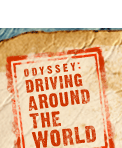December 24, 2003
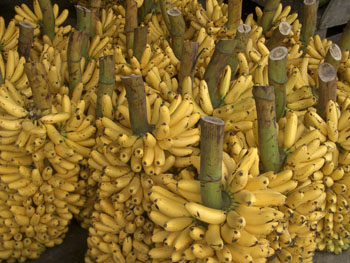
[Above: The goods at an Ecuadorian fruit market.]
It was quite a change going from Panama City to Quito, Ecuador. A change in weather accompanied the change in altitude. Instead of wearing shorts and short-sleeve shirts, I was donning jeans and long sleeves. Instead of being able to run quickly down the sidewalks I was breathing heavily just walking trying to accommodate to life at 9000 feet above sea level.
Christmas was in the air and members of the group were finishing their "Secret Santa" shopping as Chanda, Nick, and I were securing the fixings for a Christmas dinner. We secured permission to use the owner's kitchen and dishes, and we were ready to go. Turkey was on everyone's mind, but were turkeys available here? Yes, turkey is available, and we bought a whopping 25-pounder. The rest of the day consisted of gathering everything to go with the turkey. After establishing the menu -- turkey, stuffing, mashed potatoes, fruit salad, bread and desert -- the rest was about figuring out what was available to make these dishes and creatively coming up with substitutions, as we needed them.
Our first stop was the fruit market. This was a tiny little store run by short native women. The store was one room that was about 12-feet by 12-feet. Within it were a variety of bins lying on shelves that had fruit and vegetables in them. We bought 6 kilos of potatoes, onions, celery, berries, oranges, mangos, apples, radishes, a zucchini and a pineapple. After taking them back to the hostel, we were off again.
Next stop the grocery store. The store was mobbed, just like you would imagine the day before Christmas. As we drove our carts through the isles we picked up bags of milk, a pound of butter, wine, eggs, and many other items that would help us prepare a Christmas feast. The store was just like one that you would see in the States, with the minor exception being that there was a vendor selling rum and giving out free samples.
The meat counter had a whole host of different meats, including the traditional ones. From our British friend Jim, we got the idea of placing bacon upon the top of the turkey while we were baking it. Bacon was just one of the meats they had. We saw cow hearts, kidneys, livers, and tongues, just to name a few of the exotic things.
After finishing our shopping we brought our goodies home, but had to return the markets to find one last thing: a pan large enough to bake our turkey. Most things were open at 7:00 p.m., and the sidewalks were decked out with people selling wrapping paper, Santa hats, Christmas trees, lights, and fancy bags for holiday goodies. "White Christmas" and "Santa Claus is Coming to Town" were heard everywhere. We managed to secure our final purchases, and I guess we will leave it up to fate as to if we have everything we need.
Hungry and tired, Nancy, Nick, Chanda and I sauntered into a Texas BBQ restaurant for a Christmas Eve dinner. Nancy, the native Texan, was psyched, but nobody does it like it is done in Texas. Anyway, our bellies were full, and we headed home to await Santa's arrival and the fun of Christmas.
Todd
todd@drivearoundtheworld.com
Location: Quito Ecuador
Elevation: 2850 meters
Latitude: 12º 52.4' N
Longitude: 28º 45.0' E
Breakfast: Eggs, Coffee and cheese bread
Lunch: none
Dinner: Texas Chile
P.S. - Day Six without our vehicles. Everybody's on his own program here in Quito. This is good, old-fashioned R&R. Several team members ventured by bus to the Equator at Mitad del Mundo (Middle of the World). Others shopped for Christmas dinner fixin's. Happy Christmas Eve!(N.O.)
| Logbook for December 24th, Day 54 | ||
|
Start: Quito, Ecuador N: 00* 13.019' W: 78* 30.004'' |
Finish: Quito, Ecuador N: 00* 13.019' W: 78* 30.004'' |
Mileage: 000 |
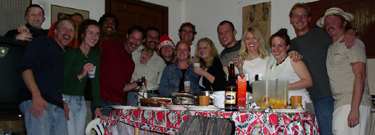
[Above: A panoramic shot of the Drive Around the World team and their Christmas dinner guests in Quito, Ecuador.]
As Nancy's journal [below] attests, the Drive Around the World team managed to have a great Christmas, despite being so far from home. Below is a collection of images from the experience. Each link clicks to a "pop-up" image of the picture described.
1. Justin, Rolf, Todd look on as Adam Burgess opens his Christmas gift in the living room of the El Taxo Hostel.
2. Chanda digs into her Christmas stocking.
3. Colin (a.k.a. "Corndog", a.k.a. "Santa") distributes gifts during the "Secret Santa" gift exchange.
4. Justin tears into his Secret Santa gift in the El Taxo living room.
5. Nancy enjoys her Christmas afternoon Ecuadorian style -- in a hammock!
6. Neil "Pancho Sanchez" models the dapper linen shirt from his Secret Santa.
7. In the hostel kitchen, Rolf helps whip up Christmas dinner.
8. Nick and Todd hard at work on the Christmas gravy.
9. Rolf looks on as Todd ponders his Secret Santa gift (an Isabelle Allende novel).
10. Christmas dinner is on the table!
December 25, 2003
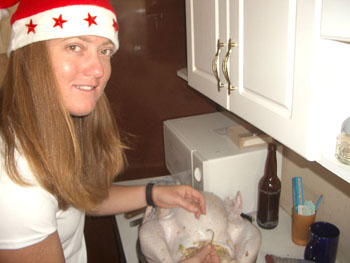
[Above: Nancy stuffs the Drive Around the World Christmas turkey in the kitchen of the Taxo Hostel in Quito, Ecuador.]
I went to sleep last night as visions of sugarplums danced in my head. When I awoke this morning to a "knock-knock-knock" at 9:30, it was to visions of television cameras and microphones wielded by Adam and Neil. Those meanies interrupted what I wanted most this Christmas morning -- good, solid, blissful sleep.
Whatever happened to the little girl who used to conspire with her older brother to sneak downstairs as early as possible -- sometimes even beating Santa himself to the punch -- to peek inside stockings and shake inconspicuous packages for a guess at their contents? Then we would plead with Mom until she gave us the go-ahead to get Christmas rolling with a traditional "hop on Pop." We'd run in and jump up and down on Dad's bed screaming "Hop on Pop! Hop on Pop!" until he agreed the hour was acceptably late enough to start opening presents. Man, those were the days.
Now, it seemed, I had turned into Pop, and Neil and Adam were a more civilized version of my brother and me. Huh. What a weird concept. Oh, but who am I fooling? I was almost giddy with excitement for this Christmas morning. I had a stocking full of gifts for each teammate, and one for my "Secret Santa" buddy. The main difference between Christmas as an adult and Christmas as a kid is that there is excitement in the receiving as the latter and immense pleasure in the giving as the former. Shucks, I hope that doesn't mean I'm finally growing up!
My team and I were staying in Quito, Ecuador, in a hostel called "El Taxo," and, as homesick as we all were for our families celebrating Christmas back home, we felt lucky to have each other, as well as some expatriates we had met in Quito.
I managed to get Neil and Adam to take there camera out of my tired and puffy morning face, and I lay in bed long enough to savor the last few minutes of sleepy comfort. The knowledge that we had a turkey to stuff, potatoes to mash, and stuffing to make is what actually got me out of my rack and into the shower. My replacement family and I would have a long day of Christmas cooking ahead of us.
Each of us had drawn a name out of a hat about a month ago, and we had a "Secret Santa" gift exchange planned. I had drawn Justin, and he had drawn Chanda. I bought him a linen shirt in Costa Rica that I was just dying to present to him, since he'd been looking for one every day for, like, well, since we left the U.S. I also got to help him pick out Chanda's gift, and I was as excited as he was to see if she'd be pleased with her new shoes -- a sort of high-heeled, platform, blue, super-hot sandal. (Just last night, as we walked past yet another shoe store, she squealed, "I hope my Secret Santa brings SHOES!")
Before the gift exchange could occur, we had to get the 28-pound turkey into the oven. Before the turkey could go into the oven, we had to stuff it. Before we could stuff it, we had to bake some breadcrumbs; cut the celery, onions, and garlic; and make the doggone stuffing. That was the job I opted for, because a turkey dinner just wasn't a turkey dinner without my mom's stuffing.
Todd expertly crumbed (my made-up word for "cut into small pieces") and broiled a loaf of white bread, and I added what I could remember Mom adding, and we came up with something suitable. Basically, it was breadcrumbs, a ton of celery and onions, some crushed garlic, a couple of eggs, and some chicken broth. We stuffed the pasty substance into the neck and the butt, and Nick and I, like surgeons, sewed it all shut with a fishing hook and some dental floss. Mom, you should be proud. What a job we did!
With the turkey finally in the oven, we got down to the business of opening gifts. (Actually, this is slightly out of order, but who's writing the journal here, anyway?) With Colin playing the role of "Head" Secret Santa, whose job it is to collect and hand out the gifts, we all took turns opening our present. Afterwards, we would all get to enter a secret guess as to who we thought our Santa was. We even had a little gift for one of our fellow hostel dwellers, Jim from the UK. We laughed and had a grand ole time until the last gift had been opened. It seems the best Christmases are the ones that involve simplicity, improvisation, loved ones, and laughter. So far, this was ranking right up there with some of the very best.
In the end, Chanda was in a new pair of H.A.B. (that acronym is for us to know and you to find out) shoes, two people were wearing new t-shirts, two were in fancy new Latin American dress shirts, three were in Panama hats, and Justin was in a new linen shirt which, as it turns out, was "big enough for a man, but made for a woman." (It seems I made a mistake at the fancy Italian store in Costa Rica yeah, the shirt's trendy style didn't just have to do with it being European )
Everybody was ultra-pleased with their gifts, and guessing who gave what to whom proved to be quite fun and challenging. We worked out a little scoring system: For a correct guess, the giver had to buy the guesser a soda for failing to be deceptive enough. For an incorrect guess, the guesser had to buy the giver a soda for being a successfully secret Santa. In the end, Neil got a free cola from Todd and Chanda, Adam got two from Nick, Todd got one from me, Rolf got two from Colin, Justin got one from me, and Chanda got one from Justin. Confused? No worries. Just know that I guessed wrong (my gift was from Todd) AND failed to fool Justin.
While the turkey cooked, we were each on our own to watch bootleg DVDs a few of us had purchased from street vendors for a dollar, nap, read, or goof around. Adam and I found an open Internet café, and I finally got to send the Christmas e-mail I'd been trying to send for two days (my webmail was down). Finally, at 6:00 p.m. (turkeys take longer to cook when you're at altitude, and Quito is at around 10,000 ft), we sat down to an absolutely amazing Christmas spread.
With the hostel owner (Peter) joining us, along with his employee (Jan), and with UK guest Jim, and two med students from the UK (Charlie and Jo, both gals) whom we had befriended our first night in town, and two of their fellow med students from the U.S., plus our team of nine, we had quite a large "family" with whom to enjoy the wonderful dinner we'd all helped to cook. We gorged ourselves silly on mashed potatoes, gravy, super-moist-and-delicious turkey, fruit salad, chutney (because we couldn't find cranberry sauce), cake (because Mom wasn't there to make her famous apple pie), rolls (because I didn't have Mom's monkey bread recipe), and, of course, my own rendition of Mom's delicious stuffing. Each team member had contributed to the preparation of a portion of our dinner, and, it was absolutely amazing. We truly enjoyed the fruits of our toils. (And at the end of the night, we all hit the town and partied like the rock stars that we are.)
I have to confess, this year, with the camaraderie of my teammates and our new friends, I experienced one of the most delicious, most joyful, most fulfilling Christmases I have ever spent away from home. What a Christmas!
Happy New Year to you all. Be safe.
Nancy
nancy@drivearoundtheworld.com
P.S. - Day Seven without our vehicles. Merry Christmas! The team celebrated Christmas Day American style, with a Secret Santa gift exchange and a full Christmas dinner with turkey, stuffing, mashed potatoes, and lots of friends. We were joined by our hostel owner from Switzerland, his assistants, and several British and American friends we met in the streets of Quito. This is an amazing Christmas away from home.(N.O.)
| Logbook for December 25th, Day 55 | ||
|
Start: Quito, Ecuador N: 00* 13.019' W: 78* 30.004'' |
Finish: Quito, Ecuador N: 00* 13.019' W: 78* 30.004'' |
Mileage: 000 |
December 26, 2003
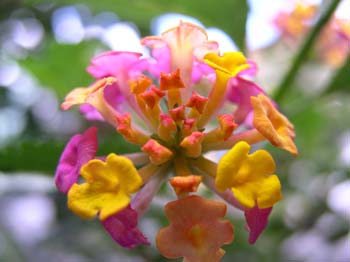
[Above: A macro shot of the flowers outside our Quito hostel, where Corndog took the whole post-Christmas day off to rest and watch some movies.]
The pace of the road is tough. It's hectic, nerve-wracking, and sometimes painful. Every once in a while I have to take what I call a "Colin-day". Colin-days help me to recuperate and maintain my mental health. Colin-days are centered around me, Colin, doing whatever it is that makes me happy. On this day, the thing that makes me happy is to sit around and watch movies.
The streets of Ecuador are filled with bootleggers. These people take movies and burn them onto a CD and sell them on the street for the ridiculously low price of a dollar. These people have any movie you want, including those that are still in the theatre. Today, I watched six of these movies: The Last Samurai, Timecop, The Target, Matrix Revolutions, Scarface, and one that I can't remember the name of that had James Spader in it. All day I sat around with my newly acquired English friend Jim and loafed. It was just what I needed to unwind, and also, for me at least, it's kind of a post-Christmas tradition to do nothing for a few days.
Now the pace will pick up again. We head out to pick up our cars in a few days, and once we have them we will constantly be on the move again. I'm sure however that there will be a few more Colin-days to be had.
Colin
colin@drivearoundtheworld.com
P.S. - Day Eight without our vehicles. Today was a day for sleeping in and doing whatever floats each individual's boat. Justin visited the old part of the city of Quito to explore the old cathedrals and museums. Nancy slept most of the day. (N.O.)
| Logbook for December 26th, Day 56 | ||
|
Start: Quito, Ecuador N: 00* 13.019' W: 78* 30.004'' |
Finish: Quito, Ecuador N: 00* 13.019' W: 78* 30.004'' |
Mileage: 000 |
December 27, 2003
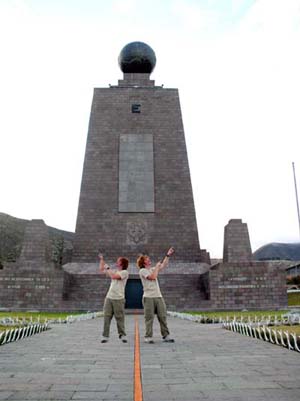
[Above: Thanks to the wonders of modern photo technology, Colin exists on both sides of the Ecuadorian equator at once.]
I believe travel is one of the greatest gifts a person can ever receive. When you are traveling, you are usually in control of your own destiny and destination. You can carefully research a destination before you set out or you can grab a globe, give it a spin, and let fortune lead you to new experiences. So, in one sense, travel is a gift where you know exactly what you will receive. Everybody likes to know exactly what he or she is getting at one point or another. On the other hand, travel is a gift that frequently surprises you. You never exactly know what you're going to get. This has been proven to me many times, from Paris this summer to Quito this winter. The reality of travel is that no matter how much research you perform before you leave, you will receive (more often than not) an equal amount of benefit from the unexpected and unplanned things that beset your way.
This week has been no different.
We have been staying in Quito, Ecuador at the Hostel El Taxo. It is a charming little place that has served as our base of operations for several days. The day before Christmas, the team planned to go to Mitad del Mundo, quite literally, the middle of the world. It's a small village that has the good fortune of being located directly on the equatorial line. After taking a bus for an hour and a half (it was supposed to take 40 minutes), we arrived. While we knew that we would be rewarded for our time with the opportunity to explore one of the geographical highlights of the world. But the unexpected part of the bus ride is that we were able to experience a normal Ecuadorian commute first-hand because the bus stopped every five minutes or so in a new neighborhood so people could muscle their way on or off the bus.
When we arrived at the monument (just a few minutes before 6 p.m.), we were stunned to see the gates were closed. What is this? Are you telling me the equator is closed? Nah, it can't be. Fortunately, it wasn't. A friendly guard showed us the way in and pointed us in the right direction. After a brief walk toward a collection of flags and a large obelisk surmounted by a globe lying on its side, we saw the equator. Or at least we saw the bright orange line that has been placed into the brick walkway through the entire village. I have to admit, it was very cool. Instantly, I was transported back to the 4th grade. I began hopping back and forth from one side to the other. I'm in the north, we're in the south the north, the south, the north, the south -- okay, who can I wrestle for control of the equator?
Finally, my excitement settled down and I was able to put that juvenile display behind me. I decided to follow the line into town to see where it went. Obviously, it goes east and west, but did you know that it actually goes into buildings in the town? No kidding! It even goes right into and down the middle of a small Catholic church. It goes right up to and behind the altar, and the cross hanging on the wall points directly down to the equator. So I began to wonder -- do you feel different receiving religion if you in the southern hemisphere vs. when you're sitting in the northern hemisphere part of the church? I don't know, and unfortunately, I can't find out. There's no service scheduled for today. This line goes everywhere. It even goes across the stage of the amphitheatre in the plaza. No part of the town we spared. With my need to stand on the equator fulfilled, and one last dance from side to side, I loaded back onto a bus bound for Quito. We returned "home" and went out for Indian food for dinner -- kind of a refreshing change from our normal diet of rice, beans, and meat. Plus, it was cheap. One dollar a plate, and that included soda. Now, you only got one small piece of meat for your dollar, but combined with the rice and beans it was pretty filling. We sat out on the sidewalk, and some children begging for money approached us. Instead of turning them away or simply handing over a dollar or two, we asked them if they were hungry. "Of course," they responded, so we bought these children some dinner. It can be tough seeing kids so young begging on the streets. Obviously, you can't give to all of them, but when an opportunity like this comes up, you just have to help. We started by feeding two kids, but they went and grabbed their brothers and sisters. By the time we had finished our dinner we had fed 5 children. They were so excited and gracious that it was overwhelming. It's nice to be able to help like that. Random acts of kindness are definitely some of the unplanned benefits from the gift of travel.
Later I ventured down to the Teatro Aeropuerto to catch a traditional Ecuadorian ballet. Now, what I had envisioned in my western mind didn't compare to what I actually witnessed. I'm not going to say it was bad, but I'm not overly persuaded to call it good, either. Instead, I'll call it interesting. It was a collection of traditional Ecuadorian dances, some of which date back to the time when the Spaniards first came to Ecuador. The costumes were incredibly colorful, much like a Carnivale celebration. However, the choreography was pretty rough, and you could tell that many of the dancers would rather have been somewhere else. I'm not sure whether it was worth the fifteen-dollar admission, but it was an experience unlike any other.
Now, as I sit in the twilight of this holiday season, I reflect on this journey and the gift of travel that I have received. And I smile. This expedition has showered me with opportunities to experience some of the best things the world has to offer. More importantly though, it has helped me look beyond my perceptions of travel and of life to really soak in the reality of our world as it unfolds before me. Until next time, I wish you all well from the far side of the world.
Justin
Justin@drivearoundtheworld.com
Day Nine without our vehicles. Today the team rested, played, and tended to program matters. Nancy went on a mountain biking excursion to Mt. Cotopaxi, the world's highest active volcano. It was strange visiting a mountain that so many of my friends have climbed, only to drive up it and zip down on a mountain bike. Ah, but it was fun. Next time, I climb it. Tomorrow we leave for Guayaquil. (N.O.)
| Logbook for December 27th, Day 57 | ||
|
Start: Quito, Ecuador N: 00* 13.019' W: 78* 30.004'' |
Finish: Quito, Ecuador N: 00* 13.019' W: 78* 30.004'' |
Mileage: 000 |
December 29, 2003
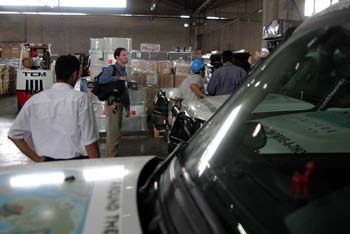
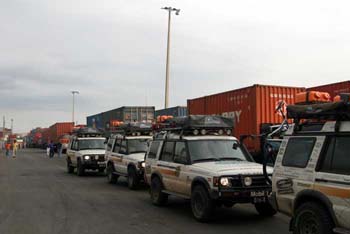
[Above: Nick hard at work at the shipping warehouse in Guayaquil, Ecuador; the Land Rovers unloaded and ready to go at the docks.]
Nick, our fearless expedition leader, is amazing! He has the ability to push and push and push and push and push and push without feeling pushy. And I mean this in the most kind-hearted way, too -- he doesn't push us around, or any of his friends. What I am talking about is when we are dealing with foreign customs and borders and officials who we deal with very often. He said it quite simply the other day when we were in our freight forwarder's office, "I am bad cop and you are good cop, Neil."
For example, we arrived here in Guayaquil, where our vehicles were shipped from Panama and we have been dealing with getting them out of the port the last few days. Nick and I took a taxi from our hotel early in the morning, and when we got in the taxi, he told us it was $10 to get to the port. Isabelle, the women who owns the hostel where we are staying at told us it should be six. So Nick tells the taxi driver that we will pay him six dollars, but the taxi driver keeps on saying that it is ten and it will take an hour to get to the port. The driver told us to go and ask another taxi driver if we wanted, it will be the same price. Nick finally opened the door and got out and we went and got another taxi, which cost us $3, and only took 15 minutes. We both are not sure whether the taxi driver was completely lying to us, or was truly mistaken and thought it would take an hour. It seemed a bit ridiculous.
So fifteen minutes later we arrived at Malecon, which is an area of Guayaquil that is located along the river that opens to the ocean. It is a nice area that has brick walkways and shops and restaurants and cafes. It is kind of like a mall on the water, but not as mundane as a mall. We entered a building and took the elevator to the eighth floor. This building is where the freight forwarding company was located. Willaneus Willhelmsen is our shipping sponsor, and they have set up freight forwarders for us in our ports. These are companies that have people there to handle all the paperwork for us and walk us through the steps. And at these ports where our vehicles are getting loaded and unloaded, they are extremely helpful. We could do it on our own, but it would literally take many days more to get out our vehicles. The process makes a normal border crossing with four vehicles seem like a simple handshake.
So we entered our freight forwarder's office and went and sat down in the office of our representative, who was a very nice woman. Before we had entered, Nick told me we needed to make sure they knew how critical it is to get our vehicles out of the port right away, and to make sure we don't pay too much for the whole process. The problem we were facing is that our vehicles arrived in port on the 24th, and the port was closed then and on the 25th and 26th and so on. We ended up going there on the 29th, and in a perfect world, the freight forwarder, knowing weeks in advance that we were going to be there and our vehicles were already there, should have already started the offloading process and paperwork. But obviously, South America or anywhere for that matter is not a perfect world. The only perfect world is inside my head.
The woman asked us for all our papers, which include our passports, vehicle titles, notarized letters of driver permission, our carnet, entry papers for Ecuador, exit papers from Panama, and a few others as well. Now that she had the papers, she could call customs and start the process. However, customs has to get permission from Trinity, the shipping company, to offload the containers, and Trinity needs permission from Customs as well, and the dock people have to be coordinated as well. So it is a big circle and roundabout that can really start anywhere, as long as someone finally pressed the "GO" button and initializes the process.
Nick kept telling the women that we needed these cars today, which obviously wasn't going to happen, but if we keep pushing for today, maybe there is a chance we can get them in 2 days from then. She told us we would be lucky if they would even offload the containers that afternoon, which she highly doubted. We were also nervous, because if we didn't get the vehicles by the 30th, we would have to wait until the 3rd or 4th to get our vehicles, because as of the 31st, everything in Ecuador shuts down for 5 days. Nick kept pushing and telling her how important it is to get our vehicles. I love how Nick uses a process of deduction to get our victims to understand that they CAN do it. Usually someone says they can't start the process because customs needs the word from the port. Well, who at the port gives the word to customs? And who gives the word to the port to start the process? Oh, and who gives that person the papers or the call to start it, oh YOU DO? Wow, I am glad you finally figured it out. So by the end of our conversation, our victim understands her empowerment.
The trick, where our good cop and bad cop come into play, is making the victim like us at the same time. Nick being the person who is strictly business and getting the process done gets it done. However, during this process, I am looking around the room, noticing our women's pictures of her children on the desk, and then I pry into her personal life and get her excited about telling us about her family, and where she is from, and all the familiar things in her life that she loves and bring her happiness, other than another day dealing with people in the office. So by the time we are out of there, the lady knows we mean business, but that we also are good blokes and she even likes us! And if they like us, then they will actually pick up the phone and get the process started.
After we left the office, we walked around town a bit, got a really tasty cappuccino and latte and bought some $1 DVD's and I bought a long-sleeve Ecuadorian Seleccion Futbol team shirt, for the Andean mountains that lie ahead. We need to start gathering clothes for the cold days ahead. The markets here are great, extremely busy and chaotic. It is quite an enjoyable experience.
The next morning we awoke at 8AM and grabbed a taxi to the office, then met another person who took us in another taxi, another 20 minutes away to the actual Guayaquil Maritimo Port. This was a bustling port, with people walking around all over the place, and trucks and boats filling the roads and waterway, along with containers as far as the eye could see. It is quite amazing to think of all the millions of dollars in merchandise that passes through the port all the time. And also, the amount of stuff that does not get inspected, there is no way to inspect everything thoroughly, it is a bit scary to think about.
So we got to the port and met three people who were helping us with the process. The main guy, Jorge from Customs, was our man who helped us from beginning to end. And what a nice guy he was. So we entered into the first office to get our papers signed off, which basically were just papers to allow us to enter to port. Then we got in his truck, I sat in the open bed, and drove into the port. Jorge drove us around in circles to different locations and we sat in the car most of the time while he ran in and dealt with paperwork, and also handed off some papers to other people to expedite things as well.
Then we finally actually found one of our containers. We were excited and nervous at the same time. This was the moment when we got to see our cars, but also to see whether or not they arrived unscathed or not. We were also nervous, because when the vehicles left Panama, they did not have proper locks on the containers and we were worried about it. So when the container finally opened, there were our vehicles, what a sight!! Not a scratch. They were intact and everything was inside. The only strange thing was that one of the windows had slid all the way down, but nothing was taken out of the car, so it must have just been some sort of malfunction.
So we drove them out of the container and parked them to get inspected. We found the other container, and the little security tag that was on it was broken, so we were even more nervous, but I guess it was broken because they were preparing to unload the previous afternoon, when we showed up late. Anyway, they opened it and our cars were fine and we parked them inside this huge building or warehouse with all the other merchandise that must be inspected by customs.
We had to wait about 3 hours until they were ready to be inspected, so we ended up meeting Jorge's family, which was a highlight of our trip. Jorge's wife was extremely eager to meet us and came to the port to hang out with us. Her mother has Parkinson's Disease and when she heard the day before from Jorge what our organization was doing, she was excited to meet us. So during part of our waiting process, we were in their van and Nick her talked about Parkinson's for a while. It is amazing the amount of information we have about Parkinson's in the U.S. versus what they know here in Ecuador.
We ended up going to Jorge's house and meeting his mother in law. She was a very beautiful woman who had Parkinson's and was shaking the entire time we were with her. It was not a severe shaking, but it was there in her hands and you could notice it. They brought us cherries and strawberries and introduced us to their whole family, the children, brother, uncle, etc. They were all honored to be in our presence, as I was theirs. We talked for about an hour about Parkinson's and the medicine's and information that we knew. Nick is extremely informed and has read Dr. Langston's book and Michael J. Fox's, as well as many others. It was really sad to listen to this family and realize that the mother was taking quite a bit of dopamine, which is a drug that is useful to allow patients to control their movements. The downside is that it only works for a certain amount of time, then your body builds up a resistance to it, and reverts back to an even worse condition than before, where you have uncontrolled movements. And the fact that this woman was taking heavy doses of dopamine, made me really sad. It is really hard to watch someone who has a terrible disease. I have always been blessed with good health, as has my family. My grandmother did have Alzheimer's, but at least she forgot everything. Parkinson's is worse, because you lose control of your body movement, or can't even move at all, but you are completely conscious the entire time. You are trapped inside your body and can't control it. I cannot imagine. I guess if you are in that situation, you learn to deal with it, like any situation in life, but also like in life, it is impossible to completely empathize with someone else's situation unless you really have experienced similar conditions. So meeting this women was extremely painful for me, but at the same time, I am grateful for it and it warms my heart to know that she is loved by her family and lives with her family, and that people are actively doing something to try and cure this disease. Parkinson's is horrific.
The fantastic fact about Parkinson's is that scientists know where in the brain it occurs, how to probe at it, and how it works, and lastly, the main key to finding a cure, is how to cause it. The only thing missing is more money to help the scientists develop the cure. Parkinson's scientists have many ideas that have yet to be tried yet, and the only thing holding them back is money to get the resources to experiment. With cancer and AIDS, there is more money, but not as many ideas that haven't been tried. Many grant proposals that have been written for research about cancer and AIDS are denied because they have already been tried. Parkinson's is the opposite -- there are more ideas than there is money to support.
Anyway, Jorge's family went with us to one of the greatest lunches we have had this trip. We ate coconut shrimp and fish and fish stew, with guayaba juice. It was delicious! We were there for a couple of hours. This restaurant was filled with local Ecuadorians and now we know why, mmmn, mmmnnnn.
After lunch, we went back to the port and met with the inspector who checked our vehicles. This inspector opened one door of one car, and looked at all our Red Bull drinks and asked if it was liquor. We had just received another batch of Red Bull in Panama, so our vehicles were stuffed with it. He didn't check in the back of the vehicle or any other vehicle, which was fantastic. In fact, when we were pulling out of the port, another official asked us about baggage, and Jorge just said, oh it's nothing, just camping gear, etc. They had even asked if we had electrical equipment, and Jorge winked at me and nodded, so I said "NO." Then Jorge grabbed the papers out of his hands and laughed and patted him on the back and hurried up the process even more. It is like a buddy system, with trust going to those the officials know. It is very advantageous for us and those who can pay for this type of help.
On the other hand, it makes you realize how easy it is to smuggle things into a country.
So all in all, it took us one day less to receive our cars than we thought when we first enquired with our friendly lady at our freight forwarder, we were stoked!! And now we are chilling in Guayaquil for New Year's and that is just awesome!
So all of you reading this, I hope you realize how important our expedition is, not only for raising money for Parkinson's, but everyday, we are meeting people that we have a positive influence on and vice versa. I know that we gave an extreme amount of hope to Jorge's family and that alone has made this trip worthwhile for me. One of the things that Jorge had said about his mother, was that she didn't have much hope left, and knowing that we revitalized that and gave them some information that they did not know previous to our visit is wonderful. We also wrote down the names of a few books that would be extremely informative to them as well.
You never know when you are going to meet someone unexpected or experience something fantastic. I mean, on a port day, our most dreaded days of days, ended up being one of the most memorable days of the trip.
Happy New Year!
Neil
neil@drivearoundtheworld.com
P.S. - (December 28th) Day Ten without our vehicles. Today the team took a 1030 a.m. bus from Quito to Guayaquil. It was an 8-hour ride. The guy behind Justin and Nancy puked. All-in-all, though, it was a good trip. The view out the window was intoxicatingly beautiful. The only downside is that we are back in the heat and humidity again. I sure miss the altitude of Quito. (N.O.)
P.P.S. - (December 29) Day Eleven without our vehicles. Nick spent today at the port of Guayaquil, but to no avail. He couldn't spring the vehicles due to some extensive shipping company and customs procedures. We'll return tomorrow to try again (N.O.)
| Logbook for December 28th, Day 58 | ||
|
Start: Quito, Ecuador N: 00* 13.019' W: 78* 30.004'' |
Finish: Guayaquil, Ecuador N: 02* 08.171' W: 79* 54.397'' |
Mileage: Lots of bus miles... |
| Logbook for December 29th, Day 59 | ||
|
Start: Guayaquil, Ecuador N: 00* 13.019' W: 78* 30.004'' |
Finish: Guayaquil, Ecuador N: 02* 08.171' W: 79* 54.397'' |
Mileage: 000 |
December 30, 2003
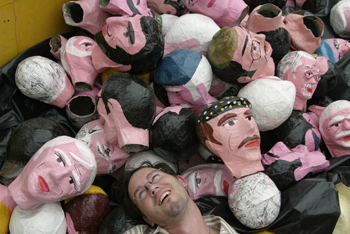
[Above: Effigy heads for sale on the streets of Guayaquil, Ecuador (can you see which one belongs to Nick?). These effigies are burned on New Year's Eve as part of an annual out-with-the-old/in-with-the-new ritual in Ecuador.]
We arrived in Guayaquil on the 28th of December and ended up in a little hostel on the outskirts of town. Neil and I were the first to arrive other than Rolf, who set up the rendezvous. On Christmas Neil and I decided to leave the dinner party at the Quito hostel and take an overnight bus for 11 hours to the little beach town of Monteñita. Although the waves were small and crowded it was a pleasant little town totally full of happy hippies and local vacationers. Gringos galore were selling handmade necklaces as though it were the hottest new item from Paris. The dirt roads and bamboo-thatched huts lit up at night, revealing what seemed like an adult theme park of Robinson Crusoe. The beards and dreadlocks ran rampantly as did the children, birds and dogs. Dirt roads and tiki torches added to the "Survivor" effect. The natty and sun-damaged Europeans boogied in Birkenstocks in the dirt streets and the trio of fire jugglers seemed to keep timing, but were better at discreetly picking up the dropped torches. It was quite a circus, and everyone seemed pretty happy with what they were all accomplishing -- which in essence was a delusional sense of integration, because as you walk 3 minutes to the edge of the village you discover the quiet little plaza and church façade nestled peacefully in between the houses of local fishermen. We left two days later for a bus to Guayaquil to meet the crew and the cars.
Driving into this city proves to reveal just another large, dirty third world city. Without iconic architecture like Paris or London this place, like many of these large Latin American cities, beckons you to experience the chaos through the eyes of a native. And so that's just what we have the opportunity to do. It just so happened that Rolf's hostel selection was 3 minutes walking from a friend's wife's house. And it also just so happened that Matt and Fabiola were back in Guayaquil for the holidays. I'm going to film Fabiola as she explains to Neil the crazy ceremony that's brewing daily here. Tomorrow is New Year's Eve and the city is supposed to blow up into a chaotic ceremony of burning effigies of international political figures and Marvel comic characters. According to our hostel manager, everyone throughout the city will drag these large and colorful papier-mâché characters out into the streets for an intense simultaneous midnight burning. Fireworks and dynamite will be packed into some of them before being doused in gasoline. It's supposed to be intense and so dangerous that they may stop it in two years or so. The crew has decided to take part by building what looks like a massive bunch of grapes but is going to represent the symbolic destruction of Parkinson's Disease.
This all sounds exciting to most of us, but I have one other thing on my mind -- sickness. I am fighting a fever and diarrhea. I'm blaming this illness on the Chinese food I had the first night here. Surrounding me at this moment are the essentials: six bottles of Gatorade and water, this laptop, and a few DVDs. Muddy footprints now mark my half-hourly route to one of two toilets in the hall outside my room. My guts wrench and churn from my every movement and gulp of liquid. It doesn't help that today's diet was white rice and chicken's feet soup. My ghastly noises blasting from behind the bathroom door day and night has replaced my voice, so that any dignity that may have existed beforehand has been lost. Relieving myself is hardly that at all, in fact "relieving" is a misnomer; it's an uncomfortable necessity. There's nothing left inside me and I'm at the point where if this continues I feel as though my intestines will come out next, along with my stomach, lungs, heart, throat and grimacing head, only to leave me turned completely inside out and writhing on the tiled floor like some mutated creature from a sci-fi film.
I hope tomorrow is better, but right now I've got business to attend to.
Adam
adam@drivearoundtheworld.com
P.S. - On the twelvth day without our vehicles, we got 'em back. Today the team successfully sprung the vehicles from the Guayaquil shipping yard. It was exciting being back in convoy again, and it was fun turning heads as team Drive Around the World. We missed our babies! This evening, we made a team decision to remain in Guayaquil for the New Year's festivities before heading on to Peru. (N.O.)
| Logbook for December 30th, Day 60 | ||
|
Start: Guayaquil, Ecuador N: 02* 08.171' W: 79* 54.397'' |
Finish: Guayaquil, Ecuador N: 02* 08.171' W: 79* 54.397'' |
Mileage: 026 |
December 31, 2003
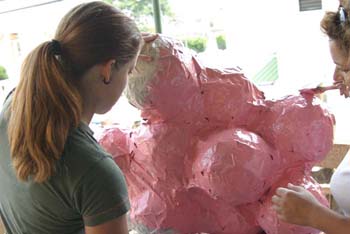
[Above: Nancy and Isabelle build an effigy to represent Parkinson's Disease, which the Drive Around the World team ceremonially burned at midnight on New Year's Eve.]
New Years Eve! Still more work needs to be done! It has been difficult to distinguish work from playtime. There is always something to do and there are a couple things that are just short of a crisis situation at any given time. However, a good breakfast is a great way to start any day. A number of us sat down together for breakfast at the Dreamkapture Hostel in Guayaquil, Adam seemed healthier than I had seen him in awhile, so that was good. .
After breakfast we all assumed various posts around the hotel. I took a spot on the couch next to Neil, and began to answer questions and review stuff that I had been writing about Ecuador. I though to myself this is New Years Eve, and what am I doing? I have been driving around the world and what have I spend my time doing? I thought I should hit the city, but really didn't know what I wanted to do. My mind was preoccupied with my work, but it was demanding a reprieve at the same time. I guess I wanted to find someone to do something with, but then again I didn't want to hang out with everyone. Uffda!
I found my way into the library and looked at a few magazines, most in different languages and fell asleep. I don't know how long I was asleep, but after I awoke I just laid there on my bench and thought. My thoughts flowed like goldfish swimming in a fishbowl, everything from my family, home, team members, goals of the expedition, workload, and what I wanted to do upon my return. It centered me, but my mind seemed preoccupied with a lot of different things.
I finally roused myself, and the banging in my stomach finally got my attention. I stole away to my room, not really feeling like talking to anybody. I just wanted to change my clothes and leave on a walk, I didn't want anybody to inquire about what I was doing; I just wanted to leave.
I strolled through the streets and watched people as they moved about their business. New Years was definitely in the air, as people had already started drinking and burning effigies, an Ecuadorian tradition. You see life-size replications of real people and fictional characters: the Incredible Hulk, Saddam Hussein, George Bush, as well as local politicians. Apparently, it was out with the old and brings on the new. Ecuadorians burn the remnants of the previous year hoping the New Year will bring something better. These life size structures are loaded with firecrackers and burned during the New Years celebration.
The Drive Around the World, team in the spirit of this tradition, had built -- and was planning on burning -- a lumpy pink model that represented Parkinson's Disease. It took awhile, but we hoped it would focus the team on our Parkinson's mission.
Walking the mid afternoon streets of Guayaquil, I stumbled into a stereo/music shop. I went to the guitar wall and, being fueled by melancholy, I picked one up. There was a couple shopping for a guitar, so I tested a few for them. My mind was so occupied with introverted thoughts, making my Spanish choppy and unnatural. I really didn't care; I just was basking in my melancholic torpor. The interaction lifted my spirits, however, and my hunger again took hold.
I eyed a McDonalds, which seemed perfect, simple, familiar the perfect antidote for my blues. I walked toward it but I heard Nick's voice in my head, "If you don't agree with McDonald business mission why do you patronize them?" Ugh, was I going to have to stand firm to my principles? I have trouble with the idea of giving my money to a huge corporation that will take the profits away from a country that already very poor. A local business could probably use my money more than McDonalds could. However, I wanted the impersonalness and anonymity of McDonalds. I really didn't want to interact with anybody; McDonalds was perfect, but I just couldn't go in. Eventually I did find a restaurant, a local one, no less, and I sat on the street watching people getting drunk and burning things. It was a lot of fun just watching.
I returned to the hotel and met Rolf, who was headed to upload journals from the previous week. He said he needed some help in talking with an Internet café so that he could plug his laptop in directly. We headed off amidst firecrackers popping and the random smoke clouds throughout the city. We found an Internet café and established his connection. I noticed that the guy running it was using Linux. Since I used to work with Linux I asked him some questions. Before, I knew it I was configuring Samba for him. We had to troubleshoot a bunch of stuff, and 5 hours later I was walking out the door a bit cross-eyed. We didn't quite get it to be like we wanted it, but we were well on our way. We exchanged e-mail addresses and I will probably be in communication with him.
When I returned to the hotel at 9:00 p.m. everyone was there. Everyone was sitting around waiting for dinner, even our newly found friends Katie and Dave that were visiting from San Francisco. Isabelle, the hotel owner, had made dinner for us. It was a great dinner, of chicken, raviolis and salad. She said it was her treat as she admired what we were doing. She is great person. If you ever find yourself in Guayaquail go to Dreamkapture Hostel and say hello from the Drive Around the World team.
The night aged and everyone was eager to get to the burning -- and before the night was through, we had acquired four different effigies to burn. At a quarter to twelve, the team headed down to the street to burn away 2003.
The city erupted in sound, smoke and life. It sounded like a war zone, and looked like one as well. Everywhere you looked the streets were on fire. Mounds of 2003 were disappearing under the flames. Looking each direction up and down any given street you would see at least 5 roaring effigies and bonfires. Wow!
Despite all this, I couldn't let me melancholy go. It seemed to be gripping me by my throat preventing me from jumping up and down and bidding farewell to 2003. I managed to squeeze off a few smiles before retiring to my bunk. Perhaps there is something in it that I am not yet ready to let go.
Todd
todd@drivearoundtheworld.com
Breakfast: Eggs, Toast and Coffee
Lunch: Chicken and Rice
Dinner: Chicken, raviolis, and salad (with feta cheese).
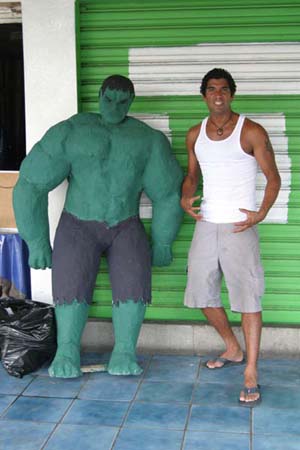
[Above: Neil poses with an effigy of the Incredible Hulk.]
P.S. - The team celebrated New Year´s Eve Guayaquil style. We participated in their tradition of burning effigies to dispose of bad luck and to bring good fortune for the coming year. We said goodbye to the old and hello to the new. Tomorrow we head to Peru. (N.O.)
| Logbook for December 31st, Day 61 | ||
|
Start: Guayaquil, Ecuador N: 02* 08.171' W: 79* 54.397'' |
Finish: Guayaquil, Ecuador N: 02* 08.171' W: 79* 54.397'' |
Mileage: 000 |
January 01, 2004
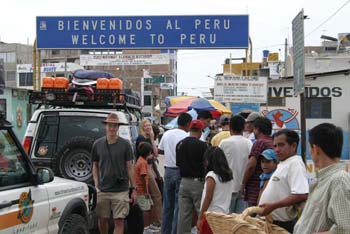
[Above: Justin and Chanda waiting with the Land Rovers to enter Peru.]
The Peru I visited in August of 1999 seemed somehow different than the Peru than I am seeing now, and the circumstances, too, were as different as night and day. In August of '99, I was wrapping up 5 years of active duty time with the U.S. Marine Corps, and I was taking a little trip before starting a civilian job. I was dating a boy who liked to climb mountains, and he and I and his two brothers and a roommate decided try to tackle a mountain called Huascaran in the Cordilleras Blancas in the Peruvian Andes. We flew into Lima and hired a sketchy little station wagon with frighteningly bald tires to drive us to Huaraz, which is the access town for the mountain range we wanted to climb. Well, we never reached the top of that mountain because of terribly dangerous avalanche conditions -- and my relationship (or whatever) with the boy went the way of the avalanches -- but my memories of the beautiful countryside and the even more beautiful people made that expedition a great memory. Lima wasn't much to write home about, but the small mountain villages sure were. I've been wanting to return ever since.
The thinking and analyzing that was required to write that first paragraph have caused me to realize that the circumstances of that first trip weren't quite as different as I let on, I suppose. I mean, I'm on another expedition with friends, after all, and I just wrapped up another active duty stint with the USMC, but there are some stark contrasts. For starters, I am a lot older and a little wiser than I was the first time I saw Peru at the age of 25/26. In addition, thanks to Land Rover, we don't have to hire sketchy taxis, and our BF Goodrich tires are as knobby, safe, and trustworthy as they come. I don't have a stitch of climbing gear with me, which is pretty torturous to withstand, but I do have a Santa Cruz Blur mountain bike along to help fill the void. I don't have a hankering to date any of my traveling companions, although I do feel right kindly toward each one. It feels kind of weird being in South America, home of Mt. Cotopaxi, Mt. Huascaran, Mt. Aconcagua, and Patagonia, without any possibility of a climb, but I'm coping well enough. I can always treat this as a recon for when I return with climbing gear. So, I guess it's the mission itself that makes this expedition so different from the last. It's that, and it's my experience base. That first visit to Peru was really my first adventure travel, other than what I'd experienced with the Marine Corps. I have since traveled around the world once with the Land Rover G4 Challenge and throughout the wilderness of Canada, Alaska, and Virginia for some expedition-length adventure races. I guess I just feel more seasoned, less naïve, and more in-charge.
We spent New Year's Eve in Guayaquil, where the heat and humidity made it impossible to sleep well at night. In Guayaquil, they have a tradition of making "viejos" (Viejo, in Spanish, means "old."), or giant paper-mache figures which are bombed and torched to represent bidding farewell to the old and welcoming the new. We had built a big pink monster to represent Parkinson's Disease, and we blew it to kingdom-come. Much of my crew was feeling pretty groggy after staying up too late celebrating the New Year, but we managed to hit the road by 9:00 a.m. Today is Border Day.
We entered Peru through the border city of Tumbas at about 5:00 p.m. and bee-lined it across deserty plains and along the coast toward the beach where we'd spend the night. We had driven through flat, flat, flat country, and I wondered where the mountains were. Way off to my left, I guess. I had never conceived of visiting Peru's beaches, since I only think of mountains when Peru's name is mentioned, but there we were. It's in such stark contrast with the steep cliffs and snow-capped peaks of my memory bank.
It was an easy 4-hour drive from Guayaquil to the Ecuador/Peru border, and then it was another 2.5 hours to cross into Peru. We reached the border at 2:30. It was the easiest border crossing on our record. Peru's aduana, or customs office, consisted of one small building, three medium-sized desks, and one little customs man. Our border-helper-kid suggested we give the man a Coke or some money to speed up the process, so we gave him a cold Red Bull from our ARB car fridge. He was pretty stoked, though he tried to hide it. These guys like to be all official and in-charge, so they try to look stern and authoritative. Anyhow, we got all the Land Rovers registered, stamped, and tagged, and I even got a smile out of the stern little aduana before we got on the road again.
As we headed toward the beach city of Mancora, we passed a jailhouse, and Colin came on the radio to announce that the film guys were listening to Johnny Cash's "Folsom Prison" album. Rolf and Justin said that they were already listening to the Johnny Cash "Sun Years" album in D4. That inspired Nick and Chanda to put in a Johnny Cash album, and then of course, I popped in his "San Quintin" cassette, so Todd and I could enjoy ole' Johnny, too. So, as the sun set, every single vehicle in this Drive Around the World convoy was rocking out to Johnny Cash. We discussed the super-coolness of that over a chicken-house dinner and then resumed the Johnnyfest caravan to Mancora. That was one of our little tributes to a great man who, by the way, suffered from Parkinson's Disease.
We pulled into the thriving tourist hot-spot of Mancora at about 8:30, talked to a few beachgoers visiting from Mexico, observed a dozen or more gringo tourists, and found the last room in the whole city still available during the busy holiday season. It had three bunk beds, so three people were without racks. I popped the Hannibal expedition tent on D3 to revel in the privacy of my comfy rooftop bedroom, and Nick and Chanda slept above D1. It would have been a perfect night sleep except for the loud party music and the fact that I had a nightmare about forgetting to hand in a final exam, one other nightmare that I can't quite remember, and my wicked imagination convincing me that I was being eaten alive by bugs. It's the third night in a row that I've thought bugs were crawling on me
Well, tomorrow we drive. We're heading toward Cuzco, which means mountains, so I'm pleased. Talk to you next Thursday. I hope the imaginary bugs go away
Nancy
nancy@drivearoundtheworld.com
P.S. - The team left the sauna-like temperatures of Ecuador for the drier heat of Peru. It is about 5 degrees cooler here. The border crossing at Huaquillas took only 2.5 hours, a record-fast crossing for the expedition. The team is experiencing its first illnesses, with 5 members battling a cold. (N.O.)
| Logbook for January 1st, Day 62 | ||
|
Start: Guayaquil, Ecuador, 0945 N: 02* 08.171' W: 79* 54.397'' |
Finish: Mancora, Peru, 2030 N: 04* 06.543' W: 81* 03.571'' |
Mileage: 228 |
January 03, 2004
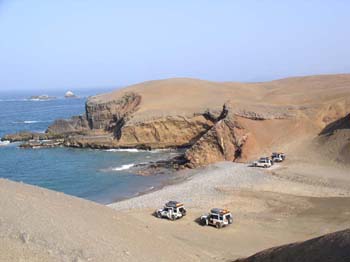
[Above: Four Drive Around the World Land Rovers are parked for the night along the desert landscape of the Peruvian coast south of Huarmey.]
Sometimes when you're traveling, you find yourself stuck in the middle of nowhere. Today is the 64th day of the Longitude Expedition. Our route today takes us from Puerto Chicama on the western coast down near Lima, the capital city. We are in the middle of a long series of driving days through Peru in order to explore the town of Cuzco and then proceed over to the majestic pyramids in Machu Picchu. Peru is an interesting country for a number of reasons. First, it is the 3rd largest country in South America, and it is roughly twice the size of the state of Texas. Second, it is contained entirely within the tropics. Third, I've seen sights here that were absent in other countries. And the last reason is that Peru is nothing like I had imagined.
We are driving through the desert. That's right, the desert. Never mind the fact that as I just mentioned Peru is located entirely in the tropics, and every mental image you have of the tropics makes you think of thick rain forests filled with vines and sweat and wild animals that you can only see in the zoo or on TV. There's no doubt about it, we're in the middle of the desert. This barren, parched stretch of earth is smashed down right in between the Andes Mountains and some of the most beautiful coastline in the world. And it feels like the middle of nowhere. This stretch of desert is so barren and yet visually captivating; Rolf compared to both the Gobi Desert in Mongolia and the Libyan Desert in western Egypt.
We started this morning with a film excursion through part of the desert down to a beautiful little beach tucked into a cove. The morning air was salty and the sky was a hazy blue. Two tanned fishermen were wading into the water with nets trying to make their catch for the day. In the distance, there were two-dozen boats jockeying for the best fishing position in the bay. We were tempted to remain here for a while, but as we watched the men loading up their fish into nets they had attached to a pole for carrying the fish into town, we were reminded that we had a long day ahead of us, too.
We stopped for a quick breakfast right inside the town of Puerto Chicama. It was the usual fare for this part of the country: runny fried eggs, plain white rice, a smattering of grayish-brown beans, and a piece or two from a yucca tree. While desayuno (breakfast) was being prepared, I went for a walk around the block. The town itself is a dirty, reportedly high-crime area visited by both native and foreign tourists alike to experience the beach and what is reported as the world's longest left-break for surfing fanatics. However, my impression is that it is primarily a fishing town and that more tourists visit the centro turista of Mancora to the north. It could also be that the waves were only about 4 inches high today.
For the most part, I found Puerto Chicama very representative of most of the small towns in Peru. The houses are small and very modest. They are built with cinderblock or thatch walls, even mud occasionally, and they have tin or reed-like roofs. While there are beaches fairly near these towns, most of the inhabitants don't have transportation available to them, except for bicycles, taxis, or buses. From what I can tell, most buses don't go to the beach, a taxi to the beach would probably be too expensive, and it's just not very feasible to put the whole family on a bicycle to go to the beach, although I believe many Peruvians may try on a nice enough day.
We are without a doubt in the middle of nowhere. So I think.
But over one half of Peru's 27 million inhabitants live in this narrow stretch of desert in the middle of nowhere. That's roughly equal to the population of California or Canada. This band of sand dunes and rocky hills that I perceived as uninhabitable also contains Peru's three major cities. I suppose it's no different than living in parts of Arizona, Nevada, or New Mexico, but when your mental image of a country is so different from what you encounter, it takes the brain a while to adjust.
While I waiting for breakfast to be served, I sat down on the side of the road and I began to ponder the concept of "the middle of nowhere" For many of these people in most of these towns, this is all they have ever known. They may or may not have dreams of travel or a different life, but the reality is for most of these people, this is not "nowhere," this is home. Generations of Peruvians will be born, grow up, work, live, love, marry, grow old, and die here. From the cheerful woman selling fresh bread; to the dark-skinned, leathery-faced, wrinkled old woman walking along-side the road carrying a bundle of sticks that must weigh 4 times her body weight; to the myriad of young and old men who drive three-wheeled motorcycle taxis like kamikaze pilots -- this place that I would call the middle of nowhere is their entire world.
And you know what? They all seem pretty happy about it, too. As we pull through towns, Peruvians whistle and wave at us, genuinely pleased to see us driving by. As we stop to get gas or eat a meal, everyone asks questions and gives us a thumbs-up to our expedition. I finished my breakfast and decided to spend more time thinking about this.
We continued with the day's drive and the sights of Peru constantly whizzed by me: first, the small wooden crosses along the side of the road marking memories of loved ones. Then, old trucks loaded to three times their height with branches -- the beds of all of them looking ready to burst at the seams as they slowly moved along their daily routine of climbing hills and belching exhaust fumes. Then, a unique sight along the road interrupted my thoughts. I had read in one of our Lonely Planet guidebooks that it is a common sight in Peru to see men urinating in public. In fact, it's not that strange for women to urinate in public. To be perfectly frank, along the highways, we have even found it necessary at times to pull over on the side of the road to let nature take its course. However, we were driving behind one of the three-wheeled motorcycle taxis when we noticed that its passenger needed to relieve himself -- while it continued on its way down the road. I guess when you have to go, you have to go.
Our day ended on a beach south of the coastal town of Huarmey. As I hiked around searching for sea urchins, starfish, shells, and investigating the bones of dead animals, my thoughts returned to my morning musings. Perhaps it's just our lack of perspective or first-hand experience that prevents us from seeing past what's right in front of our faces. "This isn't the middle of nowhere," I thought as the sun slipped beyond the horizon. This is the middle of everywhere. So, the next time you find yourself thinking, "Man, I am really in the middle of nowhere," take a minute to ask yourself, "Is that really the case?"
Justin
Justin@drivearoundtheworld.com
P.S. - (January 02) The team continued south through Peru, crossing the Desierto de Sechura. The scenery is amazing. Just when I thought we were running out of sand, Peru pulled through with the mother-load! The team continues to battle cold-flu symptoms. Neil is pretty bad off, with a fever of 101.9 F. He can hardly move, poor guy. We made a pit stop in a random town today to witness the random site of lions in a cage. They were on their way to a circus. (N.O.)
P.P.S. - (January 03) The team did a photo shoot with the desert as a backdrop and then explored down a dirt road to some awesome beach areas near their hostel in Puerto Chicama. Nancy had time for a run AND a bike ride. The views of the ocean with the desert cliffs in the backfground were amazing. We continued south through the huge country of Peru, past the historic city of Chan Chan and past the Moche Pyramids. At about 4:30, Nick surprised us by knocking off early to find a suitable place to camp on the beach. This was the best campsite of the trip, and this was the best bike riding area of the entire expedition. I rode my Santa Cruz up and down super-steep dunes with my hair on fire. I'm feeling sick with a headache and stomachache (N.O.)
| Logbook for January 2nd, Day 63 | ||
|
Start: Mancora, Peru, 0700 N: 04* 06.543' W: 81* 03.571'' |
Finish: Puerto Chicama, Peru, 2015 N: 07* 42.276' W: 79* 26.627'' |
Mileage: 327 |
| Logbook for January 3rd, Day 64 | ||
|
Start: Puerto Chicama, Peru, 0815 N: 07* 42.276' W: 79* 26.627'' |
Finish: South of Huarmey, Peru, 1700 N: 10* 20.036' W: 78* 03.265'' |
Mileage: 220 |
January 05, 2004
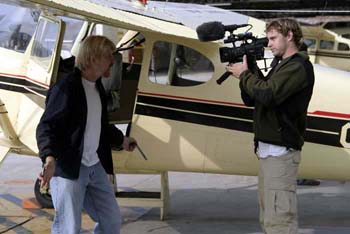
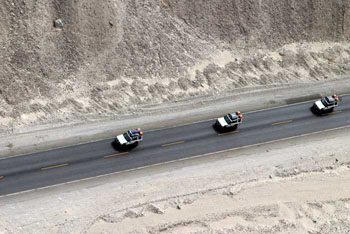
[Above: Adam Burgess films as Todd prepares to enter the Cessna airplane that took them over the lines of Nazca; below, an aerial view of the DATW Land Rovers near the Nazca Lines.]
It's not everyday you get to feel your cheeks swish from side to side and open your eyes wide as your stomach tries to escape, up and out of your body! Well, maybe if you are a crab on Isla Grande. But for us humans, riding in a 1952, 4-seater, 170 Cessna airplane, zooming around tight turns looking at figures etched into the earth while you are completely sideways in a plane, is quite a feeling!!
We are in Nazca, a town in Peru, which got its name from the Nazcan culture, which pre-existed the Incas by a thousand years or so. The Nazcans were around from 300 BC to about 700 AD. What they left behind is still a mystery to everyone around. They are called the Nazca Lines. And these are no ordinary lines! These are lines that were etched into the desert floor here a couple thousand years ago and still remain in tact to this day. These lines are spread throughout the area, and comprise different figures, some of which are a mile in radius.
The Nazcans dug about 60cm deep into the ground, to form these designs. Some of the designs, which can only be recognized from air, are a monkey, a condor, an alien etched in a mountainside, a snake, a spider, and many other interesting and significant drawings. Imagine seeing a monkey etched into the ground from thousands of feet in the air, and it still looks huge from there! It is truly mind-boggling.
And what makes it really mind boggling about the phenomenon that everyday, these strange winds come into the valley, and in a circular, almost tornado like fashion, they swoop up into the air and away, any debris or dust that would cover up the designs. For thousands of years, thousands......these figures have remained etched into the Peruvian landscape. Why?
Well, the answer to that has many different theories, but no concrete solution. It is still a mystery. In fact it is still a mystery as to how they did it, and why they did it, or if they did it, maybe aliens did it? How could they figure out the correct angles and lengths and dimensions if they couldn't see the figures from the sky? Maybe they could see it from the sky -- there are some theories that they were able to create some sort of hot air balloon to see them! They have found evidence that supported that argument as well. But why? To say hi to aliens, to pray to their gods, or because they were bored, or what? Many scientists have tackled this one, yet no one knows.
Todd, our team member seemed to come up with the most reasonable solution to the beginning of the mystery.......how did they figure out the lines etched into the ground would last forever? Hmmm. Well, of course, any normal person would understand that it was due to a woman! Some heartbroken guy must have been devastated and etched his ex-girlfriend's name or face in the ground, and of course, when he was cruising around 50 years later with his wife and kids, and stumbled across a perfect image of his ex-girlfriend, he must have been horrified! But at the same time, bewildered, he must have shared this information with the King -- and hence, the immense project of developing the Nazca Lines. There can be no other solution. Thank you Todd.
So anyway, enough of mysteries and histories, how about our day! Adam, Todd, and I ended up in a small plane, the Cessna described earlier, piloted by Stephen, also a surfer and avid motorcycle rider, so riding around in his plane was a blast.
Nick, Chanda, and Colin came with us as well in our vehicles. We had a mission to accomplish this morning. Not only were we going to see the Nazca Lines, we were also going to get some aerial footage on video and camera of our expedition vehicles. So those three needed to drive the vehicles out onto a road and coordinate timing with us as we zoomed in from above and filmed them out in the desert.
It was quite a ride. With the side window taken off the plane, our cheeks never held the same shape the entire voyage, especially when trying to poke our heads out with a camera! We looked like dogs cruising around in the passenger window of cars, and as wide-eyed and happy too! We ended up flying for 35 minutes and seeing some of the Nazca Lines and filming our vehicles. Our communication with the vehicles from the air was a bit of a mess, with all the static and interference: "psshshshshsshpshsh HERE WE COME spspsshspspshshpshs FASTER pshddsfsfsfh sfshfhshhhsssshd hfhdhfshdhfshhfdf TURN AROUND pshshsspshs phphsshshhssp shspshpshshs..." -- that was about all that was understood! Fortunately, it was all that was needed, and we accomplished our goals. It was a sunny and beautiful morning, and we were done by around 9:15 a.m.
I remember the time well because our team is very sick right now and we needed to get back to the hotel and rest. I just got finished with a 102 degree fever, and a left hand that literally was in extreme pain and couldn't be used for a day, however now I am feeling better, just a nasty cough won't go away. And now Chanda and Nancy are sick too, in fact, Nancy has a higher fever than me, so she is really feeling awful right now, poor thing. Todd is the only one on our team who did not get sick in the last week. Hmmmm. Maybe that is why he knows the mystery of the Nazcans, and doesn't get sick? Yep, I thought so, Todd is an alien.
So here I am, sitting in a small restaurant in Nazca, with the occasional child staring at my computer in amazement, writing this journal, drinking tea. I just woke up from sleeping a few hours, and figured, since we have designated this day to rest, I might as well get this log online today! Now how is that for live updates. You have to thank Rolf for that, he is the man!!! [Editor's note: No, Neil, you the man for writing this so fast!]
Tomorrow, we head towards Cusco, and wow, that is going to be fantastic! The Incan ruins are the most spiritual and amazing sights and places I have ever visited in my life. Yes, I have been here before, in fact I have flown to see the Nazca Lines before, not like today though. But I am excited to go back to Machu Picchu and many of the other amazing historical wonders that await our eager souls.
Neil
neil@drivearoundtheworld.com
More photos here!
(click on each link for a "pop-up" photo)
Under the wing of the airplane, Drive Around the World vehicles drive across the Peruvian desert.
A huge "alien" design on the desert floor near Nazca, as viewed from the Cessna.
A sky view of DATW vehicles in the dramatic desert valleys of coastal Peru.
A giant "hands" symbol carved into the Nazca desert.
For an idea of scale, see the DATW Land Rovers drive past the "hands" symbol in the desert.
P.S. - (January 04) Team continued through Peru toward Nazca. Along the way, we visited Pisca to sample Peru´s National Drink, a tequila-like brew made from fermented grapes and named after the town. Nancy is sick with fever and headache. (N.O.)
P.P.S. - (January 05) Nancy has a headache and a fever of 102.3, and Chanda, too, is very sick. The team has decided to remain at the comfortable hostel to encourage them to get well. Healthy teammembers chartered plane rides to get an areal view of the mysterious Nazca Lines, and other teammembers drove the vehicles near them for a photo shoot. So far, this vicious virus has attacked 8 team members. Nancy is the winner for the highest temperature. (N.O.)
| Logbook for January 4th, Day 65 | ||
|
Start: South of Huarmey, Peru, 0800 N: 10* 20.036' W: 78* 03.265'' |
Finish: Nazca, Peru, 2130 N: 14* 49.752' W: 74* 56.542'' |
Mileage: 407 |
| Logbook for January 5th, Day 66 | ||
|
Start: Nazca, Peru, 0645 N: 14* 49.752' W: 74* 56.542'' |
Finish: Nazca, Peru, 1800 N: 14* 49.752' W: 74* 56.542'' |
Mileage: 050 |
January 06, 2004
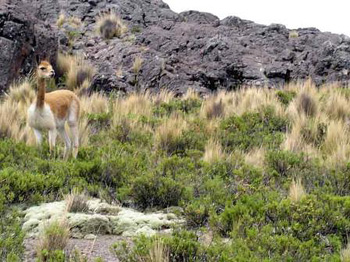
[Above: A llama-like vicuna in the pampas wilderness as we drove into the Andes.]
We came into Peru on New Years Day, which offered a surprisingly easy border crossing. The roads and streets were rather quiet and the border was tranquilo. I was pretty damaged that night so going out to party wasn't really an option. After taking a dose of CIPRO, the wonder drug of all drugs, it cleared up my guts by the next day. Now it seems that the rest of the crew has been attacked by some form of heavy flu; Neil was barely audible, shivering like a wet rat and going numb in the hands yesterday, apparently I've been immune because of the CIPRO. He seems better today, so its not typhoid or some other crazy jungle disease. Northern Peru is desert spotted with little cube houses of handmade sand colored bricks sometimes covered with a roof of either woven reed, adobe mud or -- sometimes -- no roof at all. It seems incredibly poor here, and people have little more than the occasional chicken, few goats and a pleasant demeanor. The sand dunes rise to the left and right of the highway with mountains of sand in the distance. It reminds me of images of the moon, or the Sahara. Our destination is Cusco, to see Macchu Picchu, and we decided to take this bleak road instead of the beautiful mountain roads to the east in order to make up time.
Yesterday was one of those days where very little happened but we accomplished a lot. The day before we spent in Nazca to see the Nazca Lines. Over a thousand years ago, someone drew massive images of monkeys, trapezoids, spiders and an alien. Massive is an understatement, as some figures are hundreds of meters in size. It's a big mystery as to why and how they drew these images only visible from the sky in the desert soil. I'd try to explain them, but you really have to see for yourself. Before I knew it Neil and I were off to investigate for ourselves. The 1952 motor sputtered a few times and then warmed up a little, crammed shoulder to shoulder like a British sports car, four of us were motoring down the runway in the classic Cessna. I was determined to get some aerial footage of the images combined with the Land Rovers in convoy, so we hired a pilot to take us up. I had the pilot remove the passenger window so I'd be able to shove the camera out at 70mph but as I leaned out the hole as we buzzed down the runway I realized that the consequence would come from the two black oversized kazoos attached to the side of the plane just in front of the window. Exhaust pipes, loud. I was so busy filming Neil squashed in the back seat introducing the camera to what we were doing that I failed to notice we were already 90 feet off the ground. I'm so used to the minute-long rocket launch of jumbo jets that floating up in 10 seconds felt effortless. We buzzed up pretty high and there they were all across the desert for as far as the eye could see, the Nazca Lines. Archeologist Maria Raiche spent her entire life analyzing them, caring for them and offering theories of origin. For decades she swept them with a broom, she went through hundreds of brooms in her lifetime before she recently died of Parkinson's in her 80's. It was no surprise then when the pilot appeared confused that I showed little interest in flying circles around the images and insisted that he follow the three white Land Rovers driving in convoy on the nearby Pan-American Highway. As I leaned out the window the rush of wind sucked my contacts out, filled my eye sockets with air and my left cheek inflated. This carried on for a while as we crisscrossed the highway for 15 minutes. I managed to get a few good shots of the crew driving down below and then we headed back.
A sense of guilt sometimes smothers me as we travel. I wonder what I did to deserve the position behind the wheel of a $40,000 car instead of that of the man farming small cactus plants on a rocky plot next to the highway or the woman weaving sheets of thatch in the desert outskirts of Lima. We just pop out anywhere in this world and make the best of it; I suppose that's what I did to get myself behind the wheel, and that's what they are doing in the dunes where it never rains. But the eyes continue to stare as 4 identical cars barrel through their little village or homestead. Some wave with excitement; others are stopped in their tracks; but one smile and a thumbs-up gets the crowd going. Almost immediately the children are jumping around and the woman weaving thatch breaks out into a sun-damaged smile. Their smiles only add to my guilt and I begin to wonder why so many people are obsessed with repeated participation in driving expeditions. I've come up with one possibility. We are addicted to the immediate celebrity status it appears to offer. Instant fans line the road calling out in excitement, yelling "Ingleterra!" or "Camel Trophy!" often confusing us with Brits or Germans. Months of this special treatment is something we've never experienced at home.
So we kept driving east towards Cuzco. In 2 hours we climbed from an altitude of 1500 feet to 15,000. The cars pushed rather effortlessly up into the Andes, offering a drastic change in climate. As we crested the range, the GPS dithered between 14,900 and 15,000 feet. There was little up there but shrubs and funky little llama-like creatures, called vicunas. We filmed them for a bit and they shrieked out and scrambled off into the chaparral.
The altitude has definitely had an effect on us. Breathing is a new challenge; you feel it up here, climb a few steps or run to set up a tripod and your panting like a smoker. To make it worse. I have a blocked nose that at times makes me feel like I'll suffocate at any given moment.
As I've told everyone a hundred times, losing my sense of smell in a car accident 10 years ago has changed my life for the better, and driving to Cuzco proved this once again. Altitude and other ailments left Colin with a case of sulfurous burps. In our vehicle, Colin belched constantly, and Neil would scream out in disgust. Apparently they carried the stench of rotten eggs and could be smelled outside from 12 feet away. Other than that not a lot happened -- just long hours of driving through beautiful highlands.
P.S. - Nancy and Chanda are still fairly out of commission, but without fever. The team traveled along mountainous switchbacks to inland Peru and crossed the Altiplano. Peak elevation for the day was just over 15,000 feet. The team saw local wildlife, including vicuñas and flamingos. The temperature at that altitude dropped to a low of 38 degrees F. Driving was slow and winding, but really, really fun. (N.O.)
| Logbook for December 6th, Day 67 | ||
|
Start: Nazca, Peru, 1000 N: 14* 49.752' W: 74* 56.542'' |
Finish: Chalhuanca, Peru, 2000 N: 14* 17.704' W: 73* 14.860'' |
Mileage: 195 |
January 07, 2004

[Above: An Andean llama!]
It wasn't an early wakeup call this morning. Although we had 660km to go before reaching Cuzco we had a number of team members that were quite sick. Nancy, in her competitive way had broken the fever record producing a new record of 102°F the day before. She woke only to drink some broth and fall back asleep. Chanda was part of the competition as well only peaking out just short of the record, and for the most part the rest of the team was either recovering or trying to come down with something, I sure hope my healthy streak holds out.
Anyway we got up as early as we thought was necessary, but as late as we could get away with, we finally had breakfast, packed up and were rolling out about 9:30 or 10:00am.
I loved the town of Nazca and it was a nice respite from the hard driving we had been doing for the past 3 days. It seemed to be a friendly town that hadn't been jaded by its famous monuments nearby. The desert was amazing. I asked a couple of people along the way, what this Peruvian desert was called and most people looked at me strange. I thought it was my Spanish until I tried to look up this Peruvian desert in Encarta. I found one small article referencing the Sechura desert. The article had less to with the desert than with securing oil rights around it, hmmm. Everything I looked at described the boundaries of this place, but never really told me much about it. I was confused. I looked up the definition of a desert and found the following: Desert, term applied to regions of the earth that are characterized by less than 254 mm (10 in) of annual rainfall, an evaporation rate that exceeds precipitation, and, in most cases, a high average temperature. When I looked up Peru I found reference to a coastal plain that extended the length of the country varying in width from 40 to 100 miles. I also found that this region was an extension of the Atacama Desert in Chile, however, when is a desert a desert and when is it an extension? I guess I will have to do more work to solve this riddle, but it is kind of fun being confused like this. When I return I think I will look at geographical programs, as I am tremendously interested in this subject.
Anyway, as I mentioned earlier we hit the road. The roads snaked around through the dry canyons, rocks and sandy dirt, but not much plant life. We installed our new radios yesterday, so this canyon was a perfect place to try them. We had been used to our little hand held mobile radios, which were adequate for convoying, but very little else. They didn't work over long distances, and it was sometimes very hard to hear what was being said. We were excited to see the range of the new ones, Nick said they would transmit over 5 miles, but I was the Doubting Thomas. Nancy and I pulled over to truly test the distance these radios would cover; we waited as the rest of the team went on ahead. As the minutes rolled by we talked to Nick and Chanda. Soon, two minutes turned into 6 minutes and the radios were perfectly clear. After 10 minutes of waiting, and still a perfectly clear signal, we decided to roll rather than check the maximum distance, besides we were in a canyon so our results would have been skewed anyway. These were cool radios, thanks to Day Wireless in San Jose.
We continued to snake our way up through the front of the Andes, up, up we traveled winding through more canyons. We climbed over 13,000ft; we drove into some precipitation and experienced a major vegetation change. We drove by a river, which is something we hadn't seen in couple of days as well. Apparently on the west side of Peru there are 52 rivers heading west from the Andes mountains, however, due to the dryness of these mountains only 10 of these reach the Pacific ocean without drying up. Now over the summit we saw a lot of short grass, small brush, and an occasional tree. However, this leads me to another question. The trees I saw were mostly Eucalyptus trees, which are exotics, and I saw a few conifers as well. All of these trees seemed like they were introduced, so I wondered what the native tree life was like here. Was this area massively deforested, or did very few trees grow here? At what elevation is tree line? Another question of mine that remains unanswered, I will get to the bottom of it soon.
We pulled into the small town of Puquio for gas; at this point we were about 13,500ft. I was concerned at the altitude and the fact the people were not feeling well. If we continued on would we have to stay at a higher altitude? People can climb the 10,000ft in a day without too much problem, just headaches and shortness of breathe, but anything beyond that was a gamble. We had a lot of bronchial problems that would complicate any altitude adjustment. Cuzco was about 11,500ft but the Andes stood in our way and they were known for their height.
We tried to gain some insight from maps, but didn't find very good information. We knew there were towns between here and Cuzco, but would they be at a lower elevation?
Local knowledge suggested the next town 200km away along windy roads was lower in elevation. We like to trust local knowledge, but often times these people had never been out their communities, and besides elevation would not be an issue to them, so why would they know about it?
The decision was made to get lunch in the town and drive on. We arrived at a restaurant just as a downpour commenced. After eating our fish, chicken, or soup we headed out in the rain. The drive continued to be beautiful as we drove at about 14,000 ft. With our new radios Nick, Chanda, Nancy and I played 20 questions and joked and talked as we rolled down the road. It was almost like we were all in the same car. It reminded us of being back at the office where we would banter back in forth. That reminds me to send a special thank you to Minitool, who provided us with the office. Without their help we would not have made it this far. As we travel we do think about the many people that have helped us along the way!
As we drove in and out of the clouds we actually saw flamingos fishing in a pond. Apparently flamingos color changes based on their diet, as these flamingos are white and the ones on the coast are pink, apparently form eating shrimp.
Darkness set in as we hit the peak and began to descend. I was relieved to see our altimeter slowly ticking down. It reached 9500 ft just before we pulled into our stopping point of Chaluanca. Only a couple of us made it up for dinner, as tomorrow was going to be an early day and many people had to rest.
The whole team is coughing, but nobody has a fever, for now. The team continued across the Altoplano and completed their first crossing of the Andes. We are looking forward to exploring Cusco and exploring Machu Pichu. Before we can play, though, we have several days of work ahead of us here in Cusco. We are taking photos and writing testimonials for each of our sponsors. When we are finished with this critical task, we will play. The city of Cusco is the most beautiful we have visited. At an altitude of more than 11,000 feet, it's also the highest. The people with virus-affected lungs are finding it difficult to breath. That will get better with time as we acclimatize. (N.O.)
| Logbook for January 7th, Day 68 | ||
|
Start: Chalhuanca, Peru, 0800 N: 14* 17.704' W: 73* 14.860'' |
Finish: Cusco, Peru, 1700 N: 13* 31.017' W: 71* 58.835'' |
Mileage: 179 |
January 08, 2004
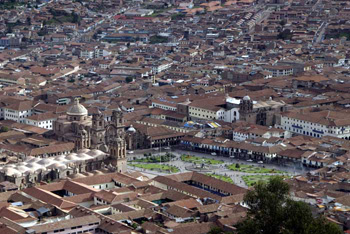
[Above: A bird's-eye view of the lovely city of Cusco]
We spent all day today diligently writing testimonials for each of our sponsors. We're here in the beautiful city of Cusco, an oasis of sorts in my mind, surrounded by the mud of the tail end of Peru's rainy season.
We drove in yesterday from Hostel Zuchara in Samborja, seemingly so remote and simple as to be completely disassociated from anything as modern as public transportation, HBO, and indoor plumbing. But as we were driving through this indescribably beautiful countryside, earthen dwellings suddenly shot up all around us, the mud houses becoming increasingly close together and the streets more and more well-groomed until we found ourselves in the middle of a town square sequestered amongst brilliant Spanish architecture in the form of a Cathedral, a government building, shops, and the Plaza de las Armas. It looks like a classical European scene, straight out of the glossy pages of the "Our World" resource book I cherished so much as a kid.
I cannot believe the size and beauty of this Peruvian gem. I would love to explore it, but there's the task of preparing sponsorship deliverables looming, and that takes precedence. To say we're holed up would be a bit misleading, for we're actually reclining in the luxury of one of Cusco's finest hotels, the Royal Inka. For the first time during the expedition, we have treated ourselves to fancy accommodations. The Hotel Royal Inka has given us a generously discounted rate of $40 per night, and we are three to a room. The staff is all smiles and hellos, and the rooms, including the bathrooms, are sparklingly clean. What I was missing most about home was toilet seats, warm water, and sanitary bathrooms, and we have been blessed with each here in Cusco. With the amount of work we have to do for our sponsorship project, and considering the importance of this task, it is only logical that we be comfortable. The room money, as always, comes out of the $10K we have each contributed to Drive Around the World and the LONGITUDE Expedition.
We are each divided into three teams of three, and each team is responsible for 20 sponsors. Team Two, consisting of Chanda, Justin, and Adam, nicknamed themselves the Flat Puppies; Team One of Rolf, Todd, and Colin, named themselves the Condors; and Team Three of Neil, Nick, and me are called the Pumas. Something about having a team name makes our work a little more fun. I spent all day writing three testimonials each for WARN, Rover Accessories, Extreme Outback, Bauer Vehicle Gear, Red Bull, Santa Cruz Mountain Bikes, and Sport Kilt, while the rest of the team worked on their respective sponsors. By dinnertime, most of the team had completed their writing assignments. Of course, being long-winded, I was one of the few who still hadn't finished. I went to dinner anyway knowing that tomorrow will be another writing day.
Cusco is chock-full of inexpensive places to eat, and, like I said, the city is beautiful, but there is one detractor from its "enjoyability." Cusco, and Peru in general, really, is home to tens of thousands of little kids, women, and teenagers selling everything from postcards, to shoe shines, to finger puppets, to silver jewelry. As soon as a tourist steps foot outside of his or her hotel, restaurant, or favorite club, he or she is swarmed by these relentless entrepreneurs. If I were the president of a company who employed salespeople, I would fly to Peru to hire these kids. They're closers. They follow you around using every trick in the book to sell you one of their trinkets until you either give in, promise to buy later, or rudely ignore them.
"Mees, mees, where you from?"
"Los Estados Unidos."
"Capitol Washington, President, Boosh. You want to buy a postcard? I have very good price for you."
"I already have ten postcards."
"You don't have these. These very deeferent."
"No, thanks."
"Ok, maybe you want one of my puppets."
"I have 38 of those. Seriously. All your friends have all of my money."
"Buy one more from me. These are very deferent. You don't have these one. You need pig."
"I have the pig. I have ALL of them. You want to buy one? I'll give you a very good price."
Silence, and then, "You want me shine you shoes?"
"I'm wearing flip-flops."
"Come on, mees, for my lunch."
"We're through. Bye-bye."
"Mees! Please!"
Ugh! It is heartbreaking, but these kids will break you if you keep buying from them. And when you don't buy from them or give them money, they call you and your mother every dirty word in the book. I have to continually remind myself that they are just kids, that this is the only life they know, and they are just trying to make a living. I'm so tired of denying little kids that I can hardly stand it. The street hustling is a huge problem and a huge detriment to Cusco and Peru in general. But Peru is still my favorite country so far. The people are friendly and interesting, warm and embracing. The countryside is endless green fields, livestock, mud-brick farmhouses, and mountains. I could live here for a year, no problem, but then I'd have to come home to my beloved U.S. of A.
Catch ya'll later. I'm spent.
Nancy
Nancy@drivearoundtheworld.com
The whole team is busy producing sponsorship deliverables. It's a daunting task, because it is ultra-important. We are preparing testimonials to send back to our 60 sponsors in order to update them on our status and to thank them for the use of their products and services. Bootsnall, who publishes this blog, is just one of the many great organizations that makes our expedition possible, and we want to pay back a little. If you like reading our journals, then let's hear it for Bootsnall! The weather here is beautiful. Cool and beautiful. This is a rare occassion in which we are actually staying in a swank hotel. We're very comfortably holed up in the Royal Inka, one of Cusco's finest hotels. They cut us a sweet deal on rooms. (N.O.)
| Logbook for January 8th, Day 69 | ||
|
Start: Cusco, Peru
N: 13* 31.017' W: 71* 58.835'' |
Finish: Cusco, Peru
N: 13* 31.017' W: 71* 58.835'' |
Mileage: Rest Day |
January 09, 2004
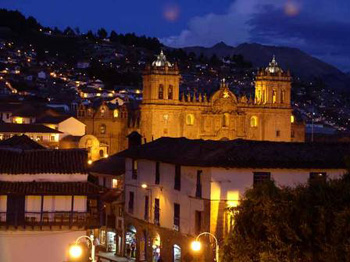
[Above: Central Cusco at night.]
Well, we're still here in Cuzco, and I must say I love this city. There's a strange spark to it that really gets me going. I've definitely seen my share of the nightlife here, but truthfully, I haven't really been out of six-block radius of our hotel and haven't done a tourisitic thing during the day because we've been working so hard on sponsorship stuff, but I look forward to my "dia libre" or freedom day when I can spend some time exploring the place. And of course, there's the famous Machu Picchu ruins which I have to visit. Looking forward to it, but also not, only because I know it will be mobbed with tourists and even I am sort of a tourist myself, seeing others of the sort at archeological places kind of ruins it for me. I'd like to feel like I just stumbled on these places in the jungle, but that just isn't going to happen on this trip. Anyway, we have to make a decision weather or not to go to Bolivia soon, and I'm kind of pushing against it because the country goes on strike and riots very soon and if we got caught in the middle of that it could be a bit peligroso (dangerous) although, it would make for great film. Personally, I'd rather head up to the Amazon and check it out. I love the jungle, moist air, never a silent moment, birds, bugs, cats, sloths, you name it.
Anyhow, back to the nightlife. I'm slowly learning to become a slightly better dancer, enjoying meringue, but not quite at the salsa level yet. Dancing here is so much more important than in America. Every Latin American person dances, twirls, spins, dips. Gringos are easy to spot on the dance floor goofily bouncing and shuffling around. I imagine myself being included in the group. Occasionally one or two will blend in properly, but the majority don't have it. Must be the Latin soul, born of rhythm and passion, or something like that. Before this journey I never really cared for dancing too much, the problem oftentimes being that I can't dance to music I don't like, now I really want to improve, not necessarily my bouncing around hip-hop bumpin' and grinding type stuff, but the graceful spinning and whatnot of the Latin dances. I think it comes from watching this one couple dance, I mean, they had a whole dance club mesmerized. spinning, twirling, flipping, you name it. The girl, tossed about like so many rag-dolls, continuously spinning, no awkward shuffling. That couple really danced. Now, I'm not saying I'm devoting my life to dancing, nor am I going to take classes or any of that, I'm just going to try a little harder. There's plenty of Latin America left and that means that I'll get plenty of practice. Not to mention the fact that dancing is a great way to meet girls. Anyway, time to head over for some work.
Colin
colin@drivearoundtheworld.com
Today we finished writing sponsorship testimonials and washed vehicles. Tomorrow we will shoot more than 480 photos to send to our various sponsors. It will be a busy day. When we are finished with the sponsorship tasks, we'll figure out our next adventure. While here in Cusco, we want to see Machu Pichu, and I'd like to do a bike tour. You can do anything here, from canopy tours, to river rafting, to city tours, to horseback riding. Cusco has it all. What a wonderful city. (N.O.)
| Logbook for January 9th, Day 70 | ||
|
Start: Cusco, Peru N: 13* 31.017' W: 71* 58.835'' |
Finish: Cusco, Peru N: 13* 31.017' W: 71* 58.835'' |
Mileage: 000 |
January 10, 2004
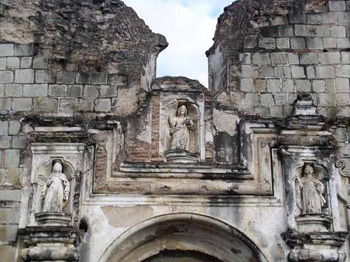
[Above: Statues in the old colonial city wall of Cusco, where we were based while taking sponsor photos in the surrounding countrside.]
Do you ever spend time wondering about how you are perceived by others around you? If you're like me, chances are you do. First impressions can often swing the balance of an encounter from being a good experience or a bad one. There are many times and situations on the expedition that make me sit back and wonder how the people we interact with feel about our presence in their country. While it is true that we are traveling the world for 9 months with a balance of altruism and exploration, at the end of the day we always have an equal potential to be perceived as an ugly 9-headed American monster rolling into town as we do a friendly group of volunteers that are trying to broaden our horizons and make new friends. It is a fulltime job balancing curiosity and exploration with intrusion and perceived mayhem.
Who are we in the eyes of the people we meet? This is always a good question, but one that doesn't always have a good answer
The last few days of the expedition have been spent in Cusco, Peru tending to our business responsibilities, including maintaining our sponsor relationships. Today we are loading up the team to scout out a photo shoot location to take advantage of the incredible scenery around Cusco and Machu Picchu. Our goals are simple-find a location and shoot as many photos as we can. As we drove out of Cusco, we came back to a long valley full of small buildings, farms, and lush green pastures. Quite simply, one of the most breathtaking sights we've seen so far. We found a small road leading toward a cluster of buildings on a local farm, and we pulled up to the main building to ask the farmer if it was all right for us to use a small section of his land for our photos. As he approached the lead car, he had an expression of curiosity mixed with confusion. By the time he walked far enough to see all four Land Rovers lined up, his expression changed to complete and utter bewilderment. Neil, our best Spanish speaker, leaned out of the rear window of his vehicle, introduced himself, and began to explain the situation to the man. The man, very polite and friendly, said he was pleased to meet us, but apologized that he didn't feel his land would work for our purposes. Apparently, the short stretch of land we drove across to talk to him was about the only area accessible for photos. He recommended that we continue to the northeast to a road that would lead us further into the valley and to an area that he assured us was much more beautiful than his patch of land.
Excited by this suggestion, we headed back out to the road and continued on our way. While we never found the exact road the farmer mentioned, we did find another road that took us off toward a small village and a tiny plateau that was perfect for our needs. As we completed setting up the vehicles and gear for the photos, a few people approached us from the village, including a diminutive old man, who was very friendly and greeted us each with a hug and kind words. Our understanding was that this was his land, and he was happy to let us use it for photo purposes. As all this was going on, a small crowd of people from the village walked over and sat down on a ridge to witness the gringos locos (crazy gringos) who rolled into town. For the record, none of us really knew what the old man said or even what language he was speaking. We know it wasn't Spanish or Quechan, and the other villagers laughed to themselves as he made the rounds hugging us. I think he was drunk. Regardless, as a village elder, we paid him the utmost respect. And I don't want to give you the wrong impression-he was a hell of a nice man. He probably had no idea what we were saying to him and probably not much of an idea as to what we were doing on his land, but he welcomed us with open arms-literally.
As we began to take our photos, the crowd continued to grow, now including approximately a dozen adults and nearly twice as many kids-all sitting on the ridge, quietly observing us in their natural habitat. I noticed that there was one woman and a child who stood separate from the group of villagers. At no time did they approach us or the other group of people and at no time did the other group of people approach them. Given how friendly this group of villagers was, it seemed very odd to me that there was absolutely no interaction with this lone woman and her son. When we asked why she was more or less being avoided, the villages responded simply, "She's from another village." In not so many words, there is a clan mentality that exists among many villages in Latin America. So, while people from many clans or villages may be near each other, they do not interact with each other. Period.
As dusk rapidly closed in around us and the temperature began to drop, the villagers began to disperse. However, in exchange for coming into their village for our photos, we had supplied all, both young and old, with Red Bull drinks and miniature Hella keychain lights. Normally, I am not completely comfortable with brief interactions like this with the indiguenas (indigenous people) simply because it seems inappropriate under any context to roll into town, take photos of people, hand them a small gift, then load up and leave. Interactions like this bring me back to my original question, "Who are we?" As global travelers, "How audacious we are?" Do our interactions with people alienate them from future travelers with as much ease as this group of Peruvians alienate a woman and child from another village?
Living in the San Francisco area, I have interacted with more than my share of tourists. Some are good. Some are bad. On the flip side, when you are the visitor, you will always encounter people who hate tourists or who are begging for money, or who just do things that annoy you. These experiences can sour the overall joy you get from traveling if you let it get to you. But being conscious of how that first interaction goes is key. Most people that we meet are friendly and care about who we are and what we are doing. The same way we care about not intruding too much in their lives. The same way that we have no desire to cause problems anywhere we go, and that we are driven largely by curiosity. Not only are we curious about the towns we visit, but also we are genuinely interested in the people who live there. Through each interaction, I continue to make new friends.
So, where does that leave me-still searching for the answer to my question, I guess. I am finding that sometimes the more we ask a question, the less we have a chance to actually find the answer. But I do know when I watched the children of the village walk home arm in arm lighting the way with their key chain lights, they looked like fireflies disappearing into the night, and it was probably an encounter they will remember for the rest of their lives. Just like I will.
P.S. - Today we had an evening photo shoot to get some good shots of our team for the companies who provided us with equipment, services, or monetary support. We drove out of town and found a nice grassy area near the dilapidated foundation of an old farmhouse. We set up the Hannibal Tents and pulled out all our equipment to simulate what it looks like when we are in camp. All the villagers came out to see what the crazy gringos were up to. Pretty soon, the entire village was there, including old men and very small children. We had a blast talking to them and showing them our stuff, and we even got several photos with them for sponsors such as Red Bull and Hella. Tomorrow we'll have one more photo shoot and then we'll take a trip to Machu Pichu! (N.O.)
| Logbook for January 10th, Day 71 | ||
|
Start: Cusco, Peru N: 13* 31.017' W: 71* 58.835'' |
Finish: Cusco, Peru N: 13* 31.017' W: 71* 58.835'' |
Mileage: 040 |
January 11, 2004
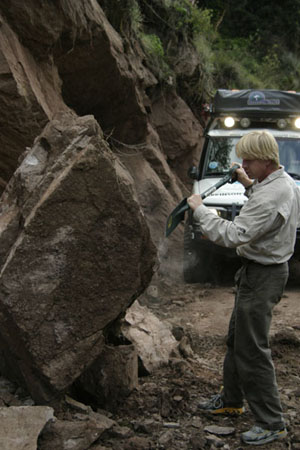
[Above: Todd "Chipper" works on removing a boulder from a mountain road not far from Cusco.]
Boulders blocking Indian village access roads are no match for the Drive Around the World recovery vehicles.
The LONGITUDE Expedition makes use of four Certified Land Rover Discovery Series II vehicles with each vehicle playing a distinct role. Vehicle D1 ('D' being short for Discovery) serves a technological purpose. It's a base for technology items such as, satellite phones, HAM radios, and laptops (provided by Seagate). The laptops are running a fascinating piece of navigation software made by Keyhole software, called EarthViewer Pro. D1 also includes a wireless router that allows team laptops to communicate in camp and even while the convoy is moving. D1 is also responsible for charging batteries for computers, cameras, and radios. All of the technology is powered by three Optima batteries, separated with Sure Power battery separators and a 1000-watt inverter provides 110 watts of power for hours.
Vehicle D2 is manned by the documentary crew of Flip Flop Productions -- Adam Burgess, Neil, and Colin -- and holds the film crew's cameras, lenses, filters, lights, and tape stock. Vehicle D3, piloted by Nancy and Todd, is the chuck wagon. It holds food and water provisions for two weeks as well as everything needed to make and break camp. Finally, vehicle D4, driven by Justin and Rolf, holds spare parts, tools, and the main medical kit provided by Adventure Medical Kits (the other vehicles have smaller med kits). While all vehicles are equipped with ARB bumpers and Warn winches, D3 & D4 also server as recovery vehicles. They are equipped with extra gear such as Extreme Outback recovery equipment, compressors, shovels and other tools to dig the team out of stuck situations. Whenever we split up, the rule is one recovery vehicle must remain with each group. Today we needed our recovery vehicle.
Nick and Nancy recc'ed some trails earlier today and came back to fetch the rest of the team, wearing ear-to-ear grins. They had found a good trail to take sponsor pictures so we all piled into our vehicles and drove thirty minutes southeast of Cusco into a nearby canyon. On the way we drove through two Indian villages and through some pretty deep mud bogs too. All vehicles made it through, as always, without a hitch.
Passing through one village, we looked down from the hillside and spotted a football game going on. As we passed the field, people waved and yelled "buenas dias," reinforcing the notion I already had; people in Peru are very friendly.
The road quickly turned to dirt and we continued to snake back into the canyon, taking great care as we drove along the ridge. To our left was a steep drop down the canyon to a rushing creek below. At times, the road narrowed and was barely passable. I call these roads, 'two-handers' because you're wise to keep two hands on the wheel at all times with priorities being to watch the road first and scenery, second. The scenery was indeed breathtaking. Small mountains with neatly kept crops growing on the hillsides, distant views and a sporadic bright red-orange poppy to break up the greenery. Some of our best sights and experiences with nature and local people occur while driving on these back roads. I kept thinking, I know we'll make it back here again some day.
Eventually vehicle D3, came around a bend and discovered a large boulder blocking the road. The boulder was the result of a small landslide and there was no easy way around the obstacle. I suppose one of these small to mid-size road vehicles could make it around but one false move to the left and it's creek-city, bent metal, and certain death. Being members of Tread Lightly! we figured we could use the opportunity to clear the road for these people and get in a bit of winching practice to boot. We're light on this sort of training and Nick says the roads in Indonesia and Russia will demand that we have these techniques down. Nick and Nancy took turns spotting one of the vehicles around the boulder with some excellent shovel work by Todd, 'Chipper' to reduce the size of the big rock. Once around we placed an Extreme Outback recovery strap around the rock, and connected the Warn winch using a heavy-duty snatch block. Our team and friends retreated to higher ground while Nick took the wheel of D3 and Nancy operated the winch remote. After some movement it became apparent that the boulder's center of gravity wouldn't accept a straight pull in the desired direction. In fact, if we continued the tug the boulder would fall smack dab in the middle of the road, trapping our vehicle. A plan B was necessary so we snapped some great pictures for our sponsors and hung up the winch; The solution was a great one. It used the team's might and the intellect of our new friends. Noticing that we were re-evaluating the object, the Indians headed up the road and returned with several long logs. Using smaller rocks as fulcrums, the logs were used to lever the boulder up a bit, allowing us to place a rock underneath. This technique was repeated over and over until the boulder was tilted up on it's side. Finally, our team and the Indians leaned in together and moved the big rock off to the side. The road had been cleared but, more importantly perhaps was the lesson this little exercise had brought. Tomorrow we will visit Machu Picchu, home of the ancient Incan civilization over 500 years ago. I can't help but think that we will have a new appreciation for its construction after our little rock-moving incident.
Chanda
chanda@drivearoundtheworld.com
P.S. - Today we had an evening photo shoot in the hills of Peru. Nick and I went out in the morning with a shoddy map of the area. Our plan was to find a dirt road, explore it, and decide if it would provide the sort of landscape we'd need to take some photos for our sponsors. Nick and I had a blast driving through a quaint and happy little village, past pigs and goats and sheep, past a town soccer game, past the farmers working in their fields, and past giant mud pits and children playing. We ended up on a bunch of switchbacks leading up a mountain along a fast-flowing stream. It was perfect for a photo shoot. We returned with the whole team, our four Certified, Pre-Owned Land Rovers causing quite a stir in the tiny little village. We found a road which had been blocked by a huge boulder, and we used our WARN winch, our Extreme Outback recovery equipment, and a lot of elbow grease to help a few of the local men remove the boulder from the road. It felt great being able to clear a road and help the village, and we got our sponsorship photos, too. I even got to ride my Santa Cruz most of the way home along the winding switchbacks. We're having a great time here in Cusco, and we get to go to Machu Pichu, Titicaca, and Bolivia in the next few days. (N.O.)
| Logbook for January 11th, Day 72 | ||
|
Start: Cusco, Peru N: 13* 31.017' W: 71* 58.835'' |
Finish: Cusco, Peru N: 13* 31.017'W: 71* 58.835'' |
Mileage: 035 |
January 12, 2004
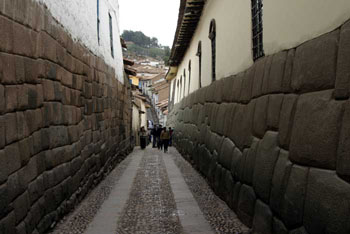
[Above: An example of the classic Incan stonework in Cusco (read on for details!).]
Cusco!!!!.................... I really need you to realize how amazing Cusco is, so take a moment and say ............................."Cusco" ........................... Alright, now I know you probably didn't really clear your mind yet and say Cusco, so try it one more time and say................................."Cusco".....................................!!! Okay, now you have to make a promise to yourself that you will come a visit Cusco, Peru sometime in your life.
Cusco is the most beautiful city I have visited on our trip. Cusco is a town completely blanketed with Spanish red tile roofs and sits on top of ancient Incan ruins. The buildings in the Plaza de Armas have the old Incan foundations still intact. In fact, when you walk a block out of the plaza into San Blas, a subsection of Cusco, you see some of the most amazing Incan walls in Peru. The stones are cut to fit each other so perfectly that there was no mold required to hold the buildings in tact. On one specific street I saw, one side of the street has an Incan infrastructure, and on the other, Spanish infrastructure. The difference is quite remarkable. The corners of the buildings have stones that were smoothed out to make the round corner of the building. These are immense stones too, I cant' imagine how long it must have taken to build such magnificence.
Another interesting structural fact that Incans knew about were earthquakes. When you look at these walls of huge stones, you realize that the very bottom of the building, the first two rows, are made up of much smaller stones and are not fit perfectly. This was to allow for movement in the building during an earthquake. They also build doorways out of stone that were shaped like a trapezoid, and this was for strength as well. It is no wonder why the foundations are still used today. I wish you could be here to experience Cusco, it is truly amazing. But I know you are already making plans.
Another wonderful thing about Cusco is the people. The people of Peru, especially out here in the mountains are so friendly. It is really nice to see. You really see it when you step outside of Cusco into the surrounding smaller towns. It is much more serene. However, within Cusco, all you need to do is walk a few blocks up the hill into San Blas and you will enter the most tranquil setting. There are houses and little shops and restaurants, which all move at a very slow pace and you feel very relaxed. It is quite different then the Plaza de Armas in the center of Cusco.
The Plaza de Armas is beautiful and has two cathedrals and is lined with all kinds of shops and moneychangers and restaurants. However, it is also filled with too many little kids running around trying to sell you something every minute of the day. That really is the only aspect of Cusco that is annoying. At night, it changes to little kids trying to drag you into all the bars. Cusco has an amazing nightlife, which roars until sunrise every night of the week. There is something for everyone in Cusco.
Today, we walked up through the town of San Blas, which truthfully is as powerful and breathtaking as going to see Incan ruins in the parks. The structures are the same, and seeing those stones just mesmerizes me. Anyway, we walked all the way up the hill towards the Christo Blanco, which is a statue of the White Christ, and sits atop the hill on the outskirts of Cusco. From the top you can see all of Cusco and it is an unreal view. To see all the red roofs surrounding the Plaza de Armas is spectacular.
Also, right behind J.C. are the ruins of Sacsahuayaman, almost pronounced, "sexy woman." These are very impressive ruins and you can just walk there from Cusco. Some of the stones, or boulders, used here are HUMUNGOUS!!! They are literally 20 feet high and 10 feet wide. It is difficult to fathom how they moved these stones into place. It is amazing and sad at the same time. In order to build such magnificent cities, there had to be an equally immense slave, or peasant force at work.
These ruins are one of the many other ruins you can visit near Cusco. Of course there is Machu Picchu, which you must do as well. And hiking the Inca Trail to get to Machu Picchu is one of the greatest things I have ever done, so make sure when you do come here, you do that also. You could spend many months or years even around Cusco and visit lesser-known ruins and go on incredible hikes and adventures.
Another reason you could stay here so long is the food is delicious and inexpensive. We ate at our favorite place again today, which has a great deal. For less than 2 dollars, you get your choice of cream of spinach, or asparagus, or pumpkin, etc. etc. etc. And before you get your soup, you get some juice or tea, and also some garlic bread. Now for the main course, you can choose either pizza, pasta, Peruvian style chicken or beef dishes, or fish, or many other great tasting dishes. My favorite is the Peruvian olive pizza, wow, those olives are delectable. After you have eaten all this food, you also get a dessert, usually some fresh bananas with honey, mmmn, mmmn. And all this for less than 2 dollars. It is awesome.
Well, Cusco has a million things to offer, and there are too many small details to spend all my time writing about, I rather go outside and experience them, so I will leave you with this........Come to Cusco. You will never regret it.
Neil
neil@drivearoundtheworld.com
P.S. - Today we had day off after having worked hard on sponsorship materials for the past few days. Most of us just puttered about town doing our own thing. Justin and I experienced som Thai cuisine at a local restaurant in town. It was actually pretty good. Later, most of the gang went out on the town and hit a few of the favorite local clubs. Nick, Chanda, and Todd paid a visit to a Shaman and had an overnighter at the Shaman's facility. I think maybe you'll get to hear about their experiences in a future journal entry. On Wednesday, we're getting up at 0500 to take a train to Machu Picchu. Woohoo! Tomorrow is basically another day off. (N.O.)
| Logbook for January 12th, Day 73 | ||
|
Start: Cusco, Peru N: 13* 31.017' W: 71* 58.835'' |
Finish: Cusco, Peru
N: 13* 31.017' W: 71* 58.835'' |
Mileage: 000 |
January 13, 2004
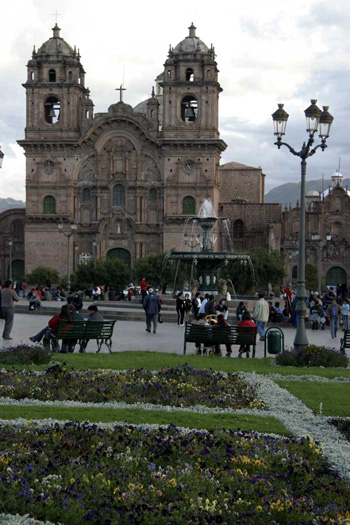
This day was a great day for just relaxing. The weather is overcast, and we even heard some thunder late in the afternoon. Last night, we were hit with a few rain showers, and it gave the city a nice clean feeling. Many of us slept in late today because of sparse sleep last night. The clubs were hopping, and the crew who went to see the shaman didn't sleep enough. Colin, Nick, Chanda, and I went to the hotel's sauna, and then I had my hair trimmed and got a pedicure. It was nice to pamper myself for a change. I feel like a girl! Tonight will be an early-to-bed night, because we have to rise at 0500 to meet our train to Machu Pichu. (N.O.)
| Logbook for January 13th | ||
|
Start: Cusco, Peru N: 13* 31.017' W: 71* 58.835'' |
Finish: Cusco, Peru N: 13* 31.017' W: 71* 58.835'' |
Mileage: 000 |
January 14, 2004
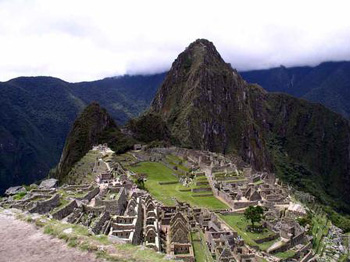
[Above: The famous and breath-takingly beautiful ruins of Machu Picchu in Peru.]
We are headed to Machu Picchu today! Unfortunately we did not have time to stay in Agua Calientes the night before so we could see the sunrise upon Machu Picchu, but whenever you go the site is truly amazing! Despite the early hour the team was ready. In fact I was the last one down to the taxis that were waiting patiently to take us to the train station. We arrived at the station in good time and even had to wait a bit before we boarded.
Cuzco is located in a valley so the train had to work its way up the hill using a series of switchbacks. The train would climb for about 10-15 minutes and then we would stop, the track would be switched and would descend a bit before climbing for another spell. We did this about 5 times before we clear of the valley.
As the train lumbered along some of us slept, others chatted, and others just looked out of the window. I pretty much just looked and slept. It was interesting looking out upon the landscape seeing the corn, potatoes, llamas, pigs, cows, and other animals. What was really amazing was to see the terraced hillsides. These terraces are a series of step that are carved in the side of the mountain. They vary in width, but most seem to be about 6 to 8 ft wide and can be any distance in length. These steps serve two purposes first they prevent soil erosion by reducing the speed of the rain water as it travels down the side of the hillside, and they spread the water flow to a greater area. Apparently these steps are not as simple as the first appear. In every step, although you can't see them, there are three layers. The bottom layer is made up of clay, the second layer is made up of rocks and the top layer is made up of good topsoil.
As the water comes down the mountain it moisturizes the top layer were the crop is grown. The second layer, of rocks, allows the topsoil to drain off excess water preventing root rot and mildew problems. The third layer, of clay, prevents drainage, dumping the excess water down to the next level. Pretty amazing!
In the course of journey we dropped form about 12,000ft to a mere 7,500ft. This would have been great if we had level ground to walk on, but Machu Picchu is not known for it's flat ground.
Three and half-hours after leaving Cuzco we arrived in Aguas Calientes, the town just beneath Machu Picchu. The train dumped us off and we had to find our way down the gauntlet of street venders to where the bus would takes us the 8km to the top of the hill and Machu Picchu.
Our time was limited at Machu Picchu, so we paid the price for quickness and convenience. The team was soon to the top of the mountain and Machu Picchu was in sight! There is something about this place, it is like a mantle piece situated upon the earth's hearth. As you stand on the ledges of this mountain you can see and hear the river rushing down below, and I mean rushing. I have never seen such a river with that strong of flow, we all speculated how long someone would survive if they fell in, and none of the estimates were very long.
Anyway, back to the peaks. Machu Picchu is an Incan outpost/village that was abandoned long ago. No records mention it. Although many farmers in the area knew about some of the structures it was not excavated until 1911 by an American Professor from Yale named Hiram Bingham. You may think it is strange that the farmers didn't mention it or someone didn't excavate it earlier. You have to realize that there are stones everywhere and it would be really easy to confuse ancient ruins for just another rocky landscape. Also, the jungle grows at an amazing rate, very quickly covering anything that is not maintained. This is one of the reasons the Mayan ruins were preserved so well. The jungle covered them so the Spanish didn't realize they were there. It was standard operating procedure when the Spanish conquered to tear down structures of whom they conquered and build their own upon them. This is especially true for holy or religious places.
Machu Picchu since it was so remote managed to escape human destruction. Much of the city has been rebuilt be archeologists, but all the old stones were there so it was not that difficult to rebuild. Machu Picchu was a community for scientists and artisans, or it has been so speculated. Without any kind of records most all information about Machu Picchu is based upon speculation.
I was most impressed with the series of baths and several of the temples. There were a series of shallow trenches connecting open bath chambers. A constant trickle of water would flow from the top of the mountain through the series of chambers. It was quite an effective source of constant water flow. The temples were impressive due to the amazing stonework that was used to construct them. The large stones fit so tightly together it was difficult to see the seam between rocks. No mortar was use in any of this construction. Truly amazing!
Milling around amongst these structures was neat, but I really enjoyed just sitting amongst them. There is a herd of llamas that serve as lawn mowers at Machu Picchu; I had the opportunity to see how llamas spit at annoying people, that was pretty funny.
Unfortunately our time was soon up and we had to catch the bus in order to catch the train. I recommend to travels to go to Aguas Calientes and stay so you really will have a full day at Machu Picchu, the place is wonderful, although pricey. If you get there early you will avoid the crowds, you can't do that if you take the train.
Another thing that was amazing at Machu Picchu was the fact that there were all kind of steep slopes, and no guardrails. I noticed the sundial was cordoned off, and a couple of other things, but everything was mostly wide open. I thought about potential lawsuits, and the possible destruction of this relic due to reckless people. I know that this is a problem here and Peru is being encouraged to make stronger policies to protect Machu Picchu. I thought about the DATW lawyers, Gibson, Dunn, & Krutcher, it would be great to have Michael Levy with us here, but I wonder if he would pull his hair out trying to see through the cloud of liability. Hopefully he can join us later, as Gibson, Dunn & Kructher is another reason why we are where we are. They offered their services to us as we were first incorporating ourselves as a non-profit organization. They have continued to support us answering our many questions as we traveled towards our departure day and beyond.
We made our way back to the train and eventually to Cuzco. We have another early day tomorrow as we make our way to Puno.
Toddtodd@drivearoundtheworld.com
P.S. - Our visit to Machu-Picchu today was incredible. Until you see it in person, you have no idea just how amazing it is. The ruins are one thing, built by hand out of immense rocks by the Incas, but the view is the real attraction. It's built on top of a mountain, and next to it is another mountain with another set of ruins, called Huayna Picchu. When you look at a typical photo of Machu-Picchu, it's the mountain in the background. Justin and I hiked to the top of it, and it was incredible. The hike to the top was about 43 minutes, and I can chock it all up to good training. It felt great to be active again, especially at altitude. I'm real proud of Justin for hiking up with me. Between that hike and the mountain biking I did the other day, I'm feeling pretty happy. See, what I miss most about home is clean bathrooms and adventure racing...we're actually doing pretty well in the bathroom department here in Cusco, and I'll keep training when I can for the adventure racing. Everyone is doing well, and we're leaving for Puno and Bolivia tomorrow morning. (N.O.)
| Logbook for January 14th, Day 75 | ||
|
Start: Cusco, Peru N: 13* 31.017' W: 71* 58.835'' |
Finish: Cusco, Peru N: 13* 31.017' W: 71* 58.835'' |
Mileage: train to Machu Picchu |
January 15, 2004
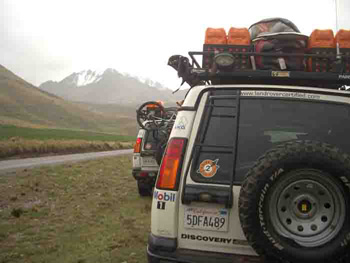
[Above: The scenic road to Puno, Peru.]
Today is a traveling day. Finally. We've been in Cusco for what seems like forever. It's been more than a week, and as great as it is here, we're ready to move on.
We got up early today, intending to hit the road at 0730. I got up, got ready, and carried all my bags downstairs to the lobby. Then I made two more trips to the room to carry down our precious Santa Cruz mountain bikes. I actually got to ride quite a bit in Cusco, and the bikes, like the team, were treated to the comfort and safety of the Royal Inka's plush rooms each night.
The nice Senora at the hotel's front desk watched my stuff while I ran off to the Playa del Estacionamiento (Parking "Beach") to retrieve Vehicle D3. I was back, loaded, and ready to go before 0730. Unfortunately, things happened, as they tend to do, and we didn't leave at our specified time.
First, we had to spend an hour talking to the parking lot owner about the obscene rate they charged us for parking. She was kind enough to finally decide not to overcharge us after learning that we are all volunteers and are trying to raise money for Parkinson's Disease research.
Secondly, we had to allow time for Todd to make his scheduled 0930 phone call to the Royal Geographical Society research sites coordinator. He had a conference call to them to arrange for assistance with our visits and our education program.
Finally, since it was 1100 by the time everybody finished up with the phone calls and the Internet café, we had to delay our departure a bit longer for lunch. I had snagged a ham-and-egg sandwich from the hotel's free breakfast, so I decided to shop instead of eat. I was on the hunt for a traditional Cusquena hat, which basically looks like a ski hat with ears, except that it is brightly colored and layered with intricate beadwork around the sides and ornate pom-poms on the top and on the side strings. They are antiques and take more than a month to knit. The colors are natural dyes, and the fabric is hand woven from alpaca wool. I'm in love with them. I didn't have enough money with me to buy the one I found at Aguas Caliente during our trip to Machu Picchu, so I am still sadly in search of the perfect one. I found several, but none will fit my huge melon. I guess I'll keep looking. It'd be a fun item to have to remind me of my Around-the-World expedition, my teammates, and Peru.
We finally pulled out of Cusco at about 1200 and headed toward Puno, a city on the banks of Lake Titicaca. The drive brought us past the snowcapped mountains of the Cordillera Real and the green farmland of the Altiplano. As we drove, the altitude increased, and the temperature dropped. Fresh snow was falling in the mountains around us.
By the time we drove through Puno and did a couple of circles in search of a nice hostel and secure parking, it was raining cats and dogs. And it was COLD!!! We moved in to the Hostel San Antonio and then headed to the plaza to find dinner. Because the whole city is on a hill overlooking Lake Titicaca, the rain forms huge rivers down every street. We had to ford several "streams" at each crosswalk heading toward the main plaza, and our shoes were soaked in no time. Thanks to our GoreTex North Face jackets, though, our bodies remained perfectly dry.
Puno lacks the beautiful Spanish architecture of Cusco, but it has a charm of its own, and the people are spectacular in their traditional dress and bowler hats. The native women begin wearing men's bowler hats at about the age of 13 to signify that they are ready to settle down with a husband and to take on the responsibilities of a household, marriage, and children. The English brought these hats over about 80-90 years ago. Thousands of years prior, the Incas would put boards on their foreheads to deform their skulls into a more elongated cranial shape, much like the conical shape of the Englishman's bowler hat. Once introduced to Peru, these hats became a sort of extension of, or update to, the tradition of actually deforming the skull. Now you will see women wearing men's bowler hats or fedoras all over Ecuador and Peru.
We found a great restaurant that had a huge Native Indian band onstage singing and playing the drums, pan flutes, and tiny little guitars. They were an excellent accompaniment to our traditional meals. Justin had alpaca, and I tried a bite of it. It wasn't bad at all. It tasted pretty similar to beef, with a hint of lamb.
After the restaurant, we headed back to the San Antonio and our comfy beds. We have a tour of the floating reed islands of Uros tomorrow, so it'll be an early morning. I think Colin's got Friday's journal, so ya'll stand by for some interesting reading. I'm certain Lake Titicaca will give him lots to talk about.
Until next week
Nancy
nancy@drivearoundtheworld.com
P.S. - We left Cusco for Puno, near Lake Titicaca, at about noon. The drive was a beautiful one that took us past snowcapped mountains and through the endless green fields of the altiplano. We arrived in Puno in time to see the shopkeepers closing up their kiosks. We also arrived in time to experience the effects of a pouring rain on a city whose streets run downhill into the world's highest lake. We were nearly washed away as we walked down the street toward the plaza for dinner. We enjoyed a traditional meal with traditional entertainment (singing, pan flutes, drums, tiny guitars) before returning to the Hostel San Antonio to hit the sack. Tomorrow we have a guided tour of the floating reed islands of Uros.(N.O.)
| Logbook for January 15th, Day 76 | ||
|
Start: Cusco, Peru N: 13* 31.017' W: 71* 58.835'' |
Finish: Puno, Peru N: 15* 50.480' W: 70* 01.706' |
Mileage: : coming soon... |
January 16, 2004
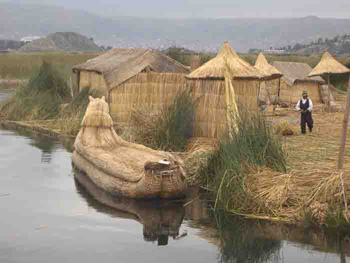
[Above: The floating village of Uros on Lake Titicaca.]
Today I have the fortunate pleasure of being the person to write the blog for what was probably our most action packed day of adventure yet. We started our morning at 9am, when a minibus picked us up at our hotel in Puno Peru for a tour of the reed islands of Lake Titicaca. We all piled in the van and prepared for our three hour journey. We had no idea how interesting it would be.
When we got to the dock it was overcast and cold, really cold -- I mean 4 layers cold. We had a few minutes to buy snacks and then we were herded onto our boat by our tour-guide Mairo. He began to explain the history of the floating islands.
The people of the islands were originally land dwellers, but when the Inca came to the Titicaca region, the people were forced to hide on the lake. The lake, being filled with reeds offered great materials for building, so the people decided to build their own islands. They created these floating homelands by carefully weaving layers upon layers of reeds together on top of a base of floating reed roots. The islands only last ten or twelve years and then the people must start building a new one. They test the stability of the islands by digging down through the layers of reeds and sniffing for the smell of decomposition. Of course, the islands immediately begin to decompose as soon as they are built so there is always a smell of sulfur when they dig down (when we smelled it, the stink smelled vaguely of farts and rotten eggs) however when it is time to build a new island apparently the small is horrendous.
There are over twenty islands with up to ten families that live on each. Certain islands have schools and there is a hospital too. Only ten of the islands actually allow tourists to visit them and the people that live there make their living though the money that tourists spend to go there and from the typical stuff the tourists buy. These islands are more technologically advanced than those that don't allow tourists. They have solar power and I was amused to find a television in one of the huts.
Anyway, Mairo was a great guide. We started off on one island where he explained all about the lifestyle and showed us the inside of one of the huts, which I might add was quite small, closet-sized even, and slept up to six. The weather then cleared, sun and all and we then took a cool little reed, little man-powered boat over to another island which was pretty much the same as the first, except that an ingenious old lady had thrown together a small potato patch in a corner of the island on a pile of decomposing reed roots. Mairo had answers to all our many questions such as, where do these people go to the bathroom? The answer was that they built little island off the main ones where they could poop in shallow latrines and then dry the waste so that it wouldn't pollute the water.
So, we finished up our tour of the island and returned to our hotel to prepare for another exciting journey, our first confluence. Now, confluences are a little weird, and actually upon first hearing about them I thought them to be ridiculously stupid, however I eventually grew to love the idea. A confluence is the spot where lines of latitude and longitude meet. There is a website called www.confluence.org that lists every confluence in the world and whether or not it has been "bagged". Bagging a confluence is when you take your GPS and go to the exact spot of the confluence and take a picture of you and your GPS reading all zeros. The lines we were trying to reach were longitude 70 and latitude 16.
So, Mairo, our guide from the reed islands met us at about 4pm, not having a clue what he was getting into. I think he actually thought that he was taking us on a tour of some old funerary tower ruins. When he finally did realize what we were doing he said that it was "completely crazy" but that he liked it.
So we all piled into the Land Rovers an drove about twenty five kilometers out of Puno. It was pouring rain and Nick, GPS in hand, was carefully monitoring the spot at which we would have to turn off the road, and when the time came he called the cars to a halt over our new radios. We all pulled over and went to check out where we would be going, which was basically swampland. At first Nick was insistent on us walking almost a mile out into the swampy field, but with a little encouragement, the team convinced him that we could drive it.
Nancy went ahead on foot as our scout, to tell us when ponds and whatnot were in front of us. Eventually we came to a point that Nancy said we could not cross, Adam was disbelieving of this, so he took off his shoes and waded across the stream that was our obstacle. We all agreed that the creek was shallow enough to cross and from there on was complete off-road mayhem.
The two cars we had packed full of people began to race across the swamp towards the confluence, blasting through ponds and ravines like we had nothing better to do. Our car had a great advantage, Nancy had taken a spot on the rear ladder where she could see over the top of the car and yell directions at us so we could avoid the pitfalls of the swamp. The other car did not think to do this and within twenty minutes they were stuck in an irrigation ditch.
We spent a good half an hour in the rain digging the car out and then thanks to our Extreme Outback Recovery Kits we yanked the car to safety. Another twenty minutes ripping through the swamp and we bagged our first confluence. The team all got back out of our cars in the rain and Neil took some pictures of us with the GPS to prove what we had done.
I had a blast on our little excursion and I look forward to doing it again. After all was said and done, we piled back in the cars and headed back to Puno for dinner, which would turn out to be our third adventure of the day.
So, when we got back to Puno we originally had planned to go to the restaurant that we had eaten lunch at, but Mairo said he knew a better place, so we let him lead. We arrived at our restaurant and sat down to receive our menus at this point Todd, Neil, Adam, and myself decided to do something we had been talking about since we first got to Peru and that was to eat cuy. Now, cuy is considered a major delicacy in Peru, but in the States we consider cuy a pet -- a guinea pig in fact. So myself and the aforementioned guys ordered up our little guinea pigs and waited to see what happened.
When they arrived I was a little taken aback. The Cuy looked like one of the rats from the Muppets. It was deep fried with its head still on, and mine was looking at me very suspiciously, kind of like it was about to get up and say, "Hey buddy, what the heck do you think your doing?" Anyway, I paid five bucks for the thing so I had to eat it. At first bite it wasn't that bad, it kind of reminded me of rabbit but a little more greasy, however after a while, when I had exposed the skeleton and everyone kept talking about how cute guinea pigs are, it started to get harder to eat the thing. Not to mention the fact that there was barely any meat on it, mainly just skin and bones. By the end I was thoroughly grossed out, and had to give up. Mairo gladly accepted the head, which he tore the meat of with gusto. That was the end of it, I'll never eat cuy again.
This was, I'm pretty sure the most active day on the entire Longitude expedition, I'm hoping we have more of them, only without the eating of household pets, because that was seriously gross.
Colin
colin@drivearoundtheworld.com
P.S. - Today was epic. From 0930 to about 1230, we toured Puno's biggest tourist attraction, the floating islands of Uros. There is an indigenous people who have lived on floating reed islands on Lake Titikaka since the days of the Inca. We were amazed to visit these people on their islands and had a hard time imagining what it would be like to spend your whole life on an island that is smaller than a high school infield. You can't run on the reeds that make up the ground, and you have no hope of biking. You'd spend most of your days fishing and tending to the islands if you are a man, and women would spend most of their time watching the children, cooking, and making handicrafts to sell to tourists. After the Uros visit, we searched for and found, with the help of our Garmin GPS, a point where lines of longitude and lines of latitude crossed. It was in the middle of a farmer's field on the outskirts of Puno. More on the significance of this later in Colin's journal. The day was good. Tomorrow we leave for Bolivia.(N.O.)
| Logbook for January 16th, Day 77 | ||
|
Start: Puno, Peru, 1600 N: 15* 50.480' W: 70* 01.706' |
Finish: Puno, Peru, 2000 N: 15* 50.480' W: 70* 01.706' |
Mileage: 028 |
January 17, 2004
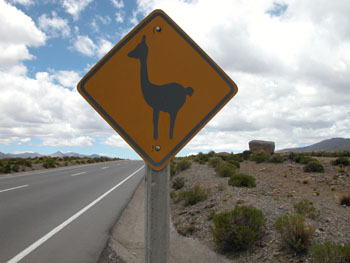
[Above: A llama-crossing sign along the Bolivian highway.]
One thing I've learned on this expedition is that I wish I had studied Spanish in high school.
Seriously.
Each day on the expedition, I'm given an opportunity to practice my Spanish-speaking skills. Now, these opportunities often come with a great of pain inflicted on the ears of whomever I am speaking to and it usually involves a considerable investment of their time to figure out what I am talking about. Regardless, most of the time communication does occur. Let's review how far I've come with my Spanish skills on the expedition.
When we left, I knew enough Spanish to say hello, goodbye, how are you, and where's the bathroom. I could also order a drink and say things that would most likely get me involved in a fight or make my mother blush. So, suffice to say my knowledge of the Spanish language was roughly equivalent to a high school freshman.
Now, however, I can order food, get set up at an internet café, shop and bargain almost like a pro, and carry on a relatively civil conversation with someone I meet on the street. Not too bad. Plus, I can still stay hello, goodbye, how are you, where's the bathroom, and all that other stuff that still has my mother blushing. One of the problems I run into now is that the little bit of Spanish that I do know, I can now deliver with such confidence, I frequently trick people into thinking I know a heck of a lot more Spanish than I do know. Which is fun, and often leads to a learning experience for me. But the other problem I run into is that often times I will deliver the entire 20-30 minutes of Spanish I know in about 2 minutes. The conversation goes like this:
Me: "Buenos! Como estas?"
Them: "Bien, gracias. Que paiz?"
Me: "Los Estados Unidos. Mi en es groupo manahara todo del mundo .blablablabla blablablablablablablablablablablablablabla volunterio lablablablablablablablalbablabla blablab dinero lablablablablablablablablablablablablablablablablablablabla se llama Parkinson's blablablablablablablablablablab El Papa y Mohammad Ali lablabl abla lbablablabla cinco dias lablablablablablablablablablablab lablablablabl ablab labl ablablablablablablbalablbabl Si! M me gusta Sur America blablablablablabl ablabla
Them: Ay! (Insert incredibly complex conversation-piece in Spanish here at a pace so fast that even native Spanish speakers couldn't understand what they were saying).
Me: Uh .Lo siento. Una veces mas, por favor. Me habla poco espaniol.
Repeat the same exchange with no further success)
Them: Ay, bien. (Then they stand there nodding for a second pondering what to do next, then ) Ciao!
So, you can see how premature delivery of my Spanish vocabulary can lead to a shortened conversation and quite honestly an unsatisfactory encounter with a local from the country I'm in. Not to mention it leaves me feeling very frustrated because quite honestly, I should know more Spanish than this. Don't get me wrong, my guerilla, phrase-book tactics for learning Spanish are quite respected among my team members. In fact, I've been told that I'm fearless and that my Spanish has improved the most of anyone so far. That's quite a complement in my eyes, but I don't want to kid you. I am still barely a half-step above caveman Spanish.
This week, I had a great opportunity to practice in the company of a new friend. Our 5th Take Me With You! guest, Mairo Moya was very friendly and helpful when it came to practicing my Spanish. It also helped that he was bilingual, so anytime I couldn't continue in Spanish, I could talk to him in English. As a native Peruvian, Mairo is very proud of the Incan traditions, and we spent a great deal of time not only talking about Peruvian history, but we also talked about different goals and aspirations. Mairo is a 28-year-old tour guide for Isla de los Uros, the famous reed island communities of Lake Titikaka (always with a "k", never with a "c" he insists). However, he is also in the process of building a new house for his family (first son is due in about 2 weeks) and in the process of trying to start a charitable organization that will provide alternative housing for orphans in local communities.
Mairo met us at 6:30 am for our departure for La Paz, Bolivia. Given the supposed risk of riots in Bolivia during our stay there, we both agreed having him along as a cultural expert could benefit us. The drive to La Paz was relatively uneventful, however I had my head buried in my laptop most of the day preparing information for an article that will run in the Feburary 8th edition of the Orlando Sentinel. I did look up long enough to see the sparkling blue waters of Lake Titikaka before we crossed into Bolivia. It was absolutely breathtaking. Several miles in the distance, a small range of mountains skirted the edge of the water, gently reflecting their beauty off the water as if it was just for us to see. Immediately in our front was a cliff that dropped off about 300 feet to the water's edge. A few dozen meters out into the water you could make out the silhouettes of 6 different fishing nets and cages, clearly set up to pull in the freshest fish and shell fish to be taken to a nearby market.
We continued into Desaguadero, a bustling little border town on the very southernmost point of the lake. We were pleasantly surprised when it only took us about an hour and a half to complete the full process of exiting Peru, canceling the temporary import paperwork for each vehicle, then registering our Land Rovers for driving in Bolivia, and completing the individual paperwork necessary. We were very lucky, and the border personnel were very friendly. Although they yelled at me as someone was filming me standing in line to have my passport stamp, when I returned to the cars to work security detail, one of the other officers called me over and we had a good conversation in Spanish.
But the best part of my conversation with the border guard was that it lasted more than 5 minutes.
P.S. - We departed Puno at around 9 in the morning to head to the Bolivian border. With us is Puno resident and native, Mairo. He was our tour guide during our visit to Uros, and he came with us to find the latitude/longitude intersection last night. He had so much fun, and we had so much fun with him, that he agreed to join us for the drive to La Paz in Bolivia. The border crossing from Peru into Bolivia was less than an hour-and-a-half, and it was the easiest yet. No car search, no VIN verification. Bolivia is pretty laid-back. We arrived at the border at noon, left at about 1:30, and arrived in La Paz at about 4 p.m. A wonderful local woman named Catalina helped us find a nice hotel with good parking, and we settled in. Catalina had studied for two years in the U.S., and she easily recognized gringos in need of assistance. Driving in this city is NUTS! Tomorrow, more fun in Bolivia.(N.O.)
| Logbook for January 17th, Day 78 | ||
|
Start: Puno, Peru N: 15* 50.480' W: 70* 01.706' |
Finish: La Paz, Bolivia N: 16* 30.162' W: 68* 08.133' |
Mileage: 153 |
January 18, 2004
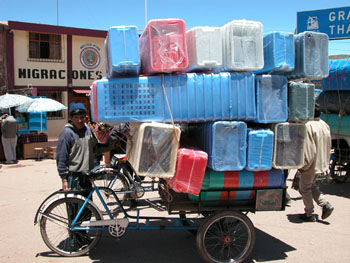
[Above: A big vendor's cart in Bolivia.]
During our first full day in Bolivia, most of the team divided their time between working on our programs (education, sponsorships, Take Me With You!, webpage, article writing) and shopping the "black market." The market contains row-after-row, street-after-street, and booth-after-booth of shoes, "designer" clothing, electronics, and produce. The exchange rate here is just under 8 Bolivianos per U.S. Dollar, and you can get a huge meal for under two bucks. Not bad at all. FYI, begging and street selling is super low-key compared to Peru. They take "no" for an answer, and nobody bothers you much. Today was quite enjoyable on all fronts. Viva Bolivia! (N.O.)
| Logbook for January 18th, Day 79 | ||
|
Start: La Paz, Bolivia N: 16* 30.162' W: 68* 08.133' |
Finish: La Paz, Bolivia N: 16* 30.162' W: 68* 08.133' |
Mileage: 000 |
January 19, 2004
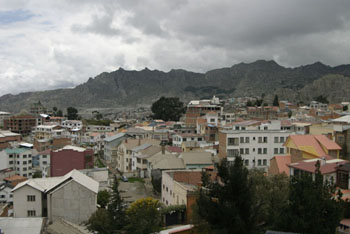
[Above: A view of La Paz, the Bolivian capital city.]
La Paz is appropriately named Peace, for it is located at the foot of a staggering mountain range. When you come into the city, it is the most incredible vista for a city you can imagine. You can see the entire city and all the surrounding houses and buildings piled all the way up the surrounding mountainsides. It must have been extremely peaceful back in the day before it grew into the bustling city it is today. Today, La Paz is immense in size. It is interesting as well because many cities around the world, the wealthy have nice homes in the surrounding mountains. In La Paz, it is the opposite. The higher you go up the mountain out of the valley, the poorer the houses become. The upper class towns are down in the valley. It is wild to see, there are thousands of houses built right into the mountainside, as if they are rock formations that have taken shape over the years. Many of them are built on very steep grades and it is a wonder that they are still standing.
While in La Paz, I ended up talking to our hotel receptionist quite a bit and learned a great deal about Bolivia and it's people. Her name was Vicky and she told me a story of what happened in October when the whole country decided to strike in response the former president's efforts to raise taxes. Many Bolivians only make $20 a month and it is very difficult to survive, and when the president wanted to raise taxes even more, the country went ballistic. Our hotel is across the street from a prison, and when the strikes first happened, the police were striking as well, so there were no officials around to police bad behavior. The walls of the prison are at least 30 feet high, and Vicky described her fear when she saw the prisoners trying to escape over the top. A couple actually succeeded due to a rather large tree that is outside the building. The prisoners also started a fire and almost burned down the front door of the prison. Can you imagine the horror of being across the street in a hotel watching this happen and not being able to call for help, and just feel completely helpless? This is how she felt, completely helpless, and it is how she and her people have felt one more than one occasion. In February, there were more strikes, and it was even worse. The people finally calmed down when they ousted the president and the vice president took over. Today, it has been a couple months since any major situations have happened, but she is not confident it won't happen again.
Anyway, I ended up walking to two different ends of La Paz, up the mountain and up to two beautiful serene parks that overlooked the city. One park had a cute little church at the top. I could definitely see many marriages happening there, it is a great location. You can see most of La Paz, yet you are surrounded by trees and you are high enough to avoid hearing the hustle and bustle of the city.
La Paz is a really interesting city and I am grateful to be able to visit Bolivia. I must thank Land Rover for all this. They gave us these vehicles which have enabled us to get all the way down here to Bolivia. If it wasn't for them, we wouldn't be here. We have crossed rivers and been through some wild mud bogs too. In fact, the other night, we ended up off road in a marshland, and boy was that fun!! We ended up chasing a point of confluence with our Garmin, GPS systems, and we were going through streams, huge ditches and getting bogged down in deep muddy pits. We were able to get through it all. These vehicles are awesome. They are extremely comfortable, good off-roading, and have passed time and time again whenever we put them to the test. So thank you Land Rover.
Anyway, thanks to our vehicles we have made it to Bolivia and now we are heading to Chile and are almost a third of a way through our journey. It has been amazing so far, and actually is getting better and better every week. We are getting along better, know each other well now and have a really good time together. We work well together and know what our roles are, we are a great team and I am stoked to be a part of Drive Around the World.
And of course I am sooo excited to head to the coast in Chile now!! We are leaving the high altitudes and going back to sea level. And the sea level in Chile is filled with amazing SURF!!!!!!! So hopefully we will be able to surf a spot or two in Chile -- that would be a dream come true. Well, until next time, and hey, next time I will have been in the water and have the biggest grin you can fathom.
Ciao,
Neil
neil@drivearoundtheworld.com
P.S. - This was another work/shop day in Bolivia, with an emphasis on the "work." I'm writing an article about our education program for the Royal Geographical Society, Nick is busting out items for our sponsors, Chanda is updating our website, Justin's working on PR materials, the film crew (Neil, Corndog, and Adam) is working on photos, and Todd is doing educational program work. Everybody's busy. The highlight of Chanda's day (OK, and mine, too) was eating a chicken-and-veggie-filled bread-thingy at about noon (cost: about 20 cents). Nick's highlight was his latte macchiato (the first since leaving California and Pete's Coffee). Tomorrow, we depart at about 0600 for Chile. Yick. Early border day. We might be without internet access for up to a week, so bear with us!!! (N.O.)
| Logbook for January 19th, Day 80 | ||
|
Start: La Paz, Bolivia N: 16* 30.162' W: 68* 08.133' |
Finish: La Paz, Bolivia N: 16* 30.162' W: 68* 08.133' |
Mileage: 000 |
January 20, 2004
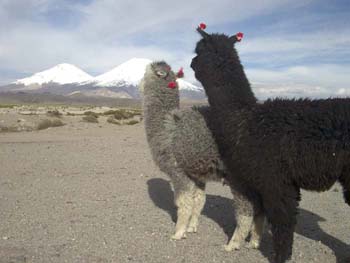
[Above: Llama-like Alpacas on the Bolivia-Chile border.]
To the left and right of northern Chile's two-lane highway is the most peculiar terrain. Its like fields of the largest dirt clods you've ever seen for as far as the eye can see. My mind can only imagine another ancient civilization left their impressive mark by growing gigantic oxen, tying them to telephone-pole-sized ploughs and had them churn up the desert floor endlessly. The dirt here is a pinkish tan and nothing grows. We spent the day driving through the End of the World's largest gorge. I'm glad to be down, safely.
For hours our cars followed the path carved into the side of the dunes. Over the roadsides the sand face continued its sheer drop for thousands of feet down into a slightly green valley. Every few turns another wreath-covered cross or little house inscribed with names appeared where one's fate entailed tumbling helplessly for 4000 feet, almost as scary as plummeting with women and children in an airliner.
Yesterday we drove for hours from La Paz, Bolivia through the Chilean border and descended 14,000 feet to the coast of Chile. We took off at 6am without breakfast. Five hours later, at the border, we found ourselves surrounded by snow-covered volcanoes and alpacas. Alpacas are interesting creatures. They walk like four-legged chickens, are covered with fantastic maroon, black and tan wool, when they see you they "meeep" and they taste like a small cow.
After passing through the border we began to drop. Within an hour or so we came down about 13,000 feet and all of a sudden I could breathe again. I love oxygen. Hunger was rife and as we rounded another corner of the desolate Chilean desert I noticed on the side of the road the most exquisite little abode. A refurbished train carriage was adorned with a hand built windmill that twirled in the evening wind. Scattered around this nucleus was sheltered seating under driftwood structures and tarps. I hailed the others over the CB radio and convinced them all to turn around for food. I couldn't resist such an interesting composition. We pulled the ever-so-common three point turn in the highway and rolled into the desert café. Two beautiful little girls were in the front waving to us with smiles and wool caps. Neil asked if they had comida and they said yes. We weren't sure where to go but they lead us into the shack attached to the carriage. Bizarre. We had just stepped into a hobbit's kitchen/living room. There were barstools around a kiln oven and the layers of clutter lay so thick that there are too few words to describe what fell on our eyes. From behind a tattered curtain floated in a woman in a flannel shirt and dirty sweatpants. The clothes hung on her like obstacles and appeared to have been treated as such. Cold blue eyes beamed out from a once attractive face. She looked European but the desert sun had paid its toll early. She extended a slow limp handshake to the eight of us one by one. We asked if she had food and she scanned through her mind to arrive at the conclusion that there was two pizza loaves left. From a black garbage bag she pulled two hard circular crusts and picked at them for a moment. "20 minutes we can have some pizza for you but first lets go outside I'll show you around Michael Land."
From there we went over to the solar oven and windmills. Andrea's explanation of how it worked morphed rather aimlessly into anti-establishment proselytizing. She defined her location as not a part of Chile, Bolivia or Peru and was miffed at the concept of "where are you from?" Patiently the crew stood listening to her infinite meandering philosophies as the sun set through the desert canyon. It grew cold and time had passed. We felt victims of a Twilight Zone episode. After about 45 minutes of captivity Nick stepped in as leader and announced to Andrea that he was very thankful for her fascinating story but that we had hoped to eat rather quickly and continue driving. She snapped back with the comment that there is a McDonalds in Arica. We left with the last rays of sun petering down on the desert floor and headed for the coastal town of Arica.
P.S. - We're in Chile! It's such a contrast being back in a first-world nation. They have street lights...and lines down the middle of road! We arrived at hte Chilean border at about 1245 and had to wait 40 minutes for the border control agents to return from lunch. Then we drove about half of the distance through "no-man's land" between the exit point in Bolivia and the entry point in Chile. We stopped there to make our monthly sat-phone conference call to media and sponsors. We were on the altiplano at 15,000' above sea level, so of course I had to break out the Santa Cruz and go for a bike ride. Not a lot of oxygen up there! The call went very well, and we headed for Chile. On the way, we passed by a huge mine field--Chile and Bolivia aren't the best of friends. In the background all around us were the beautiful snowcapped mountains of the Andes. This was the most beautiful border we'd ever seen--and it was the fastest and most professional. They actually had an assembly line for stamping us in. It only took about 20 minutes, a new record, to get through the border. On the way into Arica, we descended from a peak of 15,300' to sea level. We dropped about 800' more than the height of Mt. Whitney in California (the U.S.'s highest peak, excluding Alaska). We had an easy drive, and our gas mileage was INCREDIBLE! It helps when your entire trip is downhill. We found a hostel with good parking right away and called it a night. Tomorrow, we're off to Santiago. (N.O.)
| Logbook for January 20th, Day 81 | ||
|
Start: La Paz, Bolivia N: 16* 30.162' W: 68* 08.133' |
Finish: Arica, Chile N: 18* 29.003' W: 70* 18.907 |
Mileage: uh, woops. Coming soon... |
January 21, 2004
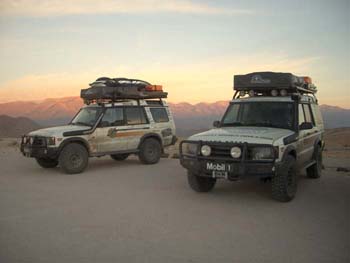
[Above: DATW Land Rovers in Chile's Atacama Desert.]]
Yesterday was cold and rainy, and we were all short of breath. Today the sun is shining, we are in shorts, and we are chillin' in one of the driest places on earth. We are in the mighty Atacama Desert, an area of mineral and metal wealth, and a contested area between Chile, Bolivia and Peru, who are not the friendliest of neighbors. This area was the sight of a war (War of the Pacific) from 1879-1884, which Chile won. Bolivia lost its only access to the sea and Peru lost some land. You can tell by the graffiti on the bathroom walls that irritated feelings still persist. Final disputes resulting from this war were finally resolved in the year 2000 when Chile and Peru finally came to an agreement over the use of the Port of Arica, now Chilean territory.
It was wonderful to be in Chile again and it was nice to be down at sea level. Even though it was warmer than we had been used to, at least the slightest effort would not make us breathe hard. As we rolled into Arica last night, one of the major hints that Chile was a fully developed country were the pet-food billboards we saw. If a country is advertising pet food it has got to be doing OK.
As I mentioned, the Atacama region of Chile is one of the driest places on earth. Yet, the temperatures are not oppressively warm. Actually, Arica is one of the hot spots for Chilean beachgoers. We saw the crowds, as it is currently summer in the Southern Hemisphere.
Although rainfall occurs only two to four times a century, the area gets quite a bit of fog as caused by the thermal inversion layer that comes off the ocean. A thermal inversion layer is defined as a layer of air in which the usual rule that temperature of air decreases with altitude does not apply. The ocean current (the Humboldt Current) passing by this area is directly from Antarctica, thus the water is cold. The cold current produces a layer of cold air that lies on top of the cold water. This layer of air acts like a wedge, pushing the warm air from the land up while the cooler air is trapped below (thermal inversion). This phenomenon produces fog and also monitors the temperature, preventing incredibly high temperatures.
Due to its dryness, we did not see much vegetation as we drove down the center of Chile.
Being in Chile was like a mighty embrace. Chile was starkly different from the previous places we had been to; it was a completely developed nation, and it made us feel like we were back in the States. I felt like we were rolling through the Mojave Desert and I would soon be home in Los Angeles with chocolate chip cookies waiting for me at my parents' house. I loved basking in that feeling that I was almost home, but then again didn't want to wake up to the heartbreak, that California was 10,000 miles away. Don't get me wrong, I love being in Chile, but after 3 months on the road it is not unusual to miss your family and home.
The day mostly consisted of us driving through the mountains, the dunes and the rocks, with not a plant around. Railroad tracks came out of mining areas, and rocks and sand seemed to be dumped randomly throughout the landscape. To pass the time we debated as to whether the piles of stone and sand were creations of the desert, mining creations, or military embankments. We never really made the determination, but we passed a couple of hours talking about it.
We stopped at a variety of agriculture stations. They wanted to make sure we did not have any fruit with us, as the Mediterranean fruit fly, amongst others was a definite threat to Chile's large agriculture industry.
The desert was expansive and it lulled us into its rhythm, perhaps too much so. Not used to the large expanses of nothingness between towns, we failed to take our gas stops seriously. We pulled into an agricultural inspection stop, with gas lights just beginning to pop on. After a few, questions it was determined that the next large gas stop was 250km away, Uffda! After a few more questions we realized it was possible to get some gas from a small town 5km away, phew!
The four Land Rovers rolled into the little town and began our search. Unfortunately, one of the two gas venders was off getting more gas (nobody knew when he would return) and the other vender had run out of gas as well. The good news was that there was a town only 90km away that had a 24-hour gas station. Night was approaching and we -- Neil and I -- began canvas the area for gasoline. We bought a gallon from one guy and another 30 liters from another. 20 liters from another guy, and we were looking for 20 liters more to make us comfortable. We discussed the option of filling one car and having it fill up all the jerries, but we were going for broke and were going to attempt to take all four vehicles to the gas stop.
Neil and I found someone that could give us 10 additional liters, but we after a few attempts of siphoning, and a mouthful of gas, we decided that the costs were too high.
The group reconvened about 10:00 p.m., and we distributed that last of the gas and set off into the night air, not knowing how many vehicles would make our desired destination.
Todd
todd@drivearoundtheworld.com
Well, we're stopped briefly at an internet cafe on our way to Santiago, so this'll be brief. It's the 22nd, and I'm writing about the 21st. We just drove all night, and I'm not too happy about that. ANYWAY, we left Arica yesterday to head to Santiago, more than 2000 km away. On the way, it was decided that we needed to do a marathon drive in order to get to Santiago in time to do some work before the weekend. So...we were driving and driving and, I'm so embarassed, we realized wouldn't make it to a gas station. The town we were in didn't have one, and it was 90 km to the next one. We spent hours trying to buy liters of fuel off the locals. Finally we had enough for all four vehicles and pressed on, just barely making it to the pumps at about midnight. It was there that the team voted to press on rather than camp in the perfectly good location we were in. Justin and I, by the way, voted to camp and then continue in the morning for safety's sake. Everybody else felt like pressing on to the next town. We ended up pressing on all night, and we are still pressing. It's almost noon on the 22nd now. We're all doing fine, and we're about to go grab chow. Don't worry, we'll stop the minute somebody gets too tired. That's the benefit of having enough drivers to swap out with. We now have another 900 km to Santiago. Talk to you when we get there. (N.O.)
| Logbook for January 21, Day 82 | ||
|
Start: Arica, Chile, 1100 S: 18* 29.003' W: 70* 18.907' |
Finish: Somewhere in Chile, 0715 S: 25* 53.620' W: 70* 27.993' |
Mileage: 590 |
January 22, 2004
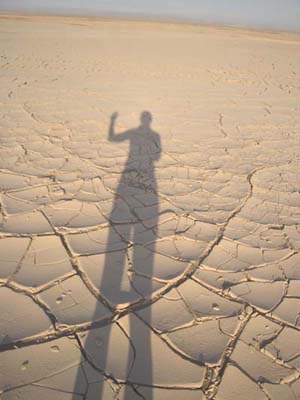
[Above: Nancy's shadow reflected on the floor of the Atacama Desert.]
My mom always taught me, if I don't have anything nice to say, I shouldn't say anything at all. The problem is, today is my journal day, and I have to say something. My job is to tell you fine people what is going on here on our little road trip. So, with that in mind, I will search for something nice to say. Hmm let's see something nice
I can't think of anything nice, so that'll have to come later. I'll keep my whining to a minimum here. I'm angry because we just drove all night. I mean, we got up, started driving, ran out of gas because we haven't filled our Scepter jerry-cans since emptying them to ship the Land Rovers to Ecuador, and then just kept right on driving through the night. For that reason, my journal starts just after midnight, at the very birth of Thursday. Gosh, I wish I had something nice to say. I could torture you all with an ultra-marathon of a journal.
After running out of gas and scrounging enough liters off the locals to get us to the next station 90 km down the road, we had a "team meeting" to discuss whether we would press on or camp. It was one in the morning by this time, and we had a whole lot of desert ahead of us. Oh, and don't worry; we still haven't filled our jerry cans, so there's a good chance for more high-drama in the future.
I wanted to make camp, and, apparently, so did Justin. We have 1000 km to Santiago, and we don't want to get there on the weekend. We need to get there before the weekend so the local Land Rover dealership can start performing routine maintenance on our vehicles. (Also, we're running Mobil 1 in each of our vehicles, for the whole 34,000 miles, without changing our oil, and we are supposed to send back oil samples for testing every 10,000 miles. We're going to draw those samples in Santiago. We like participating in this test, because it'll be fun to help prove what we already know: that Mobil 1 is great.)
So, we put it to a vote whether we would camp or push on for another hour. Knowing full well that we would never stop after an hour, and feeling like it's wiser to camp at a known, secure position to sleep and then wake up fresh, I voted to stop. Justin voted to stop. Todd was duped into thinking we'd actually stop after an hour and voted "go", as did the rest of the team. We decided that getting to our destination is more important than sticking to our safety procedures. Decisions such as "not driving at night" are pre-made, written-in-stone decisions. They are made ahead of time so that the expedition members don't have to risk making a poor decision later on when they are affected by lack of sleep or are caught up in the excitement of the moment. Putting the destination ahead of the safety and common sense is not acceptable, in my opinion.
I find it impossible to sleep in the passenger seat while somebody else drives at night, so I drove while Todd slept. Shortly after sunrise, we pulled over for a driver change. I crashed hard and barely mustered the gumption to wake up for lunch. We hit an Internet café and grabbed some chow. The fish I had was so good, I think I want to eat fish and only fish the whole time we're in Chile. (There! I did it! I said something nice!)
Shortly after getting back on the road, I fell asleep again. Because we drove through the night and I am completely wrecked, I won't have too many pictures of Chile. At nightfall, I took over the driving again, and we drove until we arrived in Santiago at about three in the morning. Oh! Woops! I guess that means it's no longer my journal day! It's Friday, so I'd better stop writing. One more positive item: Santiago is beautiful. It's clean. The people are nice. Chile is reminding us all of California, and we're all homesick now.
I'm not mad; I just need some sleep.
Best to all,
Nancy
nancy@drivearoundtheworld.com
P.S. - This is Day Two of our maniacal marathon drive to Santiago. I will never be able to recover from two all-nighters on the road. I slept some during the day while Todd drove. And drove. And drove some more. I'm missing much of Chile, but I'm learning a lot about the back of my eyelids. The part of Chile that I wasn't asleep for looks a lot like southern California. We drove from the desert highlands to the coast, and everybody agrees it is California-esque. We stopped at a mall today to eat, and I'm happy to report that consumerism is alive and well here. I's a shock being back in a wealthy nation after traveling through the 3rd World for so long. Something tells me we'll have fun in Chile. We arrived in Santiago at 3:30 in the morning after fighting the sleep monster all night. I wonder if we'll ever recover. Tomorrow, we have an appointment at Land Rover Santiago to have maintenance done on our vehicles. (N.O.)
| Logbook for January 22nd, Day 83 | ||
|
Start: Somewhere in Chile, 0715 S: 25* 53.620' W: 70* 27.993' |
Finish: Santiago, Chile, 0330 S: 33* 26.913' W: 70* 40.034' |
Mileage: 599 |
January 23, 2004

[Above: The cityscape of Santiago, Chile.]
Latin American cities. At this point I've been to a lot of them and I'm kinda sorta getting bored of them. Yeah, there's lots to do at night, but what of the day? I'm not really one for museums, so they're out. What's left, parks? well I've seen enough of those to last me a while. Usually, i just end up in internet cafés writing my blog, and then spend all night out on the town. Take yesterday for instance. I got up, I ate. I read my book (Solomon's Song) for a long time, and then I went out on the town until six something in the morning. Today, I slept it off until 4:40, although I think I was still sleeping off that 40 hour drive we did to get here. Anyway, the city thing just isn't doing it for me; I definitely prefer towns. Contrary to popular belief, there's actually usually more to do in towns. Or at least, those things to do are a little easier to find. Anyway, hopefully, Neil and Adam and I will be heading to the beach for two days tomorrow while the team waits for thier cars to get out of the shop. It's about time we had a little beach time, its been a while.
P.S. - After driving until 0330 this morning, we got a couple of hours of sleep before having to be up to move our vehicles at 0730. We are so not firing on all 8 cyllinders, mentally. The visit with Land Rover was a good one, and our vehicles are there receiving the once-over now. Adam and I came directly home to our hostel after Land Rover, taking advantage of Santiago's fantastic public transportation system. Their metro is ultra-modern and super-clean. I put my head on my pillow at 1:00 p.m., and I didn't wake up again until about 9:30 the next morning. We may never catch up on sleep from our two days of nonstop driving, but I'm certainly going to try. (N.O.)
| Logbook for January 23rd, Day 84 | ||
|
Start: Santiago, Chile S: 33* 26.913' W: 70* 40.034' |
Finish: Santiago, Chile S: 33* 26.913' W: 70* 40.034' |
Mileage: 000 |
January 24, 2004
Right now, we are as far south of the Equator as California is north...Today we slept in and then woke up to begin working on our individual task lists. I was going to do a lot of writing, but I rode my Santa Cruz mountain bike, instead. Todd paid an educational visit to a pre-columbian art museum, Nick and Justin had an interview at Land Rover with the popular local news network, and everybody else did their own thing. I rode for two hours, picking my way through the city streets to wind up at the Land Rover dealership. There, I hung out with Nick and Justin for a while, and then the three of us got a ride to a local mall to eat. It could easily have been a California mall. Same shops, same prices, same weather. We had our first Starbuck's coffee since the expedition began, and then we caught a bus to the metro to come back to the hostel. We rested a bit before jumping back on the metro at about 9:30 to meet Francisco from Land Rover for some dinner. We had sort of a weird night out before returning to the hostel. Santiago's party scene wasn't as great as we thought it'd be. Tomorrow, more work. (N.O.)
| Logbook for January 24th, Day 85 | ||
|
Start: Santiago, Chile S: 33* 26.913' W: 70* 40.034' |
Finish: Santiago, Chile S: 33* 26.913' W: 70* 40.034' |
Mileage: 000 |
January 25, 2004

Nick and Chanda sit at their laptops in an Internet cafe in Santiago. Working, as usual.
Today was basically a "do what you need to do" day for the team. Most of us slept late and then went to work on the programs for which we are responsible. Most of the team spent much of the day in the awesome local internet cafe. I've a sneaking suspicion that some played the cafe's hugely popular computer game, Counterstrike, which is available at their webpage at www.frag.cl. The place is packed with young boys screaming and yelling as they shoot things to bits. Justin visited a museum and spent some time wandering the city. I spent most of the day writing in my room and in the cafe. I apologize for the boring entry here. Tomorrow might be much of the same...Oh, one note of warning: If you go to Domino's Pizza, especially in a foreign land, DO NOT order the Americano. That means "extra cheese." The last thing anybody needs is extra cheese. It's about two inches thick on top of your pie... (N.O.)
| Logbook for January 25th, Day 86 | ||
|
Start: Santiago, Chile S: 33* 26.913' W: 70* 40.034' |
Finish: Santiago, Chile S: 33* 26.913' W: 70* 40.034' |
Mileage: 000 |
January 26, 2004
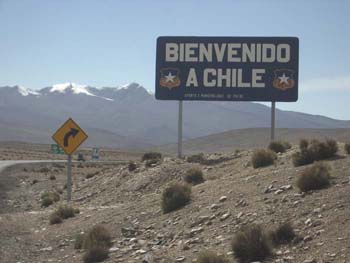
[Above: Welcome to Chile!]
We have been traveling through all of Central America and quite a bit of South America, and it has been phenomenal. I have been looking forward to seeing and experiencing many Latin countries for most of my life. I have always been fascinated with cultural differences and the various ways people live in foreign countries. Not only are the people very different in these countries, so are the landscapes and architectural structures. Many people live out of wooden shacks in the middle of the desert, as others live in walls made of mud bricks in the Andes. Not only the countryside, but the cities are extremely different as well.
So it is a big surprise to come to Chile. I was not expecting the state of economic wellbeing. Chile is completely different than all the countries we have driven through so far. In fact, it is almost as if we just went through a distance warp back to California. Chile is a very close replica of California. The buildings are modern, the roads are perfect, the landscape is the same, and people are much more image-conscious and stylish. We are actually traveling the same latitudes as California, which explains why the climate and landscape is just like home. In the Santiago area, it is much like San Diego and L.A. climate, which is desert planted with vegetation. As we travel south, it is like going into Northern California with the rolling hills and trees everywhere. There are also tons of vineyards as well. And, the people are no longer dark, they are all very Caucasian, coming from European descent.
So to tell you the truth, Chile is the least interesting country I have been to so far, as far as culture goes. We are still heading south and I know that the landscapes of Tierra del Fuego and Patagonia and all the other majestic places will be filled with incredible beauty. It is like driving from Southern Cal up towards Canada and Alaska, intensely beautiful. It is just funny how similar the people are to home. It doesn't feel like a typical Latin American country.
Today, we didn't drive anywhere. We are in Santiago and our Land Rovers are being serviced. I was busy finishing up editing photos for our sponsors, and the rest of the team was busy doing other things as well. Whenever we have a change to have time in a city, we tend to get a lot of busy-work done. We were also waiting for Rolf to arrive from Cusco. He was sick and had to write some articles, so he stayed back a few days. We went to this Internet cafe that literally had about 50-75 big screen computers. The place would fill up with kids playing these computer games against each other. It was pretty wild to see. I guess it is our modern day arcade.
We ended up taking the subway, which is a very nice metro station, each one individually decorated with paintings or tiled walls, etc. We took it to a part of town called La Suecia, which is a few streets that are filled with wonderful restaurants and bars and discotheques. They are filled with people, and employees on the street trying to pull you in to each various establishment. We ate some tasty food and had some delicious milkshakes. This street is kind of like a mini-Disneyland, with themed restaurants and fun places to hang out. Everyone there was in their most stylish outfits. It was an evening out on the town, Santiago style.
Santiago is a very big city, and is spread out, like Los Angeles is, the main difference is that instead of having 6 lanes for cars, Santiago has 2 lanes for cars, and 3 lanes exclusively for buses!!! I have never seen so many buses; it is amazing. They have a great public transport system in Santiago. You can get from one end of the city to other for 45 cents.
Well, we are leaving Santiago soon to go south and I am looking forward to hitting Pichilemu and going surfing, as well as heading all the way south into the deep countryside. I think it will be some of the most beautiful nature we have seen yet.
Until next time,
Neil
neil@drivearoundtheworld.com
P.S. - I'm not sure about the rest of the team, but I sure had fun today. Nick and Chanda spent ALL DAY on their laptops in the internet cafe. Todd, I know, had a blast with his Chile family, with whom he spent a lot of time several years ago when visiting and working in Chile. He had a nice reunion yesterday and today. I rode my Santa Cruz bike to Land Rover. On the way, I stopped in a bike shop and had an excellent conversation with Jose, the owner, for about 40 minutes. He admired my bike, and we had a great discussion about bikes in general. Oh, how I love bikes. He was saying I should look into the international bicycle industry. Travel, decent money, and BIKES. I'll consider it. I continued my ride through the perilous city streets of Santiago after bidding Jose a fond farewell, and my round trip ended up being about three and a half hours. Well, that's what I call a good day. The team had a mellow evening. Nick and Chanda had Indian food at Best Western, Justin and I had sushi at a local joint, and Todd saw his Chile family. I haven't seen much of the film guys, so I'm not sure what they were up to.
IMPORTANT NOTE: Rolf is back with the team after spending much time in Cusco, Peru, writing some articles. Poor guy, though, the only person he saw all day today was me. He saw me leaving and returning. Tomorrow, we all head to the beach! (N.O.)
| Logbook for January 26th, Day 87 | ||
|
Start: Santiago, Chile S: 33* 26.913' W: 70* 40.034' |
Finish: Santiago, Chile S: 33* 26.913' W: 70* 40.034' |
Mileage: 000 |
January 27, 2004
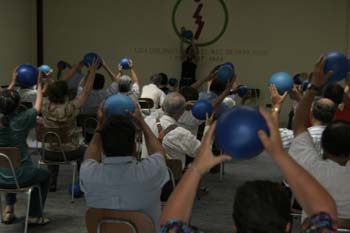
[Parkinson's patients undergoe physical therapy at the Parkinson's League in Santiago.]
On our last day in Santiago the cars had been repaired at the dealership (minor repairs) and we had a stop at the city’s only Parkinson’s Clinic. I went there with Todd, Colin and Neil while the others picked up the cars. Todd wanted us to film an interview with Mr. Gibson, a dentist who had come down with Parkinson’s 15 years ago. He was in pretty bad shape with the disease, you could tell he knew what he wanted to say and where he wanted to move but his muscle control and the constant shaking of his head and arms was pretty debilitating. The interview suffered as a result and very little personal story was conveyed. This in part was due to the fact that a woman from the clinic came in as his sidekick and answered many of the questions for him.
We watched the patients do group physiotherapy exercises to the chants of an instructor and quickly it was evident at the different stages of degeneration amongst the group. As I watched I imagined that despite the fact that they were all headed for the same process of nervous destruction some must have been feeling better off than the people who could hardly move there in their chairs. Occasionally you’d see one patient slowly get up out of their chair and shuffle over slowly to help another pick up a ball or an elastic exercise band to start the next set of exercises. I tried to imagine myself sitting in those chairs raising my shaking arms above my head with every ounce of effort knowing how easy it once was and immediately every pain and complaint I had waned in comparison.
P.S. - We're on the coast. After a pleasant drive west from Santiago, we have arrived in the pea-soup-like coastal fog of Pichilemu. More specifically, we are in the middle of a cow pasture on a point called Punta Lobos, or Coyote Point (unless lobo actually means wolf, in which case we are at Wolf Point.). Haven't seen any coyotes, but we have seen a herd of horses. We picked our vehicles up in the morning, and morning turned into afternoon, and then we had a visit to a Parkinson's research center in downtown Santiago before loading up and driving out to Pichilemu. The waves are enormous. I can hear 'em, but I can't see 'em. They sound like a roaring freight train. Tomorrow, Neil and Adam will surf them....yikes... (N.O.)
| Logbook for January 27th, Day 88 | ||
|
Start: Santiago, Chile Time: 0930 S: 33* 26.913' W: 70* 40.034' |
Finish: Pichilemu, Chile Time: 0200 S: 34* 25.787' W: 79* 02.601' |
Mileage: 189 |
January 28, 2004
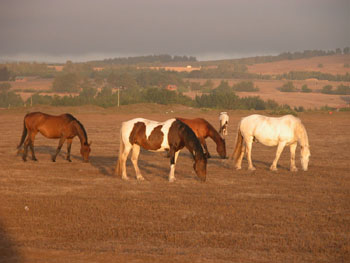
[Above: Horses grazing near the beach we camped at in Pichilemu.]
We drove hard yesterday and this morning we woke up in the middle of a pasture, horses and all. The view was tremendous, ocean on three sides and a flat plain looking over the ocean below. It is always important to find flat ground when camping, otherwise we roll from one end of the tent to the other, which is truly uncomfortable for those involved.
We have been working really hard for the past couple of months so we decided that we could take the next few days easy and enjoy the sites of southern Chile. Nancy was the first one up, after unharnessing her bike she went for a ride. I am not sure where she went, but lucky for us she returned with about 2-dozen eggs, ham, cheese and bread. By the time I rolled out of my tent the camping equipment was being set up. Coffee, as usual was the first thing on the agenda and Rolf and I got to it. Quoting the line, “ Sun is coming up, got cakes on the griddle”, inspired me to throw on my newly purchased John Denver album.
The film guys had made their exit, searching for the perfect wave, and Nick and Chanda had left on a little stroll, which left Nancy, Rolf and I to hold down the fort. Nancy did most of the work, making breakfast, but we kept her company.
The breakfast was one of the best we have had in a long time, and I for one kept eating as long as she was serving.
The rest of the day consisted of everyone doing what they wanted do, except Nick, who was beginning to get sick again, hopefully that won’t last long. I worked on writing up the recent Parkinson’s clinic visit, which inspired me and reminded me again what this expedition was truly about. We really want to publicize information on the various Parkinson's communities around the world; what they are doing, the challenges they are facing, and the global impact this disease is having. Also it is important for us to help assess whether the disease is growing or staying about the same percentage-wise in the population.
As night fell Nancy and Colin made a wonderful of dinner of pasta and red sauce. We watched the wet fog blow in from the ocean listening to Ravi Shankar and mused about whether Nora Jones was really his daughter. Soon the moisture became too much and we all took refuge from it, as one by one we slipped into our tents to escape the wet evening.
Todd
todd@drivearoundtheworld.com
| Logbook for January 28th, Day 89 | ||
|
Start: Pichilemu, Chile Time: N/A S: 34* 25.787' W: 79* 02.601' |
Finish: Pichilemu, Chile Time: N/A S: 34* 25.787' W: 79* 02.601' |
Mileage: 000 |
January 29, 2004
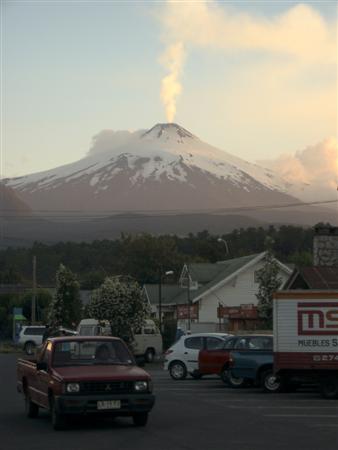
[Above: The Villarrica Volcano blows smoke outside of Pucon, Chile.]
We woke up drenched in mist this morning. Huddled up wagon-train style in the middle of a horse-and-cow pasture beside the ocean, we had allowed ourselves to drift off to sleep without securing our campsite or even zipping our tents. The tranquility of the previous evening and our lazy day seduced each of us into dropping our guard. When we awoke with wet sleeping bags, we realized our blunder.
You see, mist is a silent soaker. Had it been raining, or had it so much as smelled like rain, we would have properly staked out our window awnings and zipped up our doors. As it were, everything was left wide open so we could enjoy the cool breeze and the briny scent of the ocean. The previous evening had been misty, too, but nobody other than The Corndog, who sleeps in a tent on the ground, woke up wet. Heck, I had slept on the ground in a sleeping bag and bivy the night before, and I was fine. Who knew?
So, wet and sleepy, but without dampened spirits, we awoke and fired up the Coleman stove. We would have two huge pots of delicious Land Rover Caf before packing up camp and heading out to the Autopista toward Pucon, Chile. As soon as the sun came out, the mist burned off and revealed a perfectly warm and sunny day. We had 460 miles separating us from our destination, and we were determined to get there.
Pucon is the adventure/outdoor capital of Chile, and we were ready to play. The speed limit on the Autopista is 120 kph, and our Land Rovers were chomping at the bit. We made great time, arriving in Pucon by 8:00 p.m., and our arrival did not go unnoticed. Actually, people practically lined the streets to witness our caravan coming through the small town preceding Pucon. By the time we’d arrived in downtown Pucon, people had heard of us.
As we were searching for a cheap hostel, somebody walked up to Justin and asked who we were. He said word had spread like wildfire, and the whole city was wondering who was driving the four Land Rovers. We also met a cute young river guide from Sur Expeditions, Rodolfo, who said he’d love to try to get the team a good deal on a rafting trip. He also said he’d see what he could do about discounting my guided summit of the Vulcan Villarrica. Villarrica is an active volcano overlooking Pucon, and you are only allowed to climb with a guide. On the night we arrived, it was smoking and glowing red at the top. I was in for an exciting view on the summit.
We found a nice deal at Cabanas Newen, a summer-camp style cluster of cabins just off the main street. We rented two for the nine of us, and I slept in the top bunk above Todd. Rolf got the single bed in our room, and Nick and Chanda were in the “matrimonio” next door. Justin and the “film guys” got the other cabin. Ours is an awesome little place with a kitchen and a small living area.
Justin, Neil, Adam, and Colin were the only troopers with energy enough to hit the town our first night, so the rest of us hit the hay. It was wonderful sleeping in a real bed, and I reveled in the chilly air and my warm blankets. The nights are nice and cool, just like I like Ôem. The latitude of Pucon is the same degrees south as Big Bear, California, is north. This place reminds us of home, and while that is a good thing, we all feel a little homesick for friends and family.
I fell asleep quickly, happy in the knowledge that just one day of work in beautiful Pucon separated me from a much-needed jaunt up a mountain. I can hardly wait.
Nancy
nancy@drivearoundtheworld.com
| Logbook for January 29th, Day 90 | ||
|
Start: Pichilemu, Chile Time: 0930 S: 34* 25.787' W: 79* 02.601' |
Finish: Pucn, Chile Time: 2000 S: 39* 16.518' W: 071* 58.461 |
Mileage: 460 |
January 30, 2004

[Above: Nancy's photo of a crevasse on the Villarrica Volcano outside of Pucon.]
Well, it's Friday, my blog day, and the Drive Around the World team is here in beautiful Pucon, Chile. Pucon is a tourist town, centered on a picturesque lake and ringed by snow-capped volcanoes. Being here, I can't help but to be reminded of two other towns I have visited in my travels -- Lake Tahoe in California and Lake Wanaka in New Zealand. There is a certain vibe in these mountain lake towns that is very distinguishable, and I’m sure there are fifty more towns in this world that are very similar vibe-wise.
Activities are similar in all of them. Lakeside lounging put aside; the not-so-fainthearted are offered many opportunities to get their blood pumping. Rafting, kayaking, snowboarding, mountain climbing, skydiving and the like are all offered at most of these towns and the tourists take the opportunities at every chance. I know the majority of our team will be going rafting tomorrow and I am very excited to get some long-needed adrenaline into my bloodstream, all this driving has been making me lazy.
P.S. - Today was a work day our "film guys", Neil, Colin, and Adam, spent the day taking the sponsorship photos we still needed. They have a wonderful backdrop here with the volcano and the lake. Nick and Chanda spent most of the day readying and updating our webpage. Todd worked on our educational site. Rolf worked on his many articles and writing projects. Justin wrote a zillion press releases, and I wrote and edited. I also toured the town on my Santa Cruz. Tomorrow, most of the gang, excluding Nick, Chanda, and myself, will haul-butt down river rapids in a giant raft. Nick and Chanda will be working...I will be climbing the Vulcn Villarrica, which is a tiny little 2800-meter (8,400 ft) active volcano. It has been smoking since we've been here, and tonight, we saw its top glowing red with molten lava. I hope it doesn't choose to burst while we're in town! The weather here is brilliant. Warm and sunny. We all want to live here! (N.O.)
| Logbook for January 30th, Day 91 | ||
|
Start: Pucn, Chile Time: N/A S: 39* 16.518' W: 071* 58.461 |
Finish: Pucn, Chile Time: N/A S: 39* 16.518' W: 071* 58.461 |
Mileage: 000 |
January 31, 2004
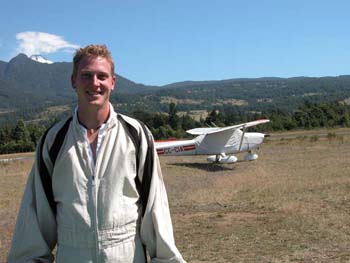
[Above: Justin prepares to go skydiving on his 30th birthday.]
I walk briskly through the trees on the edge of the river. The leaves crunch under my feet as water slowly drips into the dust. A quick dart past the bamboo sprouts and thorny bushes leaves me scrambling down some bowling ball-sized stones into a small washout. Paddle in my hand, I hurry up the other side to the top of a large boulder to keep up with the team. Once on top, I gaze down to the rapids and look at a 12-foot drop off. Are we really supposed to raft that? The team shouts, “Geromino!” and we hurry back to where we started…
We are in Pucon, Chile -- the adventure sports capital of Peru. It is a town very similar to Lake Tahoe, California, with the exception of the pretentiousness. It is a place that is still developing, as is evidenced by the rows of new condominiums under construction. This place is very different to other Latin American locales we have found ourselves in recently. There are very few overtly visible signs of poverty, and this is a place where those with money in Peru spend their vacations.
Today is the last day of my 20’s. In a few short hours, I will turn 30 years old. In order to fully appreciate my last day of “youth”, several members of the team and I are going whitewater rafting. After a quick breakfast of huevos revueltos con jamon y queso (scrambled eggs with ham and cheese), we meet our river guide for the day, Rodolfo. He is a young Chilean in his early 20’s with a thirst for life and a love of the outdoors. He spends the Chilean summers in Pucon working as a guide to give touristas the best possible experience they can have with their short amount of time in Pucon. This coming winter, he will move to Canada to do similar work and to see more parts of the world.
Rodolfo load us up into the back of a small pickup truck, equipped with benches lining the sides of the bed. Seated military style, with dust blowing all around us, we head to the river where we will get our daily dose of adventure. When we arrive, several team members don pale pink and beige wetsuits that vaguely remind me of stretch pants worn by hair band front men in the late 80’s. Added to that are full life vests and small helmets which make us look like we are prepared to bounce off anything that comes in our path. We are truly a sight to see. Thankfully, none of us has brought a camera to capture this moment. We look ridiculous.
After a quick safety briefing, we put the raft in the water and shove off. We review some team paddling strategies and the commands that will be used today on the river. They are simple, and the team nods in understanding as our raft begins its one-hour drift down the river.
Today is the perfect day for this. The warm sun heats our suits and skin keeping us comfortable as the cold water splashes around us. As a wake-me-up, Rodolfo recommends that we jump (more like fall) out of the raft to enjoy the crisp, clear water. It is refreshing to say the least. At first, the water is a shock to the system, sending sharp sensations all over my body. I come up for air, the cold water boldly energizing my mind and spirit. Slowly, we climb back into the raft and charge toward our first group of rapids.
They are a small set of rapids used by the guides as a warm up, first to set the tone for the day and second to evaluate the skill of the paddlers. We pass the test with flying colors. As we turn around to look back up the river at the rapids we just crossed, we now change our opinions on having a camera along for this journey. We continue down the river, bouncing and splashing as we go. First over a set of rapids that sprays Colin and Todd in the front. Second, over a vicious set that bounces Todd out of the front and basically into Rolf’s lap one row behind and on the other side of the boat. The third set twists the boat in both directions sending all of us sprawling around the boat, but no one was lost.
As we pass each subsequent set of rapids, we all cheer and laugh, recounting the last several days of the expedition. The team has adopted the battle cry of “Geromino!” (yes, Geromino -- not Geronimo) -- an exclamation that made it’s way into our lexicon late one evening as we were discussion the smell of a local beverage. For the full story, buy me a beer sometime. It is worth recounting.
Rodolfo directs us to steer the raft over to the side of the river so we can conduct a reccie to survey a particular challenging portion of the river that most tourists are not allowed to traverse. We stand high on a boulder overlooking the charging rapids, our bravado quickly placed on the shelf as we witness how difficult this drop off is. In addition to a drop twice the size of anything we’ve covered today and a faster than normal water flow, there is a small obstacle in the middle of our path. A volkswagon-sized boulder splits the river in two. On one side, the safer route that ties back into the river over manageable rapids. On the other, a choppier set of rapids with a rip current that could potentially pin a person under the water’s surface if any of us are unfortunate enough to be pulled from the raft.
It is a gut check for sure. Rodolfo repeats that we must decide to ride the rapids or portage around them as a group, and that the risk involved with this portion of the river is sizeable. A quick glance around the group reveals the answer -- devilish grins and thumbs up. Let’s go!
We load into the boat and charge the rapids. “STRONG! STONG!” the call comes from the back. Everyone paddles furiously to get up the speed necessary to keep from folding the raft in half as we approach the boulder. Feverishly, we paddle, echoing Rodolfo’s commands to the front men over the roaring sound of the river and the rapids immediately in our front. A rush of cold water sprays the team as we drop in and begin flailing at the mercy of the river. “RIGHT SIDE!” comes the call, and everyone on the left side of the boat slides to the right edge to keep the raft from tipping over. The chaotic movements of the boat cease, and the raft gently drifts in a counter-clockwise motion enabling all of us to see our accomplishments. With a final cry of “GEROMINO!” we raise our paddles over our heads to clack them together as a group, triumphant.
As we drifted down the remaining part of the course, I soaked in every drop of beauty around me, considering the option of jumping overboard to let the river carry me freely down the last part of the course. I leaned backward and drop into the water over the side of the boat for one last time. As I free floated in the cold, clear water -- out of control and at the mercy of the river, I was reminded of a phrase that has served me well in the past. “Only after you have let go of everything are you free to do anything.” And that’s so true, especially with life on the road. Sometimes in order to control over the things in life that truly matter, you must give up control over everything else in order to gain a fresh perspective. Bring on my 30’s…
Until next time, I wish you well from the far side of the world.
Justin
justin@drivearoundtheworld.com
P.S. - We were to find out later that one of Rodolfo’s best friends passed away while kayaking in Chile the day we were out on the river. A not so subtle reminder that life may be short for any one of us, and that we should take advantage of every day we’re given.
P.P.S. - The weather and the activities of the day were perfect. I had to wake up at 0630 to get ready and meet my climbing party at Sur Expeditions, which is just down the street. I've never hired a guide for a climb, and it's not my preferred method, but I didn't have a choice with Volcn Villarrica. I don't know the mountain well enough to go alone, and they don't let people climb without a guide, so I shelled out some cash to climb with strangers. It was worth it, though. I met a nice Dutch couple, Angle and Menno, I made a new friend in Pedro, our guide, and I saw LAVA! It splashed violently out of a crater at the volcano's summit, and we all braved choking gases to peer in and take pictures. It was truly amazing to witness, and I have photos and mpegs. The volcano is only about 8400 feet high, but it took us forever to stroll up it. We arrived at the top at noon, and I had a 12:00 phone call to make. I broke out the Iridium satellite phone and called Paul Bryan's radio show in Chicago. It was my third call to Paul during the expedition, and I am to call my buddy Paul every few weeks to let him and his listeners know what's happening on our expedition. I became friends with him during the Land Rover G4 Challenge, and I really enjoy being on his program. Check it out "Drive Chicago" on Chicago's WLS News Talk AM 890, if you'd like, Saturdays, 9-10 a.m., Central. It was fun being on the air in Chicago while sitting on a ledge on a mountain in Chile. As we were sliding down in the snow on our butts (glissading), I realized the rest of my team was beginning their 2:00 descent of Rio Trancura with their rafting guide. Apparently, they all had a great time, and they were impressed with themselves and their teamwork abilities. I think they had a good, macho, guys'-day-out. We all arrived home at about the same time, and we swapped stories. Later, I watched The Pricess Bride with Colin, and the other guys went to the lake to chill out in preparation for Justin's birthday festivities. He turns the big 3-0 tomorrow... We hit the clubs at about 1:00 a.m., and the guys danced up a storm. Adam is an AMAZING ballroom dancer. You name it, he can dance it. Rolf and Chanda and I left after just two hours, because we were beat (and bored), but I don't thing the guys made it back until the wee hours of the morning. It was a great day. (N.O.)
| Logbook for January 31st, Day 92 | ||
|
Start: Pucn, Chile Time: N/A S: 39* 16.518' W: 071* 58.461 |
Finish: Pucn, Chile Time: N/A S: 39* 16.518' W: 071* 58.461 |
Mileage: 000 |
February 01, 2004
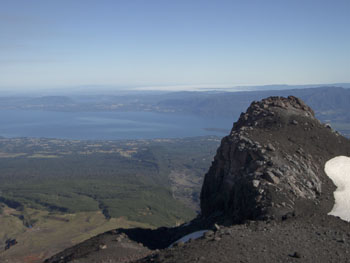
[A view of Pucon, Chile, from mid-way up Volcan Villarrica on Justin's birthday. Somewhere out there, Justin is plummeting from a perfectly good airplane.]
Today was for work and for play. I did some writing, basically putting together an article and captioning some photos for the Royal Geographical Society. Nick and Chanda worked on sponsorship deliverables and website stuff all day. Todd worked on the education website. Most of the boys went to the lake. Justin jumped out of an airplane. Today, he turned 30, so he treated himself to an airborne exit from a perfectly good aircraft. I tooled around on my Santa Cruz and inquired about renting a sailboat. I can rent a Lazer (small boat) for 5,000 pesos (about $10) per hour. Maybe tomorrow...Corndog is interested, too. We have one more day here in Pucn. (N.O.)
| Logbook for February 01, Day 93 | ||
|
Start: Pucn, Chile Time: N/A S: 39* 16.518' W: 071* 58.461 |
Finish: Pucn, Chile Time: N/A S: 39* 16.518' W: 071* 58.461 |
Mileage: 000 |
February 02, 2004
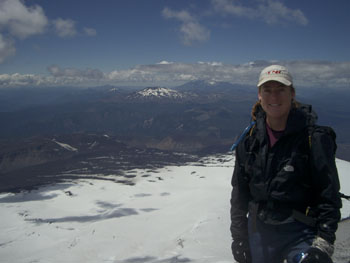
[Nancy poses at the top of Vulcan Villarrica in Pucon, Chile.]
Well, again, Nick and Chanda (and Todd, of course) worked all day long. Justin, too spent the day typing. He never left the internet caf all day, as far as I know. Diligent boy--err, I mean man. Diligent man. He did just turn 30, so I guess mama's little baby's all grows up. (I'm quoting a movie, so don't knock my grammar!) Um, so, let's see...what did everybody else do today? There was a lot of time spent by all at the internet cafs. I cut Rolf's hair, and very badly I might add. I gave him a little bald streak, so it looks like he got in a fight with a mountain cat. Colin and Rolf cooked steak sandwiches. We all watched "Monsters, Inc." and then several episodes of my all-time favorite show (next to Seinfeld), "King of the Hill." That's about it. We leave tomorrow, and it's probably about time. We get restless staying in one place for so long, even when the place is as cool as Pucn. (N.O.)
| Logbook for February 2nd, Day 94 | ||
|
Start: Pucn, Chile Time: N/A S: 39* 16.518' W: 071* 58.461' |
Finish: Pucn, Chile Time: N/A S: 39* 16.518' W: 071* 58.461' |
Mileage: 000 |
February 03, 2004
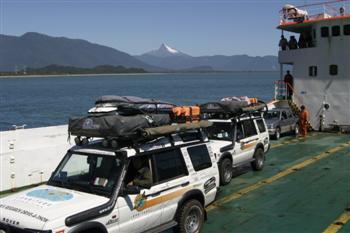
[Above: Drive Around the World vehicles offloading the Chaiten after an overnight ferry ride across the Gulf of Ancud.]
We left Pucon with a few emails and a 5-hour drive south to Puerte Montt. From there we hopped onto a ferry that headed south across the Gulf of Ancud to Chaiten. On the ferry we were quite a spectacle. Families and travelers gawked at us as we climbed over the tightly packed Land Rovers down below their seating level. As the boat left port we began flipping open the roof tents and the questions started flying. Where are we going? Where are we headed? Colin was cornered by a girl from San Francisco and he has sort of lost his enthusiasm for explaining and so now he just gives one-liners like “yep”, “south”, “the world”. They are then left with little to recycle into another question and they tend to go silent.
After 12 hours overnight on the ferry with no food we drove off and entered the land of dirt roads -- from here until the tip of Argentina, about 1400 miles winding down the altiplano of Patagonia. Which brings me to where in am right now. Crammed in the back seat attempting to type on my laptop while bouncing over washboard roads. Neil, who is driving, has decided to make the trip absolutely agonizing by putting in one of his favourite CD’s, Madonna “Ray of Light”. It is so unbearable. I just instated a volume limit on the album but it’s still loud.
The car has slowly become adorned with bits and bobs from all over. A cow finger puppet from Cusco is hanging its head out of the tape player door, three sea urchins from the northern desert coast of Peru are strung from the rearview mirror, a rock with the Nasca monkey lines sits on the dash next to the newly added and perfectly preserved “Freddy” a massive flying locust/beetle with 2 inch long pinchers and four legs. The rest of the car lies in total disarray. Books, clothes, cameras, coffee mugs, empty cans of Red Bull and battery charger cables are tied together in one big knot and get shoved to the left or right in order to make way for a leg or a butt cheek. Signs of wear are showing on the rigs. Footmarks, dirt, scuffs and coats of dust from the road are slowly changing the color of the interior’s original tan. A week ago Nick gave us a lecture on taking absolute care of these cars so we can resell them for reimbursement and helping cover overhead for the expedition. Today he got his knickers in such a twist about leaving the campsite 5 minutes late for driving that he pulled his Land Rover out not seeing a massive felled tree to his right. The passenger door is now completely bashed in. The first real body damage is always the most painful; thankfully it didn't happen to me.
P.S. - We left later than intended this morning, because our "geeks" had an unavoidable stop at the local internet cafe to download images, etc., to our webpage. It is quite a long process, and the folks at the cafe have agreed to do it for us so we can get on the road. I had to guide everyone out of the driveway at our cabana, and I ended up putting D4 on top of a buried copper water line, breaking it off at the spickett...OOPS! The lady was so nice about it, though. We paid her the repair costs and were on our way. We have a lot of driving ahead of us. (N.O.)
| Logbook for February 03, Day 95 | ||
|
Start: Pucn, Chile Time: 2:00 p.m. S: 39* 16.518' W: 071* 58.461' |
Finish: Puerto Montt, Chile Time: 3:00 a.m. S: 42* 54.732 W: 72* 43.079 |
Mileage: 200 |
February 04, 2004
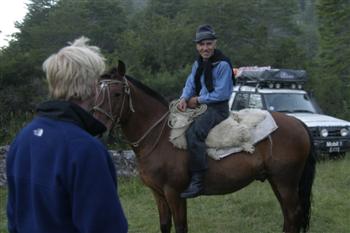
[Above: Todd talks to a Chilean gaucho along a river near Lake Yelcho.]
Nancy, Sebastian (my Chilean Brother), and I began the day sitting in a parking lot wondering if we were going to be able to catch a ferry with everyone else. We were all hoping the ferry would be full and if we would be able to set off on our own adventure driving south. We were the first to volunteer for solo driving duty, upon learning that there was only space for three more vehicles on the ferry. I think everyone was jealous that we had the prospect of driving for a day on our own.
Despite our hopes, the ferry people were able to fit us on the ferry. This made me a little nervous as my paranoia was raised by the thought of overloaded ferries. Oh well! We drove on and popped the tent. I think most of the passengers on ferry were jealous as we had the most comfortable spots on the ferry, despite the winds. Sebastian opted to sleep in the car so Nancy and I climbed into the tent and tried watching Monty Python’s Life of Brian on my laptop; however the wind was so loud that we could not hear so we just decided to hang it up and go to sleep.
We woke up the next morning well rested and excited to begin driving Chile's Austral Highway (austral means relating to the south). It is supposed to be one of the most scenic highways in the world; however it is reputed to be dangerous with all of its curves and crazy drivers.
Let me back up and introduce Sebastian. Sebastian is my Chilean brother. Chanda’s brother, Russ, and I traveled to Chile three years ago. During our trip preparation my "mother", who is a professor (both online and on site) at a junior college, had an online student from Chile. She asked him if it would be ok if I contacted him to ask him questions about Chile. He agreed to answer our questions and before we knew it he extended an invitation to us to stay at his house. Victor, my mother’s student, has three children, one of which is Sebastian. When Russ and I were in Chile, our new Chilean family took car of us and Sebastian and his brother Mattias took us all around. We have kept in contact every since, and Sebastian is joining us for the next week because he is on summer vacation, from his biology studies at university. (He has written up some information on wildlife in Chile, so be sure and go the education site and ask him questions!)
Back to our story: In the morning I met Sebastian talking to a couple of truck drivers who were transporting young salmon from the hatchery to salmon farms (fisheries). Each truck had about three tanks filled with finger-sized salmon. Apparently Chile is one of the largest producers of salmon, exporting 50% of their production to the United States. Another large producer of salmon is Norway. This made sense to me as I looked around. The southern Chilean landscape was carved out by large glaciers a long time ago. Glacier carving along the coastlines usually creates fjords which are large channels intruding into the landmasses. Norway, Chile and Alaska have fjords. The fjords are often zones where freshwater meets saltwater. For this reason I guess fjords are perfect for salmon production as salmon need to swim up to fresh water to lay their eggs, after the eggs hatch the young salmon will swim to saltwater where they mature. They only return to fresh water when they need to lay their eggs.
After our salmon lesson I spent some time watching the landscape go by. I saw ducks and even a pair of penguins fishing in the cold water. Sebastian and I were hoping to see dolphins and orcas. Snow capped mountains rose immediately from the waters edge and the sites were truly amazing.
For some odd reason, I thought the ferry would arrive at its destination very soon so I just continued to look around. Everyone I asked told me we would arrive at our destination in less than an hour. I kept looking around, not putting any sun block on, uffda!
Neil was playing his guitar so I joined him for about an hour. After about 3 more hours, around 3:00pm we finally arrived at our destination. The ferry ride took about 13 hours in total.
We went into town had some food, as we were all starved and picked up some supplies for the road. Chaiten reminded me of small towns in Alaska, it was an accumulation of buildings and not much more. It provided us food, respite, and gas; so what more can you ask for?
After taking care of our business we set out on the Austral Highway (La Carretera Austral). We quickly left pavement and the dusty gravel roads would carry us for the remainder of the day. We needed to get as far as we could as we are going to meet someone in Coyaique 400 km south of Chaiten. The drive was beautiful, but bumpy. This forced us all to take our noses out of our computers and look around at the spectacular scenery. I was pleased to see we were in a new ecological zone. After looking up some information we realized that we were officially in a temperate rainforest, very similar to the temperate rain forests in Washington state, characterized by very tall conifers, and an incomplete tree canopy (life tropical rainforest) offering opportunities for lower story broad-leafed plants and ferns to exist.
We drove until about 8:30pm (sundown is about 9:30pm). Scouting a place for camping we came across some land near a river. We were a bit concerned because we had to go through and open gate, but this place was perfect. It was only a stones throw from the road, it was completely invisible from the road, it was near a river, and it was really beautiful.
Soon, a Chilean gaucho arrived in our campsite mounted upon his horse. He just wanted to see who we were and he told us that there was no problem camping here. At this point we sent people to collect firewood and others began popping their tents. We saw a lot cool moss, it was red, and some interesting insects like deer beetles.
We built a campfire, cooked some grub, and enjoyed each other’s company. We all slowly trickled to bed knowing that we had to get up really early to make our next day's appointment.
Todd
todd@drivearoundtheworld.com
P.S. - It was touch-and-go getting D3 onto the ferry, and Todd and I were a bit disappointed when we made it. We had anticipated a day of driving and exploring on our own. But we were happy once we were aboard and sailing. It was a comfortable night's sleep in our Hannibal tents, and the view from the ferry when the sun came up was breathtaking. Patagonia's sunshine, snowcapped peaks, fjords, and wildlife (including penguins) made us all smile. (N.O.)
| Logbook for February 4th, Day 96 | ||
|
Start: Puerto Montt, Chile Time: 3:10 p.m. S: 42* 54.732 W: 72* 43.079 |
Finish: South of Lago Yelcho, Chile Time: 8:30 p.m. S: 43* 31.471 W: 72* 20.571 |
Mileage: 053 |
February 05, 2004
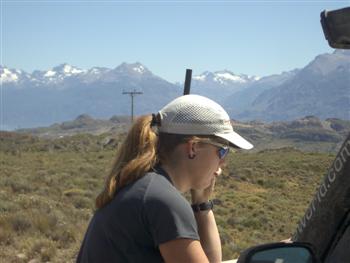
[Above: Nancy in the middle of a call to a radio show in Chicago, from the side of the road in Chilean Patagonia.]
Well, I have a lot of writing to do, so I need to try to keep this short. We have been driving south from Pucon for several days now, and we are happy to be traveling with an authentic Chilean, a friend of Todd’s named Sebastian Belmar, 24, of Santiago. He’s riding with us in D3, so we get to fire questions at him all day long about the sites we are seeing and the animals we encounter. He’s a biologist, and he has a real passion for wildlife. That’s something we have in common. We have seen nandus (Chilean emus), guanacos (wild critters that look like a cross between a llama and a deer), condors (world’s biggest bird), black-necked geese (endangered species), dolphins, and sheep, and I even caught a young armadillo.
We’ve been camping a lot during this leg of our journey, and we’re all pretty happy about that. With an extra passenger in D3 who needs a place to sleep, I have volunteered to sleep on the ground in my sleeping bag and bivy sack. It’s amazing to sleep under the stars, and you can’t find a better landscape in which to camp than we find here in Patagonia. We’re traveling along the Carretera Austral, which just happens to be the world’s most beautiful highway. We drive until we don’t feel like driving anymore, and then we pull over and set up our tents. Last night, we were on the banks of a raging, salmon-filled river. Soon, I’m going to buy some better lures so I can catch a fish! As we travel, we are treated to spectacular views of towering snow-capped peaks, brilliant blue lakes, crystal-clear rivers, and green-and-yellow fields. It’s a feast for the eyes, and it makes us all very happy.
I know today is Thursday, but I want to tell you about Saturday…two days from now. I will use the past tense, since I am a week late with this journal…
I met radio-show host Paul Bryan, 1983 Texas Chili Cook-Off champion and the voice behind a live program called “Drive Chicago”, last year during my stint with the 2003 Land Rover G4 Challenge. After the national selections for that, I was invited to call into his show for the first time, and we have had a wonderful friendship ever since. I saw Paul again in Colorado in July, at a media event for Land Rover’s TreK competition. It was then that I told him about my upcoming participation in Drive Around the World, and he invited me to call into his show every few weeks to give his listeners updates from the road.
I have called Paul, via Iridium satellite phone, from Costa Rica, Peru, the top of Vulcan Villarrica in Pucon, and, most recently, from 46 degrees south latitude in Patagonia. I have to share a piece of that experience, because I think a few young readers might get a kick out of it. (Also, I don’t think I’ve told my mom or any of my friends or family any of this. Two birds, one stone, you know.)
The way these calls work is, I call the studio, and they put me on hold to see if Paul is in a position to take the call right away. Then, either they come back on the phone, or I hear Paul introduce me before putting me on the speaker with him. He always has a very clever, very fluid and flattering way of making the introduction.
This time, I called during his special 3-hour (usually he has the hour between 9 and 10 a.m. CST) broadcast from the Chicago Auto Show. I was a little early, so I was on hold while he introduced and interviewed the guest ahead of me. I was tickled to hear him introduce tire-empire heir and star of The Bachelor, Andrew Firestone. Apparently, the hot young Firestone is single again, as things in the world of reality television hadn’t gone the way they “were supposed to.” (I am truly, truly sorry to hear that, Andrew. Is there anything I can do to help?) Andrew was on the air to invite people to stop by the Bridgestone booth, where he would be signing autographs and visiting with auto-show goers.
When Andrew hung up, Paul introduced me by saying that, if Firestone had any sense at all, he would hop on a plane down to, “Paraguay, or Uruguay, or wherever the heck Nancy is right now, instead of flying out to Chicago.” Hahaha! Thanks, Paul. That’s cute, and I truly appreciate your kindness and our friendship. I love calling in to “Drive Chicago”; it’s good for my ego. (I’m sorry I didn’t mention on the air that, while we think Andrew is cute, the team is proud to be driving with confidence on our super-sweet BFGoodrich mud terrains.)
Participating in Paul Bryan’s program not only gives me an opportunity to talk to a friend back in the States, but it also allows me to reach out to his audience and invite them to visit www.drivearoundtheworld.com to read about our expedition, participate in our free online education program, and contribute to Parkinson’s Disease research by entering to win a 2003, Certified, Pre-Owned Land Rover Discovery expedition vehicle, fully kitted-out with more than $15 K in expedition accessories, for a donation of only $10 (100% of which goes directly to the Parkinson’s Institute). We are struggling to get the word out about our expedition, so it’s a huge deal to get to talk to a wide listening audience on Paul Bryan’s “Drive Chicago.”
So, anyway, I just wanted to share that little morsel with you, and I hope you aren’t bored to tears. We’re still truckin’, and the next time you hear from me, I should be writing from the Ushuaia, the world’s southernmost city, at the very end of the world. El fin del mundo. Tierra del Fuego.
Take it easy, ya’ll.
Nancy
nancy@drivearoundtheworld.com
P.S. - We're driving along the world's most beautiful and most dangerous (debatable) highway, the Carretera Austral. Just picture mountains, fields, streams, and lakes, with zero polution, and a smorgasborg of wildlife. We're in Heaven, and we love camping whenever we can. Can't beat the scenery. (N.O.)
| Logbook for February 5th, Day 97 | ||
|
Start: South of Lago Yelcho, Chile Time: 7:00 a.m. S: 43* 31.471 W: 72* 20.571 |
Finish: Lago Elizalda, Chile Time: 10:00 p.m. S: 45*46.296 W: 72*43.079 |
Mileage: 250 |
Februay 06, 2004
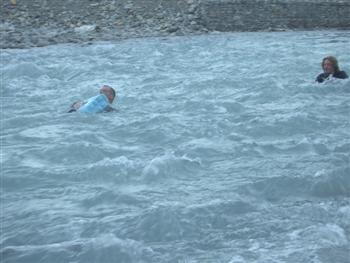
[Above: Colin rides the whitewater of the Rio Maiten in Chile.]
Well, the last few days were extremely interesting and I don't even know where to start so I just will. I spent some time in Pucon, a few days in fact, and I had a fun time, except (and as you know there is always an except with me) the last night there, someone broke into room and stole my laptop. So anyway, we left Pucon, Chile and drove south to a town called Puerto Montt, where we ate some snails and then boarded a ferry with our cars for Patagonia and the Carretera Austral, or the Southern Highway. The next morning we arrived in beautiful Patagonia, which really reminded me of the South Island of New Zealand. Anyway, its ridiculously beautiful there -- I mean, bright blue lakes, snow-covered mountains, all that stuff. We drove and camped and in beautiful riverside spot and did the same the next day, and the next, and on that next day we found a really cool campsite right on the river Maiten.
Rolf and I were feeling rather adventurous that day so we decided to do something crazy. We suited up in Adam and Neil's wetsuits, I grabbed my boogie board and Rolf grabbed a spare empty water can and we jumped into the river. I guess we were inspired by our rafting trip from last week and we just wanted to hit some rapids again. Anyway, the river was ridiculously cold at first. The first set of rapids we hit were really shallow, knee banging shallow. Rolf and I made it through all right and floated through a nice mellow patch to the second rapids, which were a little deeper. The speed of the water picked up fast and before we knew it Rolf and I were hurtling breakneck straight for a wall. We hit and my board was sucked under, I tread water frantically until my board reappeared and then looked around for Rolf, but he was nowhere to be seen, I only saw his floating water can, eventually he popped up, looking a little haggard.
We made it though that alive and floated down river a little. You see, about a mile down river was a huge lake (Lago General Carrera), and that was out target. We decided to keep going for it and were rewarded with some great rapids. Rolf continually was bumping into rocks due to his lack of a boogie board, although I was making it through unscathed. It was pretty funny to look back and see him floundering with the water container in his hand. Anyway, at one point we decided it was going to take too long to get to the lake, so we got out and walked back and did two of the fun rapids again. After that we once again emerged from the river and hiked the half mile or so back to the campsite, where the team had prepared a giant bonfire.
The bonfire was great. Huge even, and a lot of fun, although two unfortunate events did occur. First, I left my new spiffy sandals too close to the raging inferno and they shrunk a size and second, after it was all done, I was looking through the 190 or so pictures I had taken in the last couple of days and the memory card on my camera farted out and I lost all of them, which really sucked. Anyway, we rose the next morning and headed for Argentina, on our way to the beautiful glaciers of southern Patagonia. Hopefully the pictures I take there will make it so you can all see how awe inspiring this place is.
Rock on,
Colin
colin@drivearoundtheworld.com
P.S. - We drove all day through unbelieveable countryside and along dusty roads. There's salmon and trout in the rivers and lakes we pass, and Nick and I cannot wait to catch 'em. Soon. I feel it wil happen soon. We camped on Rio El Maiten this evening, an icy cold, fast-moving river flowing into a lake. Colin, on his boogie board, and Rolf, on a gerry can, hopped into the river upstream (in wetsuits) and floated out to the lake. It was hilarious to watch, and we have photos. The evening was capped off with one of the biggest bonfires I've ever seen. I'm not saying the boys are pyromaniacs or anything, but they are. (N.O.)
| Logbook for February 6th, Day 98 | ||
|
Start: Lago Elizalda, Chile Time: 8:00 a.m. S: 45*46.296 W: 72*43.079 |
Finish: Lago General Carrera, Chile Time: 8:00 p.m. S: 46*44.751 W: 72* 31.163 |
Mileage: 117 |
February 07, 2004
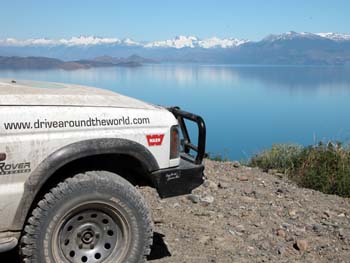
[A Drive Around the World Discovery takes in the view of Lago General Carrera in Argentina.]
Frequently when you travel, you are forced to make a series of decisions that could negatively affect your plans. At each point, you must weigh your priorities to determine what is most important to you. Additionally, you must consider the impact of your decision. If you decide to omit a visit to a location, does that really free up more time in or schedule, or does it cause you to miss seeing the most beautiful site in the world? Maybe it does both. Misinformation in these situations is a huge problem, and misinformation comes in many forms. It can be something as small as incorrect directions to a restaurant, or it could be information from a local describing a little place along your route that your cousin’s uncle’s nephew’s wife once heard about and said was amazing. As the navigator, misinformation is the bane of my existence.
This week has been no different. We are on day 99 of the LONGITUDE Expedition, and our route today takes us from Lago General Carrera in Chile to the amazing site of Perito Moreno, Argentina. Unlike most border days that call for a 6:00 am departure, our campsite from last night was so beautiful, the team took it easy this morning--our first decision of the day. We know that our route today will take us approximately 100 miles over rough and twisty gravel roads out of the mountains and into the high plains of Argentina.
The drive begins like any other day’s drive. The convoy slowly begins gaining momentum through the hills as we carve our way around the southern edge of the lake. As we continue to gain altitude, the bright-blue sky dotted with clouds has resulted in a mirror effect on the water that is beyond blue. The wind creates small crests in the water, and the reflected images of the surrounding snow-capped peaks dance for all to see. The best thing about this drive is that we are alone. In the 3 hours that it will take us to cross below this lake into Argentina, we will see about 6 cars, 2 horses, and one team of oxen, driven by a husband-and-wife team, pulling a cart. But for right now, this view is all ours. And it is spectacular. The road continues to narrow as we pass small settlements with houses built into the side of the mountains. Every place you see a large boulder that has fallen down from above, you see a small shack extending out, using Mother Nature’s gravitational reminders as permanent walls to conserve building materials.
We continue to the right past the bright-green sign that says Chile Chico, indicating that our border town is near. On the way, we pass a Land Rover Range Rover on the side of the road. It comes complete with middle-aged man, his wife, his son, and a cargo bay filled with new camping equipment. This is their first trip out, and their first flat tire with this car. This poor fellow unfortunately has never experienced the pure joy of changing a tire on an empty stretch of gravel road when it’s 90 degrees, and he has never had to operate a bottle jack in his life. So, we stop to lend a hand--our second decision of the day. Changing a tire is something everyone should know how to do, but through one reason or another, not everyone learns before the skill is actually needed. After a quick tutorial and some help, he is a pro.
Our border crossing is relatively quick, and after 90 minutes of filling out forms, we push on into Argentina. With very little ceremony, we have entered our 12th country of the expedition. The lake is now called Lago Buenos Aires in Argentina, and rumor has it that there is some very good fishing here. After some discussion on the radio, Nick and Nancy decide that they are going to pull over and try their luck while the rest of us continue on to set up base camp.
All of the information we have been given by people indicates that Perito Moreno is a “must-see” destination in Argentina. Our Lonely Planet guidebook says something different. According to the book, there is not one, but two Perito Morenos in Argentina. One is a small gateway town to the beautiful region of Chile we just left. The other is a park, complete with glaciers and wildlife, that is not readily identifiable on any map that we carry. After a considerable amount of studying three different maps, I find the second one. It is a park nestled against the Chilean border approximately 300 miles south of our actual destination town. The actual town of Perito Moreno is a bit of a dust bowl, inhabited by a couple of thousand people at best. It is no resort. It is no must-see destination. In fact, it’s not even a place that we’re sure we want to stay in. It is a pretty darn ugly place. Now, what do we do? We have to make a decision. Our options are stay here, backtrack to the lake where Nick and Nancy are, or continue further south to another yet-undetermined location. Given that it is almost 6:00 pm, there are no substantial towns on the map south of here, we have no place to stay, and only half the team is in convoy, we decide to find a place to camp and make the best of the situation. The reality is that tomorrow we have to cover a lot of ground, anyway. It will be an early start and a long drive.
Our decision to stay did not go unrewarded, however. We arrived in town on the night of the annual Festival Cueva de las Manos (Festival of the Cave of the Hands--a local archeological site), where we shared live music with the community. This is the type of experience that you cannot plan for. Virtually no information on the festival exists outside of this town, and our arrival here on the same date as the festival was based more in luck than on conscious decisions. It is certain we will not have time in our schedule to visit the fabled park of Perito Moreno that we have heard so much about, but sometimes you trade the cost of one decision for the reward of something much more special without even knowing it.
P.S. - Today at 6:09 p.m., we were officially stamped in and leaving the Argentine border to drive through our newest country. We had fun talking to locals at the border, and then Nick bought a rod and reel at the gas station in town. Here, Logo General Carrera became Lago Buenos Aires, Argentina's name for the same huge lake that is shared by both countries. On the way into our day's destination at Perito Moreno, Nick and I stayed behind to fish on the shores of Lago B.A. And would you believe it! I caught a trout! It was bigger than 2 feet long. Nick gave me a hard time for releasing it, but I just couldn't see the point in killing such a beautiful fish. Now ol' Walter will live to swim another day. Most of the gang went to a musical festival in town this evening called Festival Cueva de los Manos. The team is looking forward to eating steak as big as our faces! (N.O.)
| Logbook for February 7th, Day 99 | ||
|
Start: Lago General Carrera, Chile Time: 11:30 a.m. S: 46*44.751 W: 72* 31.163 |
Finish: Perito Moreno, Argentina Time: 8:00 p.m. S: 46*35.740 W: 70*55.547 |
Mileage: 97 |
February 08, 2004
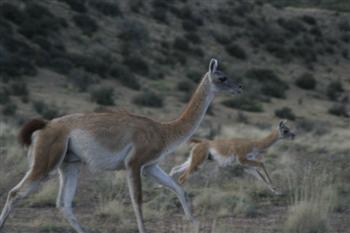
[Above: Guanacos on the run in Argentine Patagonia.]
Ever heard of a guanaco, rhea, or a huemal? How about a pudu or chinchilla? Well, these are just a few of the animals one has to look out for while driving across Patagonia. Not the typical four legged obstacle we try to dodge in the US.
Although there are many of God’s beautiful creatures in Patagonia, animal life is less diverse than in other parts of South America because of the barrier to migration presented by the Andes. For more information about migration in the Andes please read Sebastian’s article about the Andes. http://www.drivearoundtheworld.com/education/sa/abouttheandes.htm
Here’s the scoop on some of the Patagonian animals:
Guanaco

Guanaco are closely related to alpaca and llama and are completely domesticated and friendly. You can walk up and pet most of them. We had several curious guanaco visit us at our campsites. Encarta Encyclopedia says they can swim too, which is not surprising because Todd and Nancy saw a few guanaco exiting a lake yesterday with their swimsuits and floaties. Even though we have seen quite a few herds of guanaco, the population is quickly diminishing because the locals use their fur and meat. Guanaco wool is course and is used to make bulky sweaters and hats.
Rhea
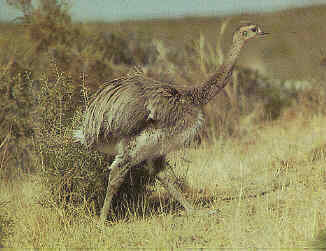
Rhea are ostrichlike birds. They are smaller than African ostriches and have three toes instead of two but who’s counting. The head and neck are completely covered with feathers. We have seen several dozen rhea just today. They are fast runners and I suspect they like to race---we had one running along side our car for about 200 meters. As it ran next to us it glanced our way every now and then as if to see who was driving or perhaps it was to make eye contact with its competitor, a classic antagonization tactic. We won, by the way (wooooohooo!).
Huemul
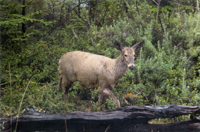
The huemul, or guemal, are part of the deer family. Haven’t seen one yet but we are on the look out. We will have to consider ourselves lucky if we do see one; they are on the World Conservation Union (IUCN) Endangered Species list and they usually travel alone (not in packs) in the Southern region of Patagonia.
Pudu
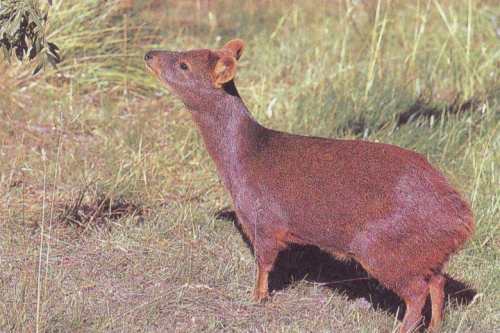
Pudu are miniature deer. In fact, they are the smallest members of the deer family. We have seen only a few pudu so far. They have stout bodies covered with long, coarse, reddish-brown fur; short legs; and broad, rounded heads with small eyes and ears. They can be as tall as 17 inches high and they weigh between 13 to 29 lb. Truly a small deer.
Chinchilla
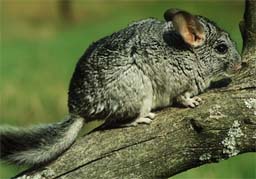
We have seen a couple chinchillas hopping on the road at night. The squirrel-like chinchillas are 9 to 11 inches long, not including their bushy tails, which can be up to 6 inches long. They have large ears and short front legs. Chinchillas use their front legs to hold the roots and grasses on which they feed; the long hind legs enable the animals to hop about with great agility. Chinchillas are also cute and I hear that they make okay pets.
Chanda
chanda@drivearoundtheworld.com
P.S. - We departed the hotel at about 9:25 a.m. and were immediately stopped at a military checkpoint. The nice officials waved us on at 9:40, and we were on our way. At 11:13, the team pulled over for a pit stop in order to tighten the exhaust studs on each vehicle. The gravel roads here will rattle and vibrate everything loose, and nuts have to be checked and tightened regularly. While Todd and the guys were playing mechanic, I took off down the road on my bike. An hour later, they picked me up, 10.9 miles down the road. That was a fun hour. Back on the road, we spotted a condor at about 12:50. At 3:00, we caught a baby armadillo. We found a place to camp for the evening in a dry riverbed beneath some hills, and did some exploring on foot. Littering the ground all about on the hill were guanaco skeletons. Dozens of them. We found caves, and the bones were in the caves, too. We figured the pumas killed the baby guanacos and ate them in the caves. There were no fresh carcasses, so my guess is that the pumas live there in the rainy season, when the river is full. They would have shelter, readily available food, and water. Glad it isn't the rainy season! (N.O.)
| Logbook for February 8th, Day 100 | ||
|
Start: Perito Moreno, Argentina Time: 9:30 a.m. S: 46*35.740 W: 70*55.547 |
Finish: Tres Lagos, Argentina Time: 9:15 p.m. S: 49*36.020 W: 71*28.226 |
Mileage: 282 |
February 09, 2004
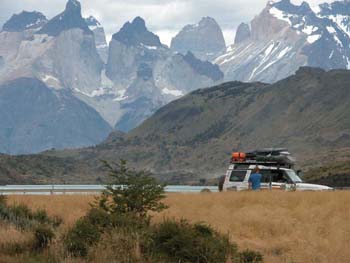
[Above: A Drive Around the World Land Rover in the famous Torres del Paine National Park of southern Chile.]
Today was a dream. We woke up in the Patagonia desert in a dry riverbed alongside a hill and surrounding plains. We were just on the other side of Tres Lagos, a super tiny town in the middle of Argentina. The air was crisp and the temperature was chilly. The sun was shining and we packed up our tents, stopped at the gas station in town and tightened all the exhaust manifold bolts of our Land Rovers. The roads here are all dirt and the constant shaking for the past week or so is rattling our nuts and bolts loose. On each of our cars, we have 6 bolts that hold the two pipes into the engine block, and every single one of our cars has at least one missing. So we have to tighten them up every morning now. In fact, sometimes twice a day, these roads are brutal.
As bumpy as the roads are, the scenery is unreal. Like I said, a dreamscape. The Argentine desert is extremely vast and we drive on it for hours and hours all day and only see a car or two every hour. If we are off the main road, we won't see any other vehicles. We are in the middle of nowhere and I adore it. The relaxation you feel when driving for hours on long roads through arid desert is like meditation. We were also drinking hierba de mate which is a plant grown in Chile and Argentina that is similar to caffeine, but doesn't have the side effects. In fact, it is one molecule away from caffeine. So drinking mate for hours on the road out of our mate drinking gourds is quite a delightful experience. You pour the tea directly into the gourd and add hot water, then stick a long metal straw-like device into the cup. At the tip of the straw is a small oval pod with tiny holes that act as a filter for the loose tea in the cup. Then you suck it up and enjoy the bitter taste that fills your mouth.
So after we tightened our bolts, we got on the road and picked up Nancy about 15 miles down the road. She left a while earlier to go biking until we caught up. We drove for hours and passed some beautiful turquoise rivers and lakes along the way. The sky was scattered with puffy white clouds, nestled against yellowish green meadows and rolling hills with dust being kicked up in the air from vehicles and harsh winds. The winds were blowing anywhere from 20-35 knots and it was a bit sketchy on the road at times. If we had sails on the roof, we would save a lot of gas money.
We were heading towards Torres del Paine, which is one of the, if not THE most famous national park in Chile. And yes, Chile, so we had to cross another border today, again, into Chile. So we left Chile a few days ago into Argentina and now we were headed towards Chile one more time. At least the border crossings here are a piece of cake.
We arrived at the border, which is another very unique small town, or building in the desert. We exited Argentina in a jiffy, and then drove to the entrance of Chile and filled out the paperwork, and we were done within an hour. These South American borders are so mellow compared to Central America, especially the Chile and Argentina borders within the Patagonia region.
While we were at the border, we stopped to get a bite to eat and we ran into another film crew for a local Chilean TV channel, and we told them about what we were doing, and it turns out, they knew a guy in town who was a sheep herder who has Parkinson's. So Todd and our Drive Around the World guest, Sebastian went off to interview him and learn more about Parkinson's in foreign countries. Todd will have to write about that experience for you on another log. He did say the guy was amazing though!
After that, we headed towards Torres del Paine. On the way, we had an array of wildlife show itself to us. We saw some nandus, guanacos and a condor. The guanacos are like a mixture of a deer and a vicuna, but much bigger. They are gorgeous and make a very squeaky cute sound. We ended up filming them for a while, and then at one point I went to chase them to make them run, and they did run a bit, but then they just stopped and let us get really close. It was awesome. They are really beautiful animals. Then there are the nandus, which are similar to ostriches and have a really goofy walk. And while we were putting some of our fuel from our reserve jerry cans into our vehicles, we saw a condor fly by. And yes, reserve fuel cans, we were running low and had to fill up with our reserves. In fact, we just arrived to our campsite outside of the park of Torres del Paine, alongside a lake with a view of the Torres del Paine mountains. The towering mountains and glaciers alongside this lake are phenomenal. They are so vertical and just shoot into the sky! Tomorrow, we are heading further into the park, and then back out of the park, so we are limited to how far in we can go due to our gasoline. We are in the boonies out here, and it is spectacular.
Right now, we just set up camp, made a fire and had dinner. We are listening to music as I write. I figured I might as well write my log right now while the day is fresh on my mind. The moon is getting smaller and the stars are unbelievable right now. Have you ever seen the Southern Cross? Phew, what a sight, especially tonight, in the middle of the desert without a light in view for many many miles. It is also really windy right now and our tents are taking a beating, but this is fantastic, to feel raging winds against your face, you feel alive!! What a day, and what a night. I am going to get back to the fire now and enjoy this beautiful place. The Patagonia is a must see for everyone, truly magical.
Ciao,
Neil
neil@drivearoundtheworld.com
P.S. - We woke up to a beautiful pink sunrise in the dry riverbed. I was up early to get an hour or so head start on my bike. The ride was incredible, bisecting giant wild fields full of guanaco. It was also quite hilly and gravelly, so after 2 hours, I was happy to see the convoy. It was a good 20 miles, not bad for a morning in Patagonia. We had an amazing drive to the outskirts of the famous Parque Nacional Torres del Pine. We made camp on the banks of Lago Almaden, just outside of the park, and we enjoyed dinner and beverages in the intense winds of the lake's shores. (N.O.)
| Logbook for February 9th, Day 101 | ||
|
Start: Tres Lagos, Argentina Time: 7:15 a.m. S: 49*36.020 W: 71*28.226 |
Finish: Laguna Armaga, Parque Nacional Torres del Paine, Chile Time: 9:30 p.m. S: 50*58.377 W: 72*43.859 |
Mileage: 256 |
February 10, 2004
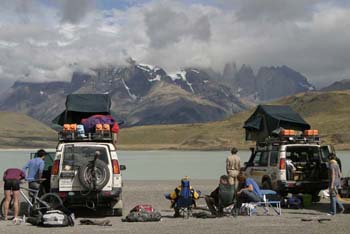
[Above: The Drive Around the World team enjoys a morning underneath the majestic peaks of Torres del Paine National Park in Chile.]
No disagreement with the name -- Torres del Paine -- as I lay here almost completely immobile in the rear seat of the Land Rover. We camped our way down the altiplano of Chile with no villa stops and Internet cafes. It was nice for a change and after the first few nights without washing you become accustomed to your own grime. The sweat attracts the clouds of dust kicked up from the road by the convoy and campfire smoke lingers in everyone’s fleece but at least you have the comfort of knowing that the smell is your own for whatever good that offers. The last night at the National Park we camped near a mineral rich lake of a turquoise blue color. On the placid shore lay a badly decomposed guanaco (endangered llama-like creature), bleached white driftwood, and cobblestones.
In the evening the calm air and glassy lake took a major change as the winds began to howl through our rooftop tents. I lit a small fire between our cars and cooked two sausages for dinner. My food supply was down to 4 pieces of orange cream-filled chocolate, 8 slices of old salami, 2 pieces of cheese covered in somebody’s spilt milk, and three sausages. I swapped one sausage with Nick for a small bread roll and prepared for my sausage sandwich. While cooking the stick burned through and sausage #1 fell into the fire. A moment later the howling winds simultaneously blew my cheese onto the sand and my bread roll into the fire. I managed to overcome the obstacles by rinsing the charcoal-covered wiener and the sand coated slices of cheese with the almond-flavored tequila that Rolf had bought from Tequila, Mexico and by picking off the burnt black layer off of the roll. The tequila seemed to work fine and even improved the flavor of the sausages.
That night we drank the leftovers of the liquor people have accumulated from various stops in the Americas. Among these were rum, almond tequila, tequila gold, some horrible chemical-tasting juice bought in Argentina, red wine, bootlegged mescal from Mexico, and gin. A rough mix. The next day we woke up rather late and after a pot of Land Rover coffee and a jam-covered slice of bread we began kicking a soccer ball around in a circle. This went on for a while and we started getting quite skilled at keeping all 6 players juggling it to each other without letting it hit the ground. At about that moment I reached down to pick it up and my back completely blew out. I was immobile and could hardly walk. Existing was excruciating and now I am still lying on my back unable to lean over or walk properly. I have had others put on my socks and shoes and when I look in the mirror I am clearly crooked, my body is leaning to the right with extreme misalignment. So as the car rumbles across the dirt road leading to the “End of the World” I am considering buying a ticket to Buenos Aires and waiting there for the crew to arrive 10 days later. It will offer me time to recuperate while giving me a chance to edit together a short video for Nick to throw at some new sponsors.
Getting injured on something like this is my worst nightmare. Everyone around me is totally functional while I can only sit around in envy and pain. Being ill I can handle but being immobile is the ultimate frustration. I hope my back gets better over time because Brazil is coming up shortly and I’ve been looking forward to dancing and surfing the days away.
P.S. - It was overcast and a bit drizzly when we woke up next to the lake, but it didn't dampen our spirits. We made coffee before departing for the park's entrance. Unfortunately, poor Adam threw out his back playing catch, and, after having played around most of the morning, we didn't enter the park until 3:00. Adam is in bad shape. We spent a few hours taking in some of the views, such as glaciers, mountains, wildlife (including a fox), and the famous Torres del Paines. We left in high spirits for our drive to Puerto Natales. There, after much searching, we arrived at Hospedaje Alicia. It was like being at Grandma's house. (N.O.)
| Logbook for February 10th, Day 102 | ||
|
Start: Laguna Armaga, Parque Nacional Torres del Paine, Chile Time: 2:00 p.m. S: 50*58.377 W: 72*43.859 |
Finish: Puerto Natales, Chile Time: 9:45 p.m. S: 51*43.597 W: 72*30.423 |
Mileage: 122 |
February 11, 2004
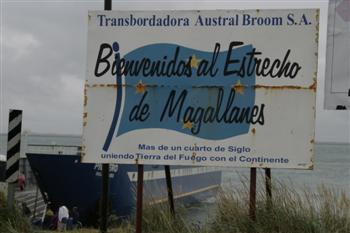
[Above: Standing by to cross the Straits of Magellan]
Puerto Natalas to Rio Grande
Last night was heaven! We slept in a warm bed for the first time in about a week. Outside it was cold and rainy, and inside we were taken care of by a woman that looked like a perfect grandmother: radiate smile, rotund (like meals were her specialty), and slightly motherly, which is perfect when you are needing to be taken care of.
When I awoke, my bed was warm, my blankets were heavy, and I heard the sound of wind and rain outside. Unfortunately, I could not linger in the moment, because we were headed to Tierra del Fuego. After showers and some breakfast, we headed to the gas station. Adam, who had thrown out his back a day earlier, was convalescing in the back seat of D2 and in need of medicine. So, while the vehicles were getting washed, Chanda, Nancy, and I set out to find some Vikadin for our ailing teammate.
Combing the city for meds, we couldn’t find any Vikadin without prescription; therefore, we purchased a couple of strong anti-inflammatories and some muscle relaxers. Hopefully, his back will get better soon.
The cold, rainy weather did not let up as we neared the Land of Fire. It somehow seemed appropriate having dismal weather as we were heading to Land’s End. This land is called the Land of Fire (Tierra del Fuego). The name Tierra del Fuego was given to this place because the land appeared on fire due to large numbers of bonfires the Spanish saw from their ships. This area can get cold, so these bonfires were necessary to warm the native people, the Ona, Aush, and Yahgan, who are all pretty much extinct now. There is plenty of firewood around, as the heavy winds are constantly breaking branches, and driftwood is constantly washing ashore.
We hit the ferry stop at about 3:00 pm and needed to wait for the 4:00 pm ferry. Things seemed to go smoothly until they attempted to unload a bus, the second-to-last vehicle on the ferry. Unfortunately, the departure angle of the vehicle was less than optimal, and it scrapped and caught on the exit ramp of the ferry. It was caught in such a way that the back end of the bus was stuck, elevating the back wheels off the ground. Uffda? A solution needed to found! Soon, a semi was cabled up to the front bumper and it began tugging in order to free the bus, meanwhile the tide was departing, causing further problems, the worst of which could be a beached ferry. While the bus problem was being worked on, cars were loading up, some even bypassing the lines hoping for a quick cut-off. A mess would certainly ensue once the bus was freed.
Unfortunately, the Semi was only able to free the part of the bumper that held the cable, and nothing else. Now the bus sat there with a hole in its bumper, still stuck. Pieces of wood were jammed under the spinning tires, and a couple of other methods were tried, but to avail. The team met briefly to discuss the possibility of using our four Warn winches, but we couldn’t figure out a way in which we could define a common pulling point.
Anyway, with the big ferry stuck, a smaller one was brought in to avoid the large traffic buildup, trying to preserve some sort of schedule. All the waiting traffic pulled in and jockeyed for the best position. It was almost like we were playing a video game. The four vehicles pulled in tight, looking like a train. We got the eye of an attendant; sometimes it is great to have standout vehicles. He gave us a chance, and we wormed our way in and onto the ferry. T o be fair, it is important to realize that we were one of the first in line. We were forced to move as a result of the semi and long cable that was used to pull the bus. If those cables snap, there is no telling what that cable will hit, and they travel at considerable force.
Not long after the free-for-all, we were crossing the Straights of Magellan, named after the famed Portuguese explorer who first sailed through this area in 1520. I remember reading about Magellan and Cape Horn when I was in elementary school. It was pretty exciting to actually be here and see it! Who would have guessed, 25 years ago, when my third grade teacher Mrs. Halter was telling us all about these places, that I would actually be here? It really goes to show you can do anything you want!
The ferry ride took no more than twenty minutes, and we were on our way again. We enjoyed good roads for about 20 km, then they turned to gravel again. It was raining, which keept the dust down, which was nice. After about one hour, D2 came over the radio saying, “We just lost a tire”. It was raining out, and Nancy and I looked at each other. “Another one?” D3 and D1 wheeled around, and we quickly took care of the problem. It was one of my proudest team moments. The team acted as a fine-tuned watch. Nancy breaking out the jack and jacking up the vehicle, Nick and I removing the lug nuts from the spare and the downed tire, Chanda holding the nuts while we were exchanging wheels, and Neil looking pretty for the camera, giving the impression he was at the heart of the job. Seven minutes was the in-and-out time, thank goodness, because it was wet out there.
We continued on until the border, where we met a couple from Belgium who had been traveling for the last four months. We gave them a lift to Rio Grande, asking them about various aspects of Belgium. Rolf even provided a Belgium trivia contest; I don’t think they were impressed. In any case, it was fun to ask them about their country and travel experiences.
We finished the evening off 200 km short of Ushuaia, at about midnight. We are all eager to head to Ushuaia in the morning, and then to the end of the World!
P.S. - We left Puerto Natales at 11:55 a.m., after getting a fillup and a carwash, and stopping at the drugstore for some painkillers for Adam. His back is still painful. We picked up a couple from Belgium on our way to the Argentine border, and we brought them to the town of Rio Grande. We arrived at midnight, ate dinner, nad found a place to stay. It was a hostel with two bunk rooms, and we were happy to have a warm and comfortable place to sleep. (N.O.)
| Logbook for February 11th, Day 103 | ||
|
Start: Puerto Natales, Chile Time: 10:00 a.m. S: 51*43.597 W: 72*30.423 |
Finish: Rio Grande, Argentina Time: 1:00 a.m. S: 53*47.393 W: 67*42.505 |
Mileage: 344 |
February 12, 2004
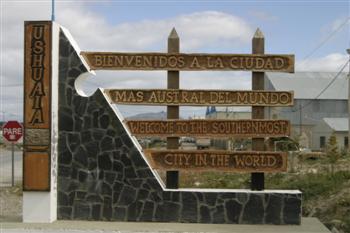
[Above: The sign speaks for itself]
We spent the night before last at Grandma's house. Well, Hospedaje Alicia's in Puerto Natales wasn't REALLY Grandma's, but it had a warm and inviting feel, and the kitchen smelled of fresh baking...and stew...
Alicia's was a bit of a contrast to where we awoke this morning in Rio Grande. We were in another hostel, but it wasn't so intimate, with bunkbeds and loud neighbors. But the poor elderly woman we'd rousted from her sleep at midnight to check us in was cheerful this morning, and were were warm, clean, and comfortable in our bunks.
We were slow to get moving this morning, choosing first to find a breakfast of chocolate, toast, and coffee, as well as a bank for changing Chilean money to Argentinian. Todd was kind enough to lend me a $50-peso bill that he had changed earlier, so I'm all set. I'll get him back when we hit a cambio later.
So, well after our scheduled 9:00 a.m. departure, we hit the road for a very windy drive east to Tierra del Fuego. Todd could barely keep the Discovery on the road, it was blowing so hard. We were driving across a flat and barren landscape, and, where rain water had flooded parts of a few fields, the wind created whitecaps on the puddles. After an hour-and-a-half or so of flat, barren fields, we hit mountains. Mountains, streams, and trees.
We wound up and around through high pass, and, as we drove, we filmed our convoy against backdrops of huge, ice-capped peaks. It was overcast, but it was beautiful. Such mountains!
Suddenly, at 2:22 p.m. on 2/12/04, the Drive Around the World LONGITUDE Expedition team arrived in the world's southernmost city: Ushuaia. For some reason, it reminded me of Alaska. Perhaps because of its ruggedness, its remoteness, or its "final frontier" feel.
Ushuaia is a port town, and it has a comfortable, outdoorsy quality. If it weren't so cold, I think I could live here for a while. It's summertime now, though, and I feel the winters must freeze the marrow of your bones. Brrrr!!! I can't imagine. We feel chilled each time the wind blows, and it is supposedly warm here now.
Well, our arrival caused quite a stir in town, of course, and we were happy to talk with a few curious people in town who had come to gawk at the four Certified, Pre-Owned Land Rover Discovery vehicles parked on the main street.
We all went in separate directions, some of us visiting internet cafes, others outdoor shops, souvenir shops (tourist traps), and the visitor center.
I had my passport and all of my postcards stamped with an "end of the world" stamp and then met Todd, Nick and Chanda for lunch.
In the meantime, Colin and Neal had located a nice hostel for us just outside of town. We had a barracks-style, squad bay-esque bunkroom in the basement of the hostel, a house in a nice neighborhood. Everybody jumped to attention and sounded off Gomer Pyle-style when I walked into the room, and we all had a good laugh.
I found a single bed in the corner and located two huge wooden boards to put up as walls. I created my own little room, complete with a password.
Tomorrow, we will be driving to the end of the road and moving into a new house nearer the town's center.
Until next time,
Nancy
P.S. - We didn't leave Rio Grande at 9:00 a.m., as we'd intended, because everybody went to breakfast and the bank. Once we were on the road again, we had a very windy drive East to Ushuaia. Our arrival at the world's southernmost city marks the ceremonial end of our southerly trek. (N.O.)
| Logbook for February 12th, Day 104 | ||
|
Start: Rio Grande, Argentina Time: 11:00 a.m. S: 53*47.393 W: 67*42.505 |
Finish: Ushuaia, Argentina Time: 6:45 p.m. S: 54*48.861 W: 68*20.494 |
Mileage: 131 |
February 13, 2004
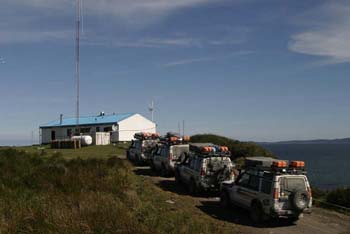
[Above: Drive Around the World vehicles stopped at an Argentine radio station at the southernmost tip of South America, where the road ends.]
Tierra Del fuego, the final frontier. These are the voyages of the non-profit organization Drive Around the World… Their mission; To boldly go where no expedition based on raising money for Parkinson’s Disease has gone before. Blah blah blah…you get my drift.
So we’ve done it. We’ve reached the end of the road. We are now at the southern point of South America, two hours outside of Ushaia, where the road abruptly ends. And where does it end you ask? Because, if I was you, I would ask that too, and figuring on you (the reader of this here publication) being an astute individual I am going to assume that you (the astute individual) will in fact be asking that question of which I mentioned previously. The answer is not glorious or triumphant, but it is pleasing, at least to me, and also in some ways not really surprising.
At the end of the road lies a smallish white structure with a blue roof situated along a cliff overlooking the Beagle Channel (named for Charles DarwinÔs exploratory naval vessel which passed this way in the 1830's). The blue and white flag, flying on a pole behind the structure matches the buildingÔs color scheme, because it is the flag of Argentina and the structure is owned by the government of Argentina. A small wooden sign, on two wooden posts, sits in front of the structure, and reads “Perfectura Naval DTO Moat”
The structure is in fact a naval watch station, where Argentinean naval personnel can monitor the sea-going traffic traveling through the channel. A few Argentine navy men man the station in the remote spot and rotate monthly between their home and their workplace. Their boss, an amicable individual invited us in, gave us a tour and let us brew some coffee to boost our spirits. In response we gifted a can of Land Rover coffee, A Drive Around the World T-shirt and some Red Bull for him to enjoy. He is a HAM radio enthusiast and was excited when Nick divulged that he too was a fan of the HAM. Call numbers were exchanged along with pleasantries.
Across the way from the station lies Picton Island, the ownership of which, in the seventies, nearly sparked a war between Argentina and Chile, however the Pope came down here and set the matter straight by telling Chile they could have the island, so that’s that. I don’t think the Argentineans really liked the decision, but they can’t really argue with the ambassador of God.
Today in fact, marks two momentous occasions, not only Drive Around the World reaching the end of the road, but also a beloved team member leaving. Rolf Justin, travel writer by trade and party animal by night, will be taking his leave of us tomorrow, moving towards Rio, where he has yet another writing assignment. Such is the life of a professional traveler. We will miss him and his sense of humor, which I heartily enjoyed. At some point in the future I plan on hunting him down and sleeping on his couch until he gets sick of me and kicks me out; such is the life of an amateur freeloader.
So there you have it, yet another deposition from yours truly. Rest assured that there will be many more, however none will be the same as this one, because today I am in a rare literary mood.
Rock on,
Sir Colin
colin@drivearoundtheworld.com
P.S. - We drove to the end of the road at the end of the world. Have you ever read Shel Silverstein's "Where the Sidewalk Ends?" It pretty much looks like the cover art for that, only different. There's a naval radio station there, where we made two new friends, drank coffee, ate bread and jam, took sponsorship photos, enjoyed some Red Bull, used our Iridium and Telenor sat-phone to call sponsors, and then turned back around to return to Ushuaia. We were home by 6:30 p.m., and we moved right in to our new rented home. Later, we all met at an all-you-can eat (tenedor libre, in Espanol) steak house for Rolf's going-away dinner. We had grand plans for a party afterward, but Nick, after checking his e-mail, discovered that our shipping date has been moved up by three days. We have to start driving in the morning. No time for parties or for exploring the unexplored city of Ushuaia. We're in for a marathon drive. (N.O.)
| Logbook for February 13th, Day 105 | ||
|
Start: Ushuaia, Argentina Time: 11:30 a.m. S: 54*48.861 W: 68*20.494 |
Finish: End of the Road, Beagle Canal, Moat, Argentina Time: 7:30 p.m. S: 54*48.399 W: 68*18.337 |
Mileage: 159 |
February 15, 2004
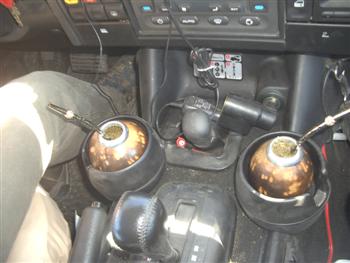
[Above: Most folks don't realize the lengths designers at Land Rover will go to ensure worldwide acceptance. They formed the cup holders to hold anything from 7-11 Big Gulps, to Argentinean matte gourds.]
We're still pushing for Buenos Aires and our shipping date. Still working and driving. And driving. We had to stop at an Internet cafe this evening, where we remained until after midnight, updating our website press room. Justin did a good job writing a dozen or more news releases. After the cafe, we continued driving until we found a place to camp, just a few hours down the road. Tomorrow, more driving. (N.O.)
| Logbook for February 15th, Day 107 | ||
|
Start: South of Rio Gallegos, Argentina Time: 7:00 a.m. S: 51*17.873 W: 69*32.031 |
Finish: East of Nuevo Leon, Argentina Time: 1:45 a.m. S: 40*42.829 W: 69*32.031 |
Mileage: 877 (no, that is not a typo) |
February 16, 2004

[Above: On the road to the port at Zarate, the team encountered an emmense rainbow.]
We have been on the road hard for the last two days now, and this is our last stretch towards Buenos Aires. We woke up this morning and it was raining, and, unfortunately, last night there were no signs of rain, so none of us put up our rainguards on our tents. So when we awoke, we all awoke to wet tent bottoms, pads, and sleeping bags. That's not always the greatest way to wake up, but oh well. We also woke up two hours later than expected, so we were already behind schedulel. The great thing is, none of us were in a bad mood. We were all ready to charge forward and get to Buenos Aires. We all welcome the challenge of driving nonstop for days on end to meet our shipping date. And to tell you the truth, it is really fun.
While on the road, we tell jokes, drink our mate tea and coffee, and also learn all kinds of new interesting information about the areas we are travelling through, as well as random trivia facts. It is really funny to see what people come up with to talk about after travelling with each other for 3 months, especially locked in cars together most of the time. With our radios, which span more than 10-20 miles at times, we can fall behind or get way ahead of each other and still communicate. It is awesome, and we never lose each other, which is always a convoy's worst nightmare.
What I really love the most about our long drives is the solitude. We are travelling together all the time and always doing group activities and talking and having great times; however, time alone is something I cherish as well. And when we are driving all day long for days on end, one gets plenty of solitude. Colin and I were driving together for this three-day stretch, and he would sleep in the back while I drove. And that is a perfect recipe, for two reasons. One, obviously, is so after 10 hours of me driving, he is well-rested and ready to take over. And the other reason is that while he is sleeping, I can get in my cruisin' music landscape mode. I adore soaking in the landscape and just looking at everything and being completely filled with amazement of where we are and all the beautiful surroundings. And coupled with groovy tunes, I am in paradise. It is very relaxing. In fact, many times when the team is playing games over the radio or doing other things on these long drives, I prefer to turn down the CB and eveyone else's voice, and get into a driving groove. And sometimes, I am the opposite, and get giddy and talk and talk and talk.
So anyway, we drove all day today and watched the landscape change from desert brush to farmland and green fields, with towns growing bigger the further north we came. Half of the drive, it was raining, which slowed us down, yet the sky really filled up with beautiful clouds and colors. At one point, the sun was out to our left, and on the right side of the road was a huge rainbow that went from one end on the ground all the way up and down to the other side. It was beautiful. And, not only was there one amazing rainbow, but there was another rainbow on top of it, a bit more faint, but there. It was a wonderful moment.
As we kept heading north, the people were starting to have more fashion and style as well. We were entering a much more industrial and cosmopolitan area. We were under a time crunch as well today to drive about 700 miles, as well as stop for some time in a town that had internet so Justin and Nancy could get some information out online. Justin has an article that is being printed in the largest English newspaper in Argentina! And Nancy had some press releases to upload. And we accomplished both in a town a few hours outside of Santiago. The stop ended up taking us a couple of hours and by the time we were back on the road to head to Buenos Aires, it was almost midnight.
Also, while we were in the internet cafe, a local radio station reporter came up to us and wanted to interview us. So he interviewed me in Spanish and we were supposed to be on the radio that night. We weren't able to listen to the radio when we were supposed to air, we were all preoccupied with other activities. But I am sure many people in Argentina were listening and hopefully are on our website right now donating money to Parkinson's.
Around 11PM after we finished eating some yummy ice cream, we left the internet cafe and were on the road and heading to Buenos Aires. As we got closer, I was sleeping, and I guess I was talking outloud as I was dreaming of finding surf. Colin was laughing and telling everyone on the radio that I was telling him to look for Island Azul, and that I saw some waves that were really crowded, and to keep searching. I guess I can't get surfing off my mind, even when I am sleeping.
So we finally did reach Buenos Aires at around 3AM, and headed to a town called Zarate, which is the port town from which we are shipping our vehicles. We found a hotel and crashed out. We were all exhausted from three days of nonstop driving. We were stoked to finally make it, and we were ecstatic to go to sleep. In fact, sleeping in a room with Colin and Justin, whom were both snoring in full force didn't even keep me awake at all. We made it!!
Now we are heading in a few different directions over the next month while our cars are at sea to Australia. I will be heading to Brasil and chasing Carnaval, Samba, and Surf, so until next time, Ciao!!!Neil
P.S. - Well, we made it! We drove for three days straight, and we covered 2000 miles, and we made it. We met with Merco Mar, who is handling the shipping of our vehicles for Wallenius Wilhelmsen. Everything is set. We will bring the vehicles to the port to bid them bon voyage tomorrow morning. We'll be without vehicles for six weeks! (N.O.)
| Logbook for February 16th, Day 108 | ||
|
Start: East of Nuevo Leon, Argentina Time: 9:00 a.m. S: 40*42.829 W: 69*32.031 |
Finish: Lujan, Argentina Time: 3:30 a.m. S: 34*33.627 W: 59*07.278 |
Mileage: 628 |
February 17, 2004

[The team drives their Certified Discoverys in through the stern of the Hume Highway. This is ro-ro shipping. Roll 'em on, roll 'em off.]
We spent a few days outside of Buenas Aires in the suburb of Zarate, close to the shipping port. It was considerably calmer here, and it offered me the time to begin soaking up what Argentina has to offer. It quickly became evident that the women are strikingly more beautiful here than almost everywhere I’ve been. Even the less attractive women have figures and dress in a style that draws your attention. Eyes dart everywhere, as the national pastime appears to be eye flirting. Seldom will you find a person overweight despite the lack of apparent exercise.
We spent most of the time preparing the Land Rovers for their 40-day ship ride to Australia. Unfortunately, we discovered quickly that our shipping sponsor only offers roll-on-roll-off, or “ro-ro”, service. This means that they have no containers for the cars, which results in no protection against theft, and if you saw the inside of these rigs you’d understand why that would be a concern. Thousands of dollars worth of camera equipment, computer equipment, GPS, camping supplies, and clothes cover every square inch of available space. Nick broke the news to us the next day and said that we have to take everything with us out of the cars.
The three of us were headed for Brazil in a week, and the number of cases we had couldn’t be carried by seven people, let alone by three travelling alone. So the obvious answer was to do our best in securing what we do have in the back of the cars. Neil and I headed for the local hardware store and bought 60 feet of heavy chain and 5 locks. Back at the hotel, everyone ripped apart all four cars, cleaning them out entirely except for what we were to store in the back. Our Pelican camera cases made it easy for us to thread the chain through the handles and lock to the D-rings on the floor of the bed. The rest of our stuff, clothes, toys and guitars, were then covered in heavy-duty cardboard in which Colin cut several holes and threaded the last 10 feet of chain through and locked it down. The final stage was 10 feet of black plastic wrapped over the entire package to deter the “roll-off” driver in Panama or Australia from even considering dipping their hands in there. They have little time between rolling the cars off of the cargo ship and parking them in the lot for rummaging through your loose odds and ends, so hopefully this triple-wrap blob isn’t mistaken for a Christmas present.
P.S. - We filmed the loading of our vehicles onto the Wallenius Wilhelmsen ship today. It was a special moment. We drove the vehicles aboard the giant floating parking lot amidst the hundreds of new cars headed for new-car lots and the beginning their life's voyage. Our vehicles are headed for the Panamal Canal and then Australia. We'll meet them there about the first of April. Bon Voyage, D1, D2, D3, and D4! We'll miss you! (N.O.)
| Logbook for February 17th, Day 109 | ||
|
Start: Lujan, Argentina Time: 9:30 a.m. S: 34*33.627 W: 59*07.278 |
Finish: Zarate, Argentina Time: 9:00 p.m. S: 34*05.879 W: 59*01.341 |
Mileage: 169 |
February 18, 2004

[Above: The Drive Around the World team drives their four Certified, Pre-Owned Discovery vehicles onto a Willenius Wilhelmsen ship, the Hume Highway, for passage to Australia.]
Finally, after years of dreaming, planning, and execution, we have reached one of our first major milestones on this expedition: sending the vehicles to Australia. Although we love traveling in the vehicles, the whole team has looked forward to our forecast 6-week break from the daily rigors of the expedition, especially the grueling last month. Neil has talked about going to Brazil from the day I met him, and with a big smile on his face he realizes the day has almost arrived for him to go. There’s just this one last task to do.
Although it might seem easy to put a vehicle on the boat, there are really a lot of things to consider. There are three major ways to ship a vehicle: LoLo (load on/load off), when the vehicles are loaded by crane, RoRo (roll on/roll off), when the vehicles are driven on and off the ship, and finally container shipping, where the vehicles are loaded into a container (like the trailer bed of a semi). The most common type of vehicles that are shipped are vehicles straight from the factory. In this case, everything in or on the vehicle is bolted or screwed down, so LoLo or RoRo is the most practical. In our case, however, our cars are loaded with gear, so RoRo or LoLo is not the best option for us. You have to remember that if they are driving the cars on and off the ships, the car is going to be open for a certain amount to time, and this is a significant security risk.
On the last expedition, we learned the hard way. After driving around the world and having no problems, our vehicles were robbed in New Jersey. Although we had been subtly warned, we didn’t want to have to carry everything with us while we crossed the Atlantic by plane, so we left quite a bit of stuff in the vehicles. Yes, we lost lots of stuff, but the most amazing story was the story of the videotapes. All the videos we had shot over the course of the expedition were stolen! Yes, we were dumb to leave these tapes in the vehicles. We could blame one another for leaving them there, but nothing changed the fact that they were gone. Nick did what he could to get them back, but we resigned ourselves to lamenting their absence. Eleven months later, Nick received a phone call from a fellow in the New Jersey port. Apparently, he had seen the reward signs and was holding the right information. He quickly shipped us the tapes, and we still remain delighted and amazed. Anyway, lesson learned.
Container shipping is what we prefer, as the vehicles are locked and sealed into a freight container, and the only people holding the keys are the property owners. When the ship arrives, you go down, do the paper work, open the container for the customs people, and then you are on your way (sounds more simple than it actually is; sometimes this can take days). If we have a container, we can pack all of our valuable belongings into the vehicles, knowing that they will be safe; furthermore, we would not have to lug around extra things. When you know your stuff is safe, it is nice to only tote a small bag around, as now you are relying on subways, taxis and buses.
Our freight forwarder, Mercomar, did everything possible to obtain a container for us, but this was not a container ship. Cargo ships are laid out to hold the maximum amount of cargo. Our ship, the Hume Highway, would be holding more then 3,000 cars. There was not a convenient place to put a container that would not interrupt the flow of loading and unloading of the other cargo. It is amazing how fast they can load this amount of cargo; this ship would be loaded in about 6 hours.
We needed to be to the port by 6:00pm. The team spent the morning and afternoon buying chains, cables, and locks to secure our gear, packing and repacking gear so it would safely and securely under the locks and chains we had purchased. The best thing to do would have been to remove everything from the vehicles, as I mentioned earlier, but this was not the practical thing. We have big bins of camping gear, parts, office supplies, and other assorted bulky items. It would have been frightfully expensive to ship separately (most likely it would not have been accepted on an airplane), and a huge pain to deal with, so we decided to take our chance. We removed everything that couldn’t be replaced but left most of the gear. Also, to increase security, Nick made an agreement with the shipping company. This agreement was for the Captain to keep a special eye on the vehicles, and they agreed that he would be the sole person in possession of the keys to the vehicles. This was also important because this ship was due to arrive in Manzanilla, Panama, March 9, the day our other ship was to leave for Brisbane. This is cutting it close, but it was the best thing available. Arrangements were made in order to secure a quick release of the vehicles once the ship arrived in Panama.
Six p.m. rolled around, and we set off for the port. The whole team went along, as we had made arrangements to film the vehicles boarding the Hume Highway. It was loading time for the ship, so we saw the thousands of cars, which, yesterday, were sitting in the parking lot, buzzing onto the ship. We drove the Land Rovers onto the second floor of what must have been a six-story ship. I was totally impressed with this ship! The floors were almost clean enough to eat off of! The people were great, and the cars were secured off to the side. I must admit they looked pretty cool, loaded and waiting for their next adventure.
We bid the vehicles good-bye, and all walked off the ship like we had just completed a mission to the moon. It was kind of a weird feeling, as we now had to flag taxis back to town.
We spent the remainder of the night eating Argentinean meat at a Parilla. This place is packed full of meat, steaks, sausages innards, you name it. All will be served up here, and cheap! We just can’t figure out why people aren’t huge here. We have much to do over the course of the next 6 weeks, so the team looked ahead and began developing strategies for how we could go into the second half with renewed energy and efficiency.
P.S. - We miss our vehicles. It's hard to believe we'll be without them for 6 weeks. To mark the occassion, we all went to a "tenedor libre", or all-you-can-eat steakhouse for dinner. We ate all kinds of weird meat, including blood sausage, intestines, some other icky organ, and some other nasty stuff. Tomorrow, we head to Buenos Aires. (N.O.)
| Logbook for February 18th, Day 110 | ||
|
Start: Buenos Aires, Argentina S: 34*33.000 W: 58*30.000 |
Finish: Buenos Aires, Argentina S: 34*33.000 W: 58*30.000 |
Mileage: N/A |
February 19, 2004
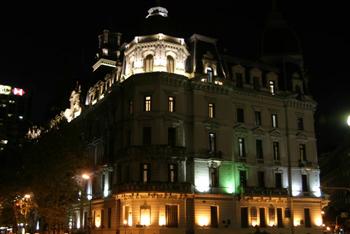
[Above: Buenos Aires, Argentina, at night ]
This morning, we awoke in time to have ourselves and our luggage ready to jump into a hired van that was standing ready to take us from our Palace Hotel in Azul to our hotel in Buenos Aires.
After quite a bit of bickering with the driver, who was incapable of achieving efficiency in packing, we finally realized that our weight problem (he had said eight people, plus all of our baggage, were too heavy for his van, and that we would need another) would go away if we offered him an additional 20 pesos.
We all packed in just fine and had a comfortable ride to Buenos Aires. On the way, we brainstormed ways of meeting our Feb. fundraising goal of $25,000. The bottom line is, we need to compel more people to go to our website and donate. The question is, how? It's a question we will be trying to answer during the final 5 months of our expedition.
When we arrived in Buenos Aires, I busied myself in the quest to find affordable airfare to Australia. As we were making our marathon drive from Ushuaia to Azul, I decided I will fly to Australia with my Santa Cruz mountain bike to cycle the east coast, from Cairns to Brisbane, while our vehicles are in transit. Other team members are heading for Brazil (Adam, Colin, Neil, Justin) or staying in B.A. (Todd, Nick and Chanda). More on all that in a future update.
As it turns out, flights to Oz are super-expensive, and I'm feeling a little discouraged about my big plan. I will still carry it out, however, as I have already fallen in love with the notion of biking 1100 miles down Australia's beautiful coastline.
G'day, ya'll,
Nancy
P.S. - We met our van at 10:00 a.m. and somehow managed to get everybody and everything inside of it. During the hour-long drive, we had a brainstorming meeting to try to find ways of reaching our fundraising goals. There's a lot of work for us to do, yet. We arrived at our hotel in downtown Buenos Aires in time for Justin and the film guys, Colin, Neil, and Adam, to go to the Brazilian embassy to apply for visas so they can go to Carnival. We got settled into our hotel and did a little exploring in the city. (N.O.)
| Logbook for February 19th, Day 111 | ||
|
Start: Zarate, Argentina S: 34*05.879 W: 59*01.341 |
Finish: Buenos Aires, Argentina S: 34*33.000 W: 58*30.000 |
Mileage: N/A |
February 20, 2004

[Above: The team enjoyed an evening at Senor Tango's, where they saw professionals tearing up the dance floor.]
Last Days of Argentina
Im here in Buenos Aires having a blast. Adam and I are going to work on a quick video for Nick, our leader, to show to sponsors. The cars are on the boat and now Im free to do whatever I want,so, Im going to brazil. I figure a month there should definately calm things down a bit. Since I am an american, it is costing me 110 dollars to get into brazil, but i think it will be worth it. Also, I ran out of pages in my passport, so I had to get some new ones at the US embassy before I could get my Brazillian visa, but now that is all taken care of and I am basically free. Tonight the team goes to a tango performance and then all I have to do is finish that promo video, and then I'm free!
-Colin
| Logbook for February 20th, Day 112 | ||
|
Start: Buenos Aires, Argentina S: 34*33.000 W: 58*30.000 |
Finish: Buenos Aires, Argentina S: 34*33.000 W: 58*30.000 |
Mileage: N/A |
February 21, 2004
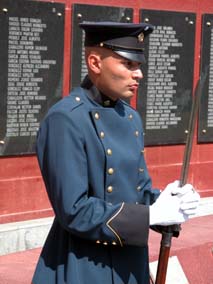
[A guard minds his post at the wall of a memorial in Buenos Aires. ]
I haven’t been in a car for four days. I mean four whole days. No cars, no traffic, no borders, no maps scattered across my dashboard and lap. My GPS is stored in my backpack, now silent. My radio has been safely packed up and is on the slow boat to China—I mean Australia. I have even slept in the same bed four nights in a row, that is, when I have actually gone to bed. For the next 6 weeks, I have nothing but work and time.
Where do I begin?
Buenos Aires is a city that is filled with incredible beauty, not only its architecture and parks, but also its people. I have had my jaw dropped in many places on this earth, but I would be lying if I didn’t say I've found the winner. The women in Buenos Aires not only turn heads, but they also make you stop in your tracks—literally. When you walk down the street, you have to be careful not to run into men standing still on the sidewalk, dazed by another passerby. Now, the qualifying statemen: Argentines also have the attitude to back up the beauty. You will have better luck at winning the lottery than you will have starting a conversation with one of these goddesses. My advice is to save your breath and keep buying your weekly lottery tickets. While you’re at it, buy one for me, too.
I am very happy to be here, because I always find cities more interesting than beach resorts. And large cities like Buenos Aires are particularly interesting to me, because I get the opportunity to observe and participate in its unique lifecycle. For a brief instance in time, I get to try to find out as much as I can about the qualities that make it tick. Of note here, it has nightclubs that close at 5:00 AM, steaks that will make the most faithful vegetarian crave a little bit of cannibalistic gluttony, and a requisite community of street performers that always seem to find a new angle for extracting a little bit of change from my pocket. For me, part of truly experiencing a city is to not only breathe it in with the suit-and-tie crowd during business hours, but also to feel the city’s pulse after these folks have long retired for the night.
Buenos Aires is also the home of the Tango. Given all of this information, how am I to make the most of my short time here? Well, tonight the team is going out for a celebratory dinner, capping off the last 113 days. Our destination is a place called Senor Tango’s, located in probably the most undesirable neighborhood in Buenos Aires, whose name I don’t even know. The show has hired doormen who keep the crowd that arrives early from leaving the immediate 50-square-foot area in front of the theatre. Literally, the neighborhood is that bad. But Senor Tango’s is rumored to be the birthplace of the Tango, and it has hosted countless people since its opening. After the show, I understood why.
The Tango is an incredibly sad, yet romantic dance. The music evokes incredible passion and emotion from anyone who hears it, and to observe this combination of movement and sound can only be described as a roller coaster ride that combines stiletto heels and heartbreak. In an instant it is sensual and sexy, yet every move is consumed by sorrow and devastation. I also find it educational, and for me, it also evokes a new understanding. It is an understanding of the pride felt by the Argentine people for their history. It is an understanding of the subtle sadness that each of them seems to have and can be observed if you watch them closely.
Earlier in the day, I explored a part of the city that all Argentines eventually visit, and some stay forever. It is the fabled cemetery for anybody who is anybody in Argentina, and it is the burial place of Eva Peron. I couldn’t find her grave, but I didn’t really try that hard. And it doesn’t really matter. The fact that she is buried here had nothing to do with my visit. I find that cemeteries are important to visit regardless of who is buried there, and even the smallest of cemeteries always make for points of reflection along my way. They are always filled with ancient monuments that capture the morbid and dark beauty of a city or culture, and they are filled with a lot of people who probably spent too much time at work, and not enough time enjoying life. It is unimportant to me whether they were rich or poor, or where they are buried, because they’re all doing the same thing now. I guess visiting these landmarks reiterates the shortness and uncertainty of life. And I think everyone needs that reminder from time to time.
Work and time.
These are things we all have, whether we’re in Washington, D.C., Wichita, Kansas or Buenos Aires, Argentina. In my former life, I learned that my office is wherever I happen to be talking on the phone or plugged into my laptop. Some things never change. The only difference now, after three-and-a-half months of a traveling, world education, is that I better understand the importance of making the most of my time first.
Until next time, I wish you all well from the far side of the world.
P.S. - Today was sort of a recovery day after last night's team party. (N.O.)
| Logbook for February 21st, Day 113 | ||
|
Start: Buenos Aires, Argentina S: 34*33.000 W: 58*30.000 |
Finish: Buenos Aires, Argentina S: 34*33.000 W: 58*30.000 |
Mileage: N/A |
February 22, 2004
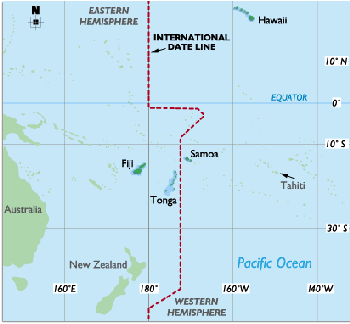
[The International Date Line is an imaginary line on the earth's surface that approximately coincides with the 180th meridian (LONGITUDE), and separates the calendar date. Traveling east across the line takes the traveler back one day; traveling west takes the traveler forward one day. Without the date line, calendar confusion would result for the traveler. With the date line, Nancy lost an entire day when travelling to Australia from Argentina!]
Today is Todd’s birthday. I woke up around mid-morning, and he and I headed out into the city of Buenos Aires for breakfast. His main mission was food; mine was finding an Internet caf and a trailer for my bike tour.
We walked for 15 or 20 minutes before deciding on a place on Florida Street called “The American Caf.” I mentioned that I was thinking of ordering a calzone, and Todd decided that sounded pretty good. They were about 14 pesos, though, and I decided to wait and get one at Speedy Pizza for 3 pesos. As it turns out, I ended up eating a slice of Todd’s crazy sausage-egg-cheese concoction (Boiled egg in a calzone? Honestly!). His “chico” was bigger than his head! It was big enough to feed three people, and the crust was heavenly!
Later, at the hotel, we hooked up with Nick and Chanda to depart by taxi to the house they had rented for the month. Todd and they are planning on working, while I’m planning to bike down the East Coast of Australia.
Once we had dropped our bags, we headed out to the streets to locate a bar for Todd’s birthday beer. Everything was closed, even at 4:00 p.m., so we went to the mall (Pacifico Mall) food court. Nick’s quesadilla was better than anything we’d eaten in Mexico—ask Chanda.
Later, something wonderful happened: Todd handed Chanda and me his ID and credit card and asked us to buy him some clothes that would be appealing to the ladies. We were personal shoppers! We labored for a couple of hours searching for the perfect items. In the end, we had two Mistral shirts, dark blue jeans, black shoes, and a button-down, black, short-sleeved shirt. Perfect! And all for under $100!
We found Nick and Todd in an Irish pub, and Todd put on the jeans, shoes, and black shirt. They fit like a dream, and he looked HOT! He was transformed. I feel so happy for him and his great new look.
After a beer, I had to rush back to the apartment to catch a cab to the airport. My flight was at midnight on Aerolineas Argentinas.
I had a pleasant ride to the airport, arriving with plenty of time to get my bike box wrapped in protective plastic, check my bags, have a gander at the duty-free shops, and board my flight, which had an intermediate stop in Aukland, New Zealand.
On the plane, I met a backpacker we had chatted with at Machu-Picchu! She was sitting just one aisle over. What a small world!
The flight was uneventful, with four wonderful movies that I slept right through. Just east of New Zealand, at about 12 noon Buenos Aires time and four a.m. New Zealand time, we crossed the International Date Line. Just like that, in the blink of an eye, we lost Monday entirely. I lost an entire day! I reset my watch for the 24th, and we just sort of skipped out on the 23rd.
Thirteen hours after take-off, we touched down in Aukland for an hour layover. After that, it was just a 3.5-hour hop over to Sydney. I passed through customs quickly and started calling hostels. It was 9:30 a.m.
I ended up at Kangaroo Backpackers in Surry Hills. I set out to find “Cheeky Monkey Multisport”, finally arriving by bus and purchasing cycle shorts and a jersey from nice shop-owner Adam. I’m out of luck for finding a bike trailer, though, so I resorted to ordering one online. I also booked a flight to Cairns and reserved a hostel room there.
I had some wonderful Indian curry and nan (bread) for dinner and went to bed early. Actually, I fell asleep in my clothes while reading my Lonely Planet Australia guidebook.
Tomorrow: Cairns!
P.S. - The team is still in Buenos Aires. The most important thing about 22 February is that TODAY IS TODD'S BIRTHDAY! Happy birthday, Todd! This morning, he and I woke up and walked around the city until we found a place to eat, "American Diner." Todd ordered a Calzone as big as his face, and I helped him eat it. Then he mentioned that it's his birthday. OH! Shucks! I knew that, but I totally forgot. Happy birthday, Buddy. Calzone's on me! In the afternoon, Nick, Chanda, and Todd moved into their new apartment. It will be home for a month. Later, we went out for Todd's birthday beer, and he gave Chanda and me his credit card with instructions to buy him something nice to wear. We hooked him up with shoes, jeans, and three shirts...all for barely more than $100! He looks hot in his jeans and black shirt. I ended the party early by rushing off to catch my flight to Sydney. What will we all do without our teammies? (N.O.)
| Logbook for February 22, Day 114 | ||
|
Start: Buenos Aires, Argentina S: 34*33.000 W: 58*30.000 |
Finish: Buenos Aires, Argentina S: 34*33.000 W: 58*30.000 |
Mileage: N/A |
February 22, 2004
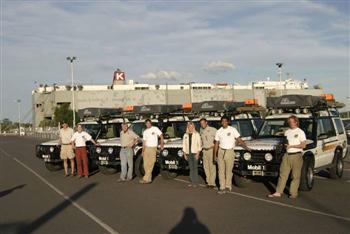
[Above: The Drive Around the World team prepares to bid farewell to their vehicles, which will be on a wallenius Wilhelmsen ship for six weeks.]
While LONGITUDE's 2003 Certified, Pre-Owned, Discovery expedition vehicles are on a Wallenius Wilhelmsen ship for a six-week voyage to Brisbane, Australia, Drive Around the World teammembers are planning separate adventures of their own.
Nick and Chanda, winners of the team's "Hardest Workers" and "Most Appreciated" awards, have rented an apartment in a nice Buenos Aires neighborhood for a month. There, they will work on team sponsorships, fundraising, www.drivearoundtheworld.com, and expedition logistics.
Todd, winner of the team's "Most Underappreciated" award, and close runner-up for "Hardest Worker," will join Nick and Chanda to work on the LONGITUDE Education program. He will also be working on fundraising for Parkinson's Disease. Later, he might visit friends in Chile and will take several side excursions to destinations unknown.
Adam, Colin, and Neil, the "film guys," will hole themselves up in a hotel for several days to edit together some of the footage they have been shooting. Later, they will enjoy Carnival in Rio de Janeiro, Brazil. After Carnival, they will seek out some surfing in a few of South America's hot spots.
While seeking out adventure, Justin will also be working hard on some of the team's media and logistical requirements. First, though, he will visit Brazil and Carnival with the film guys. After that, he will follow his free spirit wherever it takes him.
Nancy is planning to fly to Cairns, a tourist destination located in north-eastern Australia, gateway to the Great Barrier Reef. There, she will hole up for a week of editing work before setting off down the East Coast by bike. She plans to bike 1100 miles down the coast to Brisbane on her Santa Cruz mountain bike, camping equipment and gear towed behind in a B.O.B. bicycle trailer.
At the end of March/beginning of April, the team will meet up again in Brisbane, Australia. There, they will have a reunion with one another and with their dearly beloved Certified, Pre-Owned Land Rovers.
Don't stop looking for journals. If all goes well, Nancy will be posting updates and photos from the team as she receives them. If she doesn't receive them, all you readers will continue to suffer with nothing but Nancy's relentless banter to read.
February 23, 2004
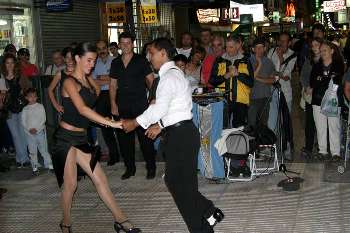
[Tango dancers take to the streets in Buenos Aires.]
Buenos Aires is definetely an amazing city! It is the ulitimate for a cosmopolitan lifestyle. People here love to dress up and look good. And boy o boy, do the people here look phenomenal. I am referring more to the women of Argentina. They are famous for being some of the most beautiful women in the world, and now having visited Buenos Aires, I would have to agree. I don't have any pictures, though; I usually don't go around snapping pictures of snazzy women walking around the city. I might get in trouble.
However, I did meet two cool girls today while I was eating lunch. They happened to be from Mexico, which was a nice change of pace from speaking to Argentinians the whole time. Argentines use many different Spanish words and have a very unique accent, which is the most difficult to understand of all the Latin countries we have been too. Anyway, these two girls were in Buenos Aires because they were on the "Fear Factor" show for Argentina, ha ha. That is pretty funny. One of them had already lost and had just had her last day on the show. The other girl was one of the finalists and was ready for tomorrow, the last day of the show. It wasn't a bad deal; they got flown out to Argentina, everything paid for, and the winner gets paid $10,000. Good luck!
Our days in Argentina have been pretty relaxing. I have been walking around Buenos Aires checking out all the shops everywhere. There is so much leather around it is wild. It is as if we were in Cusco, where all the people were ushering us into bars at night, but here we are given fliers and cues to follow people into their leather store. I didn't buy anything, but I can see why many people do. The prices are incredibly inexpensive. And talking about the cost being low, how about the Food!!!! Oh yes, the food in Buenos Aires is from heaven. I ate a meal with a prawn appetizer, glass of red wine, a selection of bread and mineral water, a main entree of a delicious filet mignon, and a chocolate fudge brownie with ice cream and some coffee, all for only $10. This was all in a fancy restaurant, too.
Our dollar is very strong in Argentina. About three years ago, they lost 2/3 of their own currency overnight. Because of this, Argentina has become extremely affordable for foreigners to come and visit. The economy now is doing better, and due to the low costs, there are tons of tourists year-round who come and buy merchandise and food and boost the economy. And now, since it is very difficult for the locals to travel outside of Argentina due to their dollar being worth less, they are travelling more within their own country, thus helping boost the economy.
If I were a city guy, I would love to live in Buenos Aires. It is a magical city. There are people in the streets dancing tango, people enjoy going out very late at night until the early hours of the AM, and there is always something to do. The people are very friendly, too. I give my thumbs up to B.A. You need to come and experience the famous Argentine steak in Buenos Aires sometime too, it is a real treat. Well, this is my last blog until I am in Brazil.
Caio,
Neil
P.S. - The team is starting to spread out. Nancy is on her way to Australia, and the rest of the team is getting ready to take up temporary residence in Brazil and Argentina.(N.O.)
| Logbook for February 23rd, Day 115 | ||
|
Start: Buenos Aires, Argentina S: 34*33.000 W: 58*30.000 |
Finish: Buenos Aires, Argentina S: 34*33.000 W: 58*30.000 |
Mileage: N/A |
February 24, 2004
Buenos Aires has proven to be one of the cheapest places on this trip and ironically a nation’s capital. Internet is often an indicator, and at 30 cents an hour, you can’t beat it. When we hook-up online, we often take our laptops because we use Outlook Express to write emails at the hotel, and it allows us to attach photos from the expedition. Usually the process goes something like this: We walk in, bust out the laptops and say “notebook”, or “laptop”, esta possible? They usually say yes and help you connect by offering you the LAN configuration numbers. Other times we just walk in, detach the phone line, check their computer in MS DOS for the numbers, and plug in and roll. Neil pointed out to Nick, Nancy and I that he had found a really large three-floor caf that had cheap Internet. We all headed down there, laptops in hand, and walked in. They gave us numbers for the machines, and we went our separate ways. Nick and I were near each other, and I was asking him if he can connect here (he’s a computer nerd and knows everything about them). He asked the attendant if he was allowed, and the attendant said wait a minute I will ask the owner. A minute later he comes back to say that the price to use a laptop would be 10 pesos per hour. Ten times the normal price! Not only was this the first time ever but also the most expensive ever. We didn’t really like that answer and requested to talk to the owner. The guy looked like a German immigrant or a Nazi in disguise, but was from Argentina. He was tall with a square jaw, scrawny and snippy. After trying to renegotiate the price by telling him we are nine people staying for 10 days and would use his service for hours a day each day, he didn’t seem to give. Nick then busted out the Drive Around the World for Parkinson’s story translated through the attendant who spoke excellent English. He was interested, and then Nick remembered that we were in the Buenos Aires Herald that day for our Expedition. We showed him the article, “270 days Around the World”. He fumbled through the words a little, smiled, and came off with a pleasant demeanor, but would not budge. At this point I suggested I’d find another place because it’s not worth the hassle. So, I left and went around the corner 30 feet away, where I was lured in by a sexy woman wearing a billboard that said “Internet 1 peso/hr.” I followed her and entered a tiny little hole-in-the-wall shop run by a young Indian-looking guy. He was very pleasant and even hooked up my laptop for me. Quickly I went back over to Nick and told him to abandon his efforts. He tromped back over with me, and as we left, some guy at the desk said I owe money. I replied, “Por que?” and walked out. Ten minutes of peaceful email checking went by, and then I randomly peered up through the window. Marching into the shop was Heiss and two SS troopers. He barged into the shop and started screaming at me in Spanish. I was so flustered that what Spanish I had learned got me nowhere here. He wanted me to pay for using the Internet. I was totally baffled and angry at the same time that I had little to fight back with. His words continued to fly and morphed into something about “Policia!” I said “fine, Policia por favor!” And he yelled OK and headed towards the door. At this point, Nick was becoming scared and exclaimed, “Adam don’t get worked up, just pay the guy. You don’t want to go to jail over this!” Of course I ignored him and waited for the next entourage of policia. Fifteen minutes passed, and no sign of him. Nick asked me to get Neil to call our shipping company for an urgent message. The problem? Neil was at Heiss’ caf. Regardless, I went over there. When I entered, the nazi came up to me and was yelling and demanding his money. Through the occasional moment of comprehension while the moronic English-speaking assistant looked on, I managed to gather that he wanted 1 peso for using the computer. He said that the meter started when we sat down, despite the fact that we never used the thing. I said that was his problem not mine, and then he hit the roof. At that point I had the assistant translate. In the end I was told to leave if I didn’t have any money. I left, went back to the small caf, and talked to Nick about it. From our brief discussion I learned that Nick had actually logged on while trying to configure his laptop computer, hence the Internet charge. So after all that I went through, and the surrender pleas from Nick, it was all his doing. Weasle!
For 14 days Colin and I edited together a video for Nick and ourselves in Buenas Aires and a few days in Rio. It’s a concise, five-minute piece that is plastered with “money-shots” and cheesy music. You can see it at www.drivearoundtheworld.com (click on “Movie” at the top).
Once we got started, Colin was a pretty hard worker…I guess he’s just got a bad starter motor. Now we have something to show different people. Recently, Land Rover has expressed interest in pitching the project to several channels and shows. We’ll see what becomes of that one pretty soon…
February 25, 2004
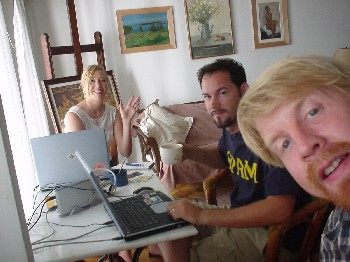
[Chanda, Nick, and Todd work from the comfort of their Buenos Aires apartment.]
This was catch-up day. Traveling so much and so quickly makes it hard to get all that needs to be done, done. There are several articles that I need to write, people I need to contact, stuff to update, and errands to run. Today, there was nothing on the official agenda, just a threatening to-do list. Already, Neil, Nancy, and Justin have left, leaving Adam and Colin here until Thursday working on film stuff. Nick, Chanda, and I will spend the duration of the break in Buenos Aires and the surrounding areas, which we are all looking forward to.
People in Buenos Aires live at a different side of the day than I am used to. Usually the nightclubs and disco techs close at 7:00 a.m., and Neil read at one point that it’s uncouth to show up at a certain Brazilian club here before 2:00am. This is tough for me, a morning person. As the hour gets later and later, my intelligence gets lower and lower. At about 12:00 p.m. or 1:00 a.m., I am a blooming idiot. Nick and I have been working at staying up later, although he needs no practice. The day dawned for us at about 10:30 a.m., and we hit the computers. I updated answers to questions and began to face the work that had been building up. After a while, Nick and Chanda rolled out of bed and began working on sponsorship stuff.
We are patiently waiting for our new Internet connection that will be coming on Friday, as then we will be fully resourced in order to prepare for the second half of the expedition.
We now live in a high-rise apartment on the 7th floor, Apt B (for Nick and Todd).
It is nice to live in a place for more than a day or two, and I am looking forward to exploring the neighborhood and the surrounding areas of Buenos Aires, which I have been very impressed with, so far.
This city strikes me, and I think it has been called the Paris of South America. The city is very spread out. In our part of the city, Palermo, we have a huge park, or a series of connected parks, where you can see people walking, running, or just hanging out drinking mate (a type of Argentine tea that is very popular). Wide streets run through this city, making crossing them very difficult in any other location than at a light. Some of these streets are even eight-or-more lanes wide. Of all the countries we have visited, this one seems to be the least Latin. If you were secretly transported here, when you awoke you would be convinced you would be in Europe, because even the Spanish language (Castelleno) is different then the rest of the continent. Well, more investigations will lead to more discoveries another day.
Driving here is crazy, although my only experience driving is sitting in the back of a cab (we bypassed the city on our way to the port). Despite the fact they have so much room, they use lanes more as general guidelines than rules of the road. They seem to straddle lanes and tuck their way in and out of traffic. There have been more than a few times when the car I have been riding in has been only inches away from the one next to it, moving at 30 mph down the road. Sometimes there are only inches on both sides of the car. Surprisingly enough, I have not seen many accidents.
Chanda and I had some errands to run today, so we were out and about around 9:00 p.m. We had to give Adam and Colin money so they could survive in Brazil (sounds rough). Actually, I was traveling as Chanda’s muscle. It is fun running around and doing errands. You always stumble upon something new, and there is always a reason to drink coffee, which we did.
We got to Adam and Colin’s hotel room, and they were getting ready to go. Colin still needed to get a steroid shot. The doctor in Chile prescribed this for the problems he has been having with his ear. Chanda, our team nurse, said she was willing to it. However, as she looked into the steroid package, there were a couple of different needles and vials and no directions. A little nervous, she thought it would better if someone else did it. Apparently that someone else was not me.
Moving on, Chanda agreed to go on a goose chase with me. I always like to look for Parkinson’s facilities wherever we go, and Buenos Aires no different. I found a group in Argentina off the www.wpda.org website. They had a chapter here in Buenos Aires, so I decided to track it down. All I had was an address, figuring it was going to be in an obvious place. We arrived at the address, but there was no big sign or anything, just a tall apartment building with a locked security door…hmmm... There was a panel of buttons I could ring to the individual apartments, but I was not sure of the number; all I had written down was 6-9. A young woman was waiting at the door for her mother, so we asked her some questions. She really didn’t know what we were talking about and knew nothing of any kind of Parkinson’s facility here. When her mother came down, she didn’t know what we were talking about, either, and looked like she just wanted us to leave. In fact, she wouldn’t let us in, so we had to leave.
We went down to the local Internet caf so that I could verify my information. Apparently what I had written down was correct, but I didn’t know what it meant. Six-9 meant Apartment 6 on the 9th floor. Armed with new information, we went back (only a few blocks). The same lady was there, looking kind of annoyed that we had returned (probably she is the type that just always looks annoyed). Again, she wouldn’t let us in, so we tried our luck at the brass calling panel on the front of the building. We rang what we thought was the correct room, but nothing…shoot!
I had one more address to check out, so we jumped into a taxi and headed across town again. Once more, we ended up at the front of a large high-rise apartment. We meet a few guys at the front door, in coveralls, and they quickly told me that the people we were looking for were on vacation and wouldn’t be back for another month…hmmm. Who was this guy, and why did he know that? He had a cement trowel in his hand and he was working on the sidewalk.
Two strikes, and we figured we’d have lunch,. Later that afternoon in my quest for running shoes, we needed to go back to the first area we were in. Shopper Chanda noticed that there was a Nike outlet there. After buying my shoes, Nick, Chanda, and I decided to give it another go at this apartment. As luck would have it, there was a fellow there that knew exactly what I was talking about. After a quick call, a shaky woman came down the stairs. After exchanging information, she told me that there would be a Parkinson's support-group meeting the following Wednesday at San Nicholas Debario Church. Great; we will see you next week.
This was terrific, as I was well on my way to finding more about the Parkinson’s community in Buenos Aires. She told me there were more than 60,000 people that suffered from Parkinson’s disease in this country alone; wow! We will see what next week brings. This is an interesting city; I look forward to learning more about the city, its history, the Parkinson’s Community, Evita, politics, and immigrant life in this booming metropolis. I am sure the Parkinson’s Community will offer a lot of insight into all of this.
February 27, 2004
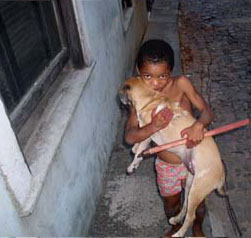
[A little boy whom Colin met]
Well, I guess I'm starting to get into the Rio vibe. I've been here for a while now, and I'm starting to feel at home. We've got our sweet little apartment near the beach, and I've been working my butt off during the day editing a promo video, but I still have a little time to explore at night. There's tons of live music here. Our first venture was to a live samba/bossanova club, which was really cool, and last night we went and saw what I guess is like a new kind of samba/rock/reggae hybrid band. The rocked. Halfway through the show they brought out a huge drum troop and two carnivale style samba dancers, you know with the feather headdress and all. It was very cool. A lot of the venues here have this interesting system where when you come in you get basically a check list, and as you drink and eat, they check off what you have bought. Then, at the end of the night, you settle your bill. I like it. Anyway, I'm having lots of fun, but I wish this video thing would be finished already so I could have some more time to explore.
February 28, 2004
Five days ago, I made a decision to fly to Brazil. Now, this decision wasn’t one of life or death, that’s for sure, but it was a decision that came with a great deal of uncertainty for me. First, I had not done my normal amount of research on a country to know what to expect. Second, I don’t speak Portuguese. Finally, I don’t know a single person in Brazil. I am quite accustomed to traveling to new places where I don’t know anyone, but it is exponentially more difficult when you don’t really know anything about the country or the language. This should be interesting…
Today is day 120 of the LONGITUDE Expedition, and the team has split up to the far corners of the earth for the next 6-7 weeks while our vehicles ship from Buenos Aires, Argentina, to Brisbane, Australia. More importantly, today is my first day of Samba lessons. I was presented with a great opportunity to start learning samba the other night while I was at Carioca de Gema, one of Rio’s smaller venues for live Brazilian music. I met the choreographer for the Mangueira samba school, and having just completed the rigors of this year’s Carnival festivities, she was more than happy to teach a few steps to a neophyte.
The samba originates from rhythms African slaves brought with them to the sugar plantations in Brazil, and it is the heart and soul of Brazilian music. Almost everywhere you go in Rio, you will hear samba playing in the background. I was quick to realize that Brazilians are passionate people and passionate about their music. The music of Brazil is that of a vibrant country, and the music reflects the complex mix of races and nationalities that make the people of Brazil who they are.
The samba is an amazing dance to watch. Feet are moving in a full flurry, while hips shake at a velocity that makes your head spin. At first sight, it is actually quite difficult to believe that a human can move that fast. When you break the dance down, it is actually a series of very simple steps that are repeated. For men, the basic samba is made up of only 6 steps. Even I, a 6’ 3” gangly gringo can dance this one, I think. The thing that worries me is the speed. Brazilians are taught to dance when they are children. So, most samba dancers you see have 10-20 years of practice on you. “Don’t be intimidated,” I was told. “Once you get the rhythm down, your speed will increase right away.”
Yeah, right…
After dancing to the first song, I was in a full sweat. After dancing the second song, I was exhausted. After 30 minutes of dancing, I was praying for death. But I am determined. One way or another, before I leave Rio, I will know how to Samba.
Until next time, I wish you all well from the far side of the world.
March 01, 2004

[ Above: The famous giant Christ overlooking Rio in Brazil]
Alright you all, I haven't written in a while, but what do you expect when you arrive in Rio on the last day of Carnaval!!! And because so much has happened and still is, I must summarize it all for you.
Justin and I left Buenos Aires on Fat Tuesday and landed down in Rio, Brasil, headed to Ipanema to stay at Rolf's apartment, and witness Carnaval's last hoorah! And what a spectacular evening, which started off with a "Bloco," which is a block party. And this is no ordinary block party, this is a bloco in Rio on Fat Tuesday, which meant that the streets along Ipanema were closed off to drivers, and were filled with thousands of people parading down the main street. It was an immense parade of transvestites and homosexuals, as well as percussionists and other musicians. It was helarious to see all the transvestites. They were all dressed up in the finest costumes they could conjure up. There were a few small floats, but mostly just people and musicians parading and singing Brasilian songs, while sweating and dancing like it was the last day on earth. We drank some caiparinhas, which is a drink made in Brasil with lime, sugar, and with a local sugar cane liquor. They are very strong and very delicious. So we had a blast watching and parading amongst the bloco for a few hours. It was similar to what I had imagined, streets filled with so many people that it is difficult to move, literally. We were there for a few hours and then the parade finally moved on out of our neighborhood.
After the parade, a local friend of ours, Erica, invited us over for dinner and made us Feijoada, which is a local Brasilian bean dish, and it was scrumptious. She lives in Le Blon, which is a very nice part of town, next to Ipanema. Erica is what you would always dream of a host being, super friendly, fun, and desiring to show you her country. I think that is the Brasilian spirit in general, very open and proud and always willing to show you a good time. She also told us of a great place to go later that night, which was called Monte Libano, an old country club turned into dance club, and this place was filled with over a thousand people dancing samba to a live drum troop up on stage. The stage was filled with 30 or so percussionists and a few other instruments as well. It was nonstop until the sun came up. I have never seen anything like it before, just intense samba and everyone dancing samba, everyone!!! The way these Brasilians move is heart stopping. There were some women up on pillars and on stage who had glittery carnaval costumes on and were dancing nonstop. It was amazing to see how long they can dance samba and not pass out. It is tiring to dance samba.
So anyway, in the following days, Adam and Colin showed up and Erica also brought us to her parents' beach house in Angra, which is a few hours south of Rio, and is breathtaking. The tropical foliage comes right down to the coast, which is littered with small islands. It is supremely scenic. She also brought us a few more hours south to a beach called Trinidade, near Ubatuba. And on our way back, she brought us to another gem, called Praina. Actually, Praina is only a 40 minute drive from Rio, so it was really crowded, but still fun and a great place to hang out for a day. The color of the ocean was pure blue and there were little huts on the beach you could get some food and drinks from. We chilled on these beaches all day everyday. It was very relaxing.
And to top all that off, Erica also brought us to Lapa, a town in downtown Rio which had live Samba and Bossa Nova! This is what I have always dreamed of, listening and DANCING to Samba and Bossa Nova, and we did this the last 3 nights. And of course, all the music is performed by live musicians, and is heavily drum dominated, so the intense rhythms and grooves are hypnotizing. We had some friendly locals teach us the Samba steps, and we haven't stopped since. It is an amazing dance, extremely fast and very fun. One girl told our friend, just do these few steps and keep practicing them for the next 12 years and keep speeding up, then you will be a samba dancer! She is right, the gracefulness and speed at which most of the Brasilians dance has been in their blood since childhood; I am envious.
So anyway, Rio has been a great time so far. However, the best part is that my parents just started a vacation to South America and we were able to meet up in Rio. It was really special to spend time with my parents in South America. We ate some really delicious food and saw some interesting sights in the city. We of course saw the grandioso Jesus Christ, which overlooks Rio. And we also spent some nice relaxing time on the beaches of Ipanema and Copacabana. Brasil has been even more than I had anticipated, and I am looking forward to the rest of our time here. I shall write again soon, as my parents and I are going to Iguazu Falls, which are larger than Niagra Falls! Imagine that.
Ciao,
Neil
(Click on description to view photo)
Let it begin. Justin boards Rio-bound airplane
Angra, South Brazil
Adam relaxes on the beach in Angra
One of Brazil's crowded beaches
Ah, a pristine beach
Rio, a city on a hillside
Brasil's metro
Rio's colonial-style apartments
Brazil's endless beach
March 02, 2004

[Brazilian colors in the sand.]
Feeling the affects of muscle relaxants for my bad back and overly sweetened black coffee, I’m rolling south with Neil in the back of a huge coach. We spent 14 days holed up in a rented apartment in Rio de Janeiro finishing the video and planning our next moves. Well, at least Colin and I were. Neil, on the other hand, delved into local customs by purchasing tank tops and shopping for a mystery item. This time he came home with yet another surprise: green Speedo trunks. They love them in Rio; 80% of the guys strut their stuff on the beach and sometimes through the streets of Rio. The other day I was sipping a capoirena (local liquor mixed with crushed lime and sugar) on Ipanema’s beach boulevard. Strutting by was a belly-toting man holding his shirt and trousers folded on top of his head. His shoes and socks remained in place, and so did what appeared to be a bright white pair of speedo trunks, but as he approached I noticed they were merely a pair of tighty-whities. So I assumed that this guy was taking a lunch break from work and decided to catch a few rays. Speedo or not, I guess nothing can get between a Marioca and his addiction to the sun.
March 03, 2004
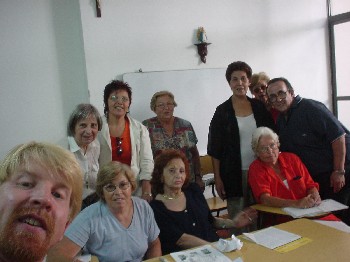
[Todd is welcomed to a Parkinson's Disease support-group meeting in Buenos Aires.]
As I mentioned last time, I have been conditioning myself to stay up late, trying to adjust to the Argentine schedule; however, today I had to be up early. We had tracked down a Parkinson’s Disease support group, so I planned on joining them today at their weekly meeting. The meeting started at 10:30am, and I arrived right on time.
There were about 10 people there, and more straggled in as the meeting progressed. The group asked me a lot of different questions, most of which I didn’t have answers for. People that show up at these meetings, I imagine, who do not have Parkinson’s Disease, are generally doctors, so they addressed me like I was a doctor. I managed to convince them I was a fundraiser, but our expedition is somewhat difficult to explain. People in South America have difficulty with the concept that we are soliciting donations per mile. They can’t imagine why someone would pay us to drive. What we are doing is creating an extraordinary event so we can refocus the attention from the expedition onto Parkinson’s Disease. Anyway, they asked me about the stem-cell research, what were the exact causes of Parkinson’s, and how they should go about choosing a good Parkinson’s doctor, all of which I really didn’t have answers for. I felt sort of helpless, getting all these questions for which I don’t know the answers. At times I thought they might think, “Why are you even here?” Anyway, I told them I didn’t know, but managed to share with them a few of my father’s experiences, and mentioned people I had met along the way, but I did say that I could look up the answers to some of their questions.
It was interesting to hear them talk. They talked about the many things that were now happening to them and their bodies. They also discussed how they could help other members of the community who were unable to come that day. They were all keen to the degrading effects this disease has on the body and the depression that runs parallel to these effects. One woman was asking about stomach problems caused by her medicine, another was asking about disjointed sleep habits, and another topic was about one of their fellow members who was dying of cancer. They all recognized the depression in this particular patient and were discussing strategies on how to help her. It was a fascinating meeting, and they invited me back for tomorrow’s meeting, where they will meet with a psychologist.
I was grateful that they let me into their world. Diseases like these are very personal things. We all try for so long to pretend that we are not different from everyone else, that we can make it on our own, that these diseases really don’t bother us. But is disconcerting to see the fear they cause in other people. The minute you say you have a certain disease, you can see the change of expression on the other person’s face. It is like all of a sudden you are different, and there is a wall that goes up.
It seems like a whole new set of fears spring up, for the person without the disease, thinking to himself, “Can I get this disease? Am I going to say something stupid that will be insensitive to this person? I really should know more about the disease, but I don’t. Do they suppose they know they are shaking? Maybe I should just ignore them. Yes that is what I will try to do--ignore it…ignoring it…ignoring...” And, finally, “Oh gotta go!” It seems like the thinking process gets so overwhelmed that the conversation is stifled and ultimately dies.
The person with the disease thinks, “They are kind of looking at me funny. Do they suppose the see something strange? Maybe I should change the subject. Oh, they look uncomfortable. Oh you have to go? It was nice talking with you.”
Maybe this is over the top, but often times there is a general uncomfortable-ness when a handicapped person or someone who is not deemed “normal” walks into a conversation. There was one woman at the support meeting who didn’t have Parkinson’s Disease, but her husband did. After being diagnosed, he moved back in with his mother, and has virtually not left the house in two years because he is too embarrassed. Some of this problem lies with the general public, and some of it lies within the particular patient’s perception. In any case, we all have to learn to accept these things, and to ask questions about want we don’t know about.
I have learned that the hardest thing about Parkinson’s Disease is accepting it. One lady I talked to went to 10 doctors before she even thought about accepting the diagnosis. The group told me that, after accepting it, they try to live in the moment and not in the future. Many victims of Parkinson’s get caught up in the future, what is to become of them. It is true that this disease will slowly debilitate your body, but they say you should focus on what you can do today, not on what you can’t do tomorrow.
I am happy that we are spending time here. It will allow me the time I need to get to know these people. These experiences are great! I have been learning so much through these wonderful people
When I got back to the apartment, I was both excited and exhausted. It is difficult to go to those meetings by myself, speak another language, and be a focus point. But the first one is always the hardest, and I am looking forward to going to the meeting tomorrow to see how these meetings are run.
I wanted to relax when I returned to the apartment, but there is still a lot left to do. I began walking towards Ricoleta, because I wanted to see Evita’s grave, but I got about a quarter mile and then turned around. I need to run some errands, and they have a way of taking longer than I imagine they should. I managed to purchase a bus ticket to Bahia Blanca, to see my friend Marcela. I met her in San Francisco when she was studying cooking and English. It will be fun to see her and meet her family. Stay tuned for that story in another journal!
March 05, 2004

[A Brazilian butterfly that stopped by to say "hello" to Colin.]
Well, I made it to Salvador, in the state of Bahia, and it’s great up here. We are in the city right now, but soon I’ll be heading out for some sweet beaches where I can string up my hammock, kick back, and relax. For now, we are enjoying the African culture and reggae music.
Today, I went to a crazy market with this guy from Chicago, John, with whom I’m sharing a dorm at our hostel. The place was crazy: miles of stalls and shacks full of so much random stuff. I bought my kid brother Charlie a slingshot to cause some trouble with, ate some random wierd sour fruits, and then had a hearty snack of assorted mystery meats that included a pig ear. You know, I always try to eat the local food when I travel, but sometimes I just can’t do it. That’s what happened with the pig ear; one bite and I’d had enough. Anyway, now I’m here, in an Internet cafe, writing in the blog, and I am finished, because the sun is setting and I am going to go watch it.
-Colin
March 06, 2004
Exploring Rio Niteroi, Garota de Ipanema, Copacabana, Beach, Fresco ball
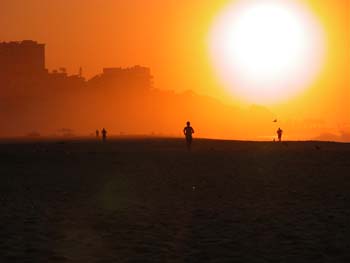
[Daybreak in Rio.]
Spending long lengths of time away from home in foreign countries is a liberating experience. You learn volumes about yourself—your likes and dislikes, and you learn to be comfortable without many of the comforts of home. You also spend a lot of time thinking about what your life is about. What are the things that make you happy? Were you happier before you started traveling, or have you found out something new along the way that will change you forever? Where do you belong?
Today is day 128 of the LONGITUDE Expedition, and I have spent the last 12 days adapting to my new “home” in Rio de Janeiro. I have often been overheard saying, “Home is wherever I happen to be standing at the moment,” simply because my life has always been full of travel. And, when you travel as much as I tend to, you really don’t become attached to any particular place as home. You think of the world as your home. However, this week I have decided to make Rio my home and spend my entire break away from the team in the Cidade Maravilhosa (the Marvelous City) with seven million of my newest friends. Escaping to Rio has always been a far-fetched travel fantasy for me, but I have to tell you that the real thing is much, much better. Recently, I read that the most beautiful cities in the world are Rio de Janeiro, Sydney, San Francisco, and Hong Kong. Rio de Janeiro was ranked number one. I believe they’re right.
Rio’s full glory starts early—around 5:30 a.m., when the sun begins to peak over the horizon. Its golden rays delicately illuminate this gloriously exuberant tropical setting, sandwiched between the mountains and the sea. As the blue begins to fill the sky, the sand on the praia (beach) starts to warm—anticipating the throngs of sun worshipers that will visit today. The streets are already alive with people jogging or biking, the beaches dotted with groups of people playing volleyball, and the ocean is alive with swimmers, surfers, and fisherman. Every morning in Rio is a good morning.
Today is no exception. The only difference, today, is that I am committing myself to a home for the next six weeks. I am signing a lease on an apartment. It is modest, of course. I have found a small studio apartment that is about 250 square feet two blocks from the ocean. It is nestled in between the boroughs of Copacabana and Ipanema—one made famous in a song about a girl and the other in a song about a club.
I’ve decided to stay in Rio to do some soul searching and to answer a few questions about myself. First, how will I fair living in the heart of a big city? Will I like it? I have lived in various forms of cities before, but never one this large. Second, how would I fair living in a foreign country by myself? Can I adapt? Will I be happy? I have often dreamed of taking up residency in another country, and this two-month break is as good of a chance as any to try it out and slip into a new life for a while. Maybe when this experiment is over, I will have a better idea about where my place in the world is.
Until next time, I wish you well from the far side of the world.
March 07, 2004
Buenos Aires is a fashionable city. In some neighborhoods, like Recoleta and Palermo, you can confuse the sidewalk for a catwalk. Women wear everything from DG to Prada and wear it well, as do the men. And why not? The local shops are chalked full of these amazing clothing creations at a fraction of the cost we would pay in the US---if we could even find them in the US. (Mental note...when going to Buenos Aires don’t bother with packing, just bring money.)
A matching outfit is a big thing here. Your shoes absolutely must match your blouse, even if you are just wearing a t-shirt. If you are a flip-flop wearer, you are in good company, and you have a choice of about 20 different colors to choose from. This is a good thing, because you simply must match. Really: no excuses for non-matching outfits here.
Another fashion curiosity worth mentioning is the matching underwear…never seen before as an accessory until now. If you are part of the low-rise club, that is you can wear the low rise jeans, shorts, or skirts with or with out your bum showing, you might as well make sure that your underwear matches the rest of the outfit. Who are you kidding--while wearing low-rise jeans, your underwear is going to show, if not while you are standing, then definitely while sitting--no matter how clever your descent.
March 08, 2004
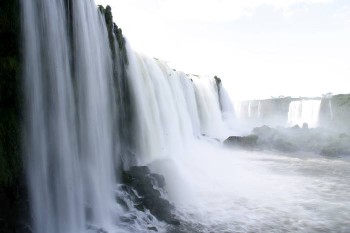
[Iguazu Falls, on the Argentina/Brazil border.]
Iguazu Falls. You really need to see these waterfalls up close yourself to know how impressive and powerful they are. These waterfalls define the border between Brasil and Argentina, and they are the finale of a river that is a kilometer-and-a-half wide! It is a pretty shallow river, which makes sense since it is over a kilometer in width, but when all this water culminates at the "Devil's Throat," one gets to witness the ferocity and untamed beast that mother nature unleashes in this majestic display of a waterfall. The Devil's Throat is only one of hundreds of the waterfalls of Iguazu, yet it is the most impressive. Thousands of people come from all over the world to a border town, of all places, to see this waterfall. In fact, my parents came all the way out here to see the falls, and I was fortunate enough to share the experience with them. People tend to steer clear of most border towns, but not this one. Foz de Iguazu is a beautiful town that is next to a nature preserve, which hosts the Iguazu Falls. And "Foz" is Brasilian for ?final? or ?end?, meaning the end of one river, and turning into another river, which is exactly what happens here. The Parane river turns into the Iguazu river at this point in geography, and it is a magnificent turning point.
These are also the falls that a scene from "The Mission" was filmed, with Robert DeNiro, I believe. Do you remember the scene where the main character must climb up the falls carrying a gigantic sack on his back? Well, those are another one of the falls at Iguazu. There are also many rainbows at the falls, created by all the mist that hovers around constantly from the pounding water. It is a very spectacular place.
My parents and I stayed on the Brasilian side of the waterfall the first night, which was amazing because, although they close the park to visitors in the evening, the one hotel that is inside the park, ours, was right smack dab in front of the falls. So we were blessed with the opportunity of seeing the falls for sunset and sunrise without tons of other people around. However, in the morning there were some other friends around, the coatis, and they were not fearful of people at all. The coatis are similar to a raccoon, but a bit cuter. They were scurrying all over the place in the morning, climbing guayaba trees, and filling themselves up. They are really used to people and will just walk on by you, not even budging or hesitating at any of your movements. Iguazu also has quite a few flowers, as well as butterflies, which you see flying around, and they have all kinds of different colors. The morphos, or the blue butterflies are my favorite, they are so brilliant and striking to see.
So, during the morning, we strolled around the Brasilian side of the waterfalls, and man, let me tell you, shooting photos of waterfalls is a difficult task. It is practically raining with mist 100% of the time, so you have to wipe your lens every minute, and keep your camera guarded from the water. So while shooting in the mist from the Brasilian side, you really get to see an interesting perspective of the falls. You are on top, across from the falls at one point, and at another, you are actually at the base of the falls when you get near to Devil's Throat. It is really impressive.
Then we headed over to the Argentine side, and walked about a mile over the river on a bridge to the actual top of the mouth of Devil's Throat, and WHOA!! That was definitely the most epic view of them all. You are standing on top of these waterfalls. These falls are larger than Niagra Falls!! This takes your breath away and puts you in awe.
We also went and saw many of the other falls, and it really is too bad we didn't have more time to hang out. It would have been nice to hang out there for a few days and really soak it all in. You can take a boat up the bottom of some of the falls and let the water nail you on the head. I talked to some people who did it and they said it was their favorite part of the Iguazu experience.
For me, one of my favorite experiences was being on top of Devil's Throat and watching all the water heave itself over the cliff into the cloud of white mist where no bottom could be seen. It was AWESOME!!! Right, Mom, awesome!!!!! My Mom told me that I needed to use the word awesome more in my journals, so here it is one more time, Iguazu Falls was truly awesome! Hee hee?
But the best part of all was being able to share such a scenic location with my mom and dad. We had a really good time together. We spent about 5 days together. We hadn't seen each other in over four months. They flew down to Rio, met me there and then we cruised to Iguazu. They are on a three-week vacation through South America, and luckily, it coincided with me being in Rio at the same time. Now that is awesome!!!!!!!
Until next time,
Marach 09, 2004
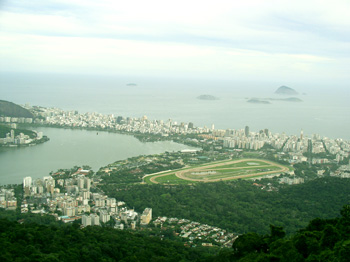
[A view of beautiful Ipanema from above.]
Our last night in Rio was spent neighbor fishing. It was 10 p.m., and Colin and I were sipping a few Antarcticas. From our 7th story apartment I could hear quite a fiesta blaring out five stories below. Of course it required a little attention, so I took my bed sheet and, contrary to Colin’s deterrence, I began tearing it into long strips. After about five minutes, I had a pile of red, heart-covered lengths. I grabbed another cold Antarctica from the fridge and tied it on the end of one strip along with a note that said in poor Portuguese, “a cold one for your party.” From there Colin, and I began making a long rope, and as I lured the drink out the window, Colin continued tying lengths to the fishing line. After a few minutes of weaving the can through various lines of laundry strung up by neighbors below, I managed to get the drink to hang outside the party window below. I took the gamble that it was the one on the right and began to swing the lure. Slowly it oscillated further and further back and forth until it eventually banged against the glass. At that point the window opened up, and screams of excitement came bellowing up from below. After a few minutes, the line was finally released, and with it was a reply. We hauled it up and it read in Portuguese “We are 8 cute girls, our names are…” and they listed them. We were on our way out to a samba bar, and so we thought we’d drop in and say hello, but by the time Colin and Neil motivated the fiesta had moved on.
Rio has an excellent nightlife, and with the recent discovery that our cars missed their boat connection in Panama, that meant another two weeks of Brasilian adventures. Rio is a relatively clean and beautifully situated city. Sheer, jungle-covered mountains drive upwards all around the city allowing for breathtaking views of Ipanema beach, a beautiful stretch of white sand that attracts sun worshippers from early morning Ôtil sunset. The old women hit the beach from 8 a.m. until about 10 a.m., when the college students start filling their days with sun. Despite complexion, everyone is dark here. There aren’t too many bulging muscle guys, but most are trim and are either juggling soccer ball in circles, playing smash ball (they love that game here and are quite good), or drinking caporienas in chairs. As for the girls, they come tanned and toned with thong bikinis. I guess it’s the new fashion. But contrary to the stories, there are no bare chests exposed here, because toplessness is illegal in Brazil. Culture booms from this city, and mesmerizing live samba, bossanova or jazz can be found every night, be it in the streets, clubs or small cafs. It really is all about the music and dance in Rio. Rio has now entered my favourite places on this drive, along with Cusco in Peru, and Costa Rica.
March 10, 2004
I've got my running shoes on, and I am off to see the city!
Jogging is a great way to get in shape. It is also a great way to see a new city, and it is a great way to get the brain refocused after sitting in front of a computer writing organization stuff for too many hours. Besides, if Nancy is riding her bike every day, I have to be doing something so that she won’t be stronger than me when we meet up in Australia! Having a car mate that is tougher than me--that would be horrible.
I began jogging, and I had myself quite an adventure. Generally on my first run after not running for a while, I like to start out slow, maybe twenty minutes of good, strong running and a ten-minute walk to cool down. I like to take it easy on my knees and not cause my body too much pain.
My exercise program all started out great with stretching in the apartment. I confided to Chanda that I thought it would be cool if I could do the splits; she said she could, and she could also show me how. So we stretched for a while.
After completing my stretches, and imagining being able to do the splits in another week or so, I set out down the elevator and off to the park for my run. We live in an area surrounded by parks, so it is a perfect place to get in shape. Running, running, running, feeling good, and feeling proud of myself, running, running, running, looking down and being proud of my new Ace Freely running shoes (if you saw them you’d know why Nick calls them my Ace Freely shoes).
I dashed through the park and began to cross a six-lane, one-way street. I was surprised to hear a car accelerate in the distance. Yep, this one was in the far left lane and accelerating towards me. As I ran across each lane, he tracked me, getting closer and closer. I kind of laughed and shook my head as I stepped back onto the curb to his honking about 20 yards away. “What is up with that,” I thought.
I continued my run down the street, past a house that looked like it was a part of Fantasy Island set, and onto the shoreline of a small lake with paddle boats. “This place is beautiful,” I thought, as I curved right, under a brick railroad bridge where something was being filmed.
The only problem with parks, lakes and windy roads is the fact you just don’t know where you are going to end up, and this is what happened to me. I thought I was headed back to the flat, but quite the contrary, I ended up running up a freeway ramp and ran right up onto the freeway. Figuring that I would be able to jump off fairly quickly, not really accepting the fact that I was on a freeway, I kept going. Unfortunately this took me past were I need to go and off into a new area with which I was unfamiliar. Generally having a good sense of direction, I figured I was headed the right way back; however, I was not recognizing anything. Despite this, I kept going, figuring that something familiar would turn up just around the next bend. At this point, I would jog for a while and walk for a while; I didn’t want to kill my feet with a new set of shoes, or at least I thought that was an adequate excuse.
Past the airport, past the golf course, and past a bunch of things I had never seen before, I ran. Should I retrace my steps and get back on to a familiar course? No, this was turning into an adventure...besides, I knew that at any moment I would realize where I was.
Seeing the river, I decided to follow that down south. It's the muddiest river I have ever seen, the mighty Rio de Plata, which brings the eroded tropical soil down to the Atlantic Ocean. Seeing the river, I knew I had to be going the correct way. I followed the river south, trying to find the huge street called La Libertador, which we live next to, but I couldn’t find any passageways leading to the right, where I needed to go. I was in the shipyards. At this point, most of the jogging stopped, and I was just walking. I had no money for a cab, if I really got lost, but my resolve and sense of adventure were still strong, despite the sunburn my shoulders were taking on. Things were just getting worse, and it made me laugh. I decided to tempt the fates, because I just didn’t believe things could get worse.
I walked up this wide street in which trucks were slowly travelling up and down, and I looked at the many different types of ships docked in the river. Am I really going the right way? Is this the river I think it is? How far should I go before I turn around? All these questions and many more were running through my mind. I also figured if I got mugged that all someone could take were my running shoes, and a sweaty pair of shorts and a tank top. I knew I stood out, as I was the only blond guy in the area, but my luck just had to change.
I kept going. Soon I found a place to make a right turn, but that only took me so far. After another 15 minutes, I saw a sign to Puerto Madero. “Uh oh,” I thought, “I went way too far.” At the first fork I could find, I took a right. Unfortunately, this was a freeway off-ramp! Not again! Where am I? I saw some road workers, so I thought I would ask them how to get back to Palermo. They looked kind of puzzled at me and asked me where my car was. I pointed to my shoes, and said I was jogging. I have no idea what they thought, but I knew that they felt a little sorry for me. At this point, I had been so fully committed to forging my own trail back, that I would have been devastated if I would have had to retrace all of my steps all the way back to apartment.
They looked sheepishly one way and then anther, and then they motioned to me to come over to a chain -ink fence. Two guys lifted up a stretched area in the fence and told me what I had to do. After climbing under the fence, I was now in the train yard. I knew where I was and what I had to do; however, I didn’t know what I would have to climb to get where I was going. Through the yards I went, running at this point, climbing a few trains, and speeding down the tracks. Pretty soon I saw some guys running toward me. I wasn’t going to be thrown out of here. I had to make to Palermo. I made it to a railroad bridge and up and over, across eight sets of tracks I went, losing my pursuers at some point. (Maybe they weren’t pursuing me at all????) Running down the edge of some buildings, I noticed an area opening up; I even saw some cars driving through. Was I home-free? I ran down this road, not really knowing if I was out of the train yard or not, knowing that I still had to cross two more sets of tracks. I saw a small little train building and two cops standing just outside of it. Was I supposed to be there, or not? Down the way I saw and older women walking towards me with a couple of shopping bags, just on the other side of the tracks. Apparently I had made it to a pedestrian crossing and was home free. Yes, Yes, Yes! I was back home within ten minutes, feeling quite proud that I had actually made it. A 20-minute run had turned into over a two-hour adventure. What was really funny was that Nick and Chanda were in exactly the places in which I left them, both sitting in front of the computers having quite a different experience than I'd had. I kind of felt like a character out of one of the Chronicles of Narnia books, returning to reality after a life-changing experience.
The rest of the day was quite uneventful after that. However, I especially enjoyed my dinner that night.
March 12, 2004
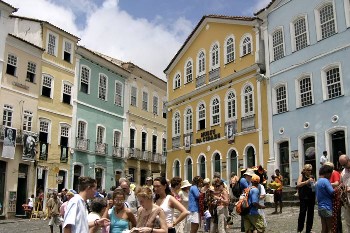
[The city streets of Salvador, Bahia, are crowded with tourists.]
Well, I'm still here in Salvador, having blast as usual. Adam and Neil have headed south to surf, so I'm on my own. But readers, don't fret, for I have met plenty of people to hang out with and occupy my time. John from Chicago, and I have been sharing a room, and he's a hilarious guy. He has some similar qualities to me as far as being an uncensored speaker, only he's even more unfitered than I am. Rob, from South London, is another crazy friend I've made, and It looks like I'll be travelling up north with him and his friend Lee, and possibly renting a house in a town called Jerico Quiaia, which I just horribly misspelled.
Yesterday John and I went with Marike and Sarah (Dutch and English, repectively) to the mall, of all places. I needed to buy a few things, but after 20 minutes in that oasis (kinda) of North American consumerism, I had had more than enough, so I beat it out of there ASAP. I spent the rest of the evening eating and wandering the cobblestone streets of Pelirinho.
It is, however, time for me to leave this place. The area we are in, which is kind of the most touristy, is pretty gross. At night, beggars work hard to rope gringos. I’ve adapted a new personality to replace El Gringo Loco , and that is Supergringo, so that when I or someone I'm with is being bothered, I tell them that I'm Supergringo, and they leave me alone…sort of. At least, they think I'm wierd and know that I won’t give them anything, so they leave. Laugh all you want, but it works.
Anyway, so, tomorrow night, which is Tuesday, is always a huge festival here in Salvador. I'm going to enjoy the live music of Olodum, one of the most famous drum groups in all of Brazil, and then I'm going to hop on a plane at 4:00 a.m. to go to Fortaleaza, where I am going to meet the English guys and then head up to Jericocioua, which is supposed to be remote, fun, and unbelievebly beautiful.
That’s all for now,
Colin
March 13, 2004
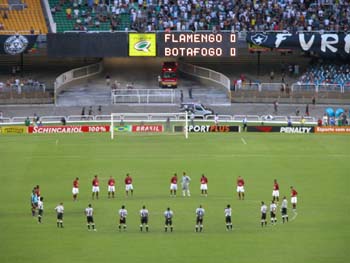
[Flemengo (red) and Botafogo (black) prepare to go head-to-head.]
There is one word that seems to have the ability to unite millions of people all over the world. It a word, when said properly can bring throngs of people to their feet cheering in an emotional frenzy. A word, that when spoken, is understood regardless of what language you speak. That word is gol. Or, perhaps more appropriately:
GOOOOOOOOOOOOOOOOOOOOOOOOOOOOOOOOOOOOOOOOOOOOL!!!!!!
Brazilian soccer, or futebol, is perhaps the most imaginative and exciting sport in the world. Complementing the action on the field are the fans. The stands at these games are filled with fanatical supporters who cheer their team on in all sorts of ways.
It is day 135 of the LONGITUDE Expedition, and since I am not one to miss out on participating in cultural ceremonies, today I entered the enormous temple of the sport, Maracan, to witness these modern-day warriors do battle for the glory of victory and for the love of their fans. Maracan is perhaps more revered by Cariocas than all the cathedrals and churches in Rio combined. It is also the largest soccer stadium in the world. This spectacle, for the uninitiated, is sheer lunacy. Fans singing, shouting and waving banners are accompanied by the sounds of huge samba drums beating rhythmically. It’s not uncommon to see roman candles or other larger fireworks shot off by enthusiastic fans during this athletic ritual.
Having been in Brazil for a few weeks now, I must admit that even I am somewhat addicted to the sport. As such, I have chosen a favorite team, and now it is my duty to scream like a lunatic, boo bad calls, and do everything in my power to ensure that my team emerges victorious. Today’s game is a classic battle between two neighboring barrios—Botafogo and Flamengo.
I am now such a dedicated fan that I have learned the Flamengo chants (more or less), so that while I am at the game I appear less of an outsider. It is better to be marginally accepted into the inner sanctum of the true fans than to appear indifferent to the teams playing, or worse, be mistaken for a Botafogo fan. There are other more practical reasons to this sudden injection of passion for a team I barely know. First is a matter of safety. Skirmishes often break out in the stands of these games. If there’s going to be a fight, I want to be on the side of the bigger fan base (more people to get involved while I get out of there). The second, and more truthful, answer is that the girl I have started dating in Rio is a die-hard Flamengo fan. So is her father. So was her grandfather. It really is a generational thing in Brazil. The last reason is purely selfish. Going to a game, any game, is more fun if you have a small stake in the outcome.
So, on this muggy evening, I experienced my first futebol game. And it was spectacular. The fans, the players, the night—everything was perfect, except for the score at the end of the game. Botafogo won 1-0. It didn’t bother me that I was running a low-grade fever and felt terrible. And truthfully, it didn’t bother me that the refs made some lousy calls and that we lost. I was participating in an event that is deeply rooted in history and is much greater than I am. For a brief instance, I was one with my Brazilian friends.
Before I go, there’s one thing about the game, or more appropriately, the stadium, that I don’t understand. Perhaps one of you out there knows the answer to this question.
Why are there pay phones located down on the grass just beyond the end of the field?
Until next time, I wish you all well from the far side of the world.
March 14, 2004
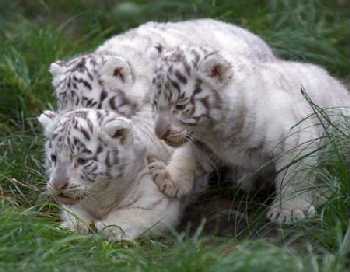
[White tigers at the Buenos Aires Zoo.]
Beautiful day. Went to the Buenos Aires Zoo. One of those days where you just don’t want to work.
Met a pack of furry cats. The cats are rare white Bengal tigers born at the Buenos Aires Zoo. They were named recently after a contest where hundreds of children submited suggestions. The winning names were Blacky, Lola, Luna, Manuel, Tomy and Rayitas (Spanish for ``Little Stripes''). Super cute.
March 15, 2004
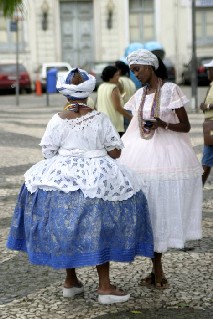
[Women in Salvador, Bahia, wear the traditional skirts. These traditionally clad women are known as Bahianas.]
Well, we decided to head north, all the way up to Salvador, Bahia. We ended up staying in the old colonial part of Salvador, called Pelourinho, which has been very built up in the last ten years for tourism. The town itself is beautiful, with brightly colored buildings and vibrant people and instruments everywhere. This is also one of the towns where slaves were bought, sold, and whipped back in the 1800's, so it remains a very Afro-Brasilian community.
I was a bit dissapointed at how Pelourinho has turned out due to mass tourism. It seems as if it has lost the natural charm and soul it once had. I met a lady on a bus who grew up in Salvador, and she told me how in the past ten years, it has changed completely, and they painted all the buildings, weeded out certain types of people, and geared it up for tourism. And because of all this tourism, you cannot walk around without people trying to sell you things, all kinds of things, from clothes to food to drugs to themselves. It is a bit sad.
However, there are still plenty of wonderful things to see and do. There is a massive amount of reggae, and one night we ended up in a favela, which is a shanty town, more or less, and it was filled with hundreds of people dancing to reggae music. There was also a reggae band playing in front of a house, vibrating with everyone surrounding them. It was a very tranquilo scene. At one point I noticed that Adam and Colin were the only whit- skinned people there. But color didn't matter; everyone was having a blast and dancing to the reggae music.
And of course, not only was there reggae, but there were people all over the place practicing capoeira. This is a martial art and dance that was created back in the slave days by slaves. They also perform this art to a very unique instrument, called the Berimbau. And also around town, were a few of the Bahianas, which are women dressed up in the old traditional Bahian clothing, which is dresses that are white and extremely large and wide. And yet another fiber of Pelourinho is the braids that women have. There are women in the streets with chairs set up to give anyone braids and extensions. And then, here too, as in Rio, there is quite a bit of samba and drum troupes in the streets. On all the street corners there were shops selling all kinds of hand drums. Throughout any part of town at any given moment in a 24-hour period, you can hear someone or a group of people beating on a drum.
Bahia is a place full of rhythm and beauty, and also of hardship. There are mass amounts of people who are extremely poor. And the sad thing is that public education is very poor in Brasil, and only those with money can afford to send their children to good schools. So the chance of someone who grows up poor staying poor throughout their life is very high. It is a huge problem and a difficult one to solve.
So, we ended up staying in the north for a few days. We also went to three different beaches for surf as well. None of the beaches had really good waves, but all of the beaches were nice to hang out at and eat some caldo do camarou, which is shrimp soup?mmmnnnn. And of course, those delicious caiparinhas are a treat.
Adam and I are headed way down south now, south of Florianopolis, to a town called Garopaba, where the surf is supposed to be outstanding. We'll keep our fingers crossed.
Pray for surf.
Ciao,
Neil
March 16, 2004
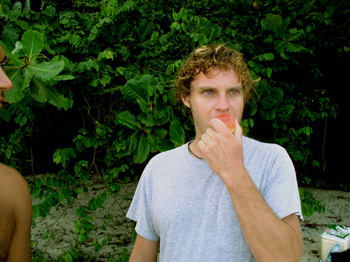
[Adam tastes the "forbidden fruit" on La Praia.]
We caught a flight to Salvador in Bahia (northeast Brazil), home of the Brazilian Rastas and Capoiera, the Afro-Brazilian Martial arts. I think we sort of followed Colin’s suggestion on this one. It turned out to be a pretty annoying place filled with drug dealers, raunchy hookers, and constant pestering from the street locals. Tourism had destroyed this place, and it was evident from the start. According to an old French fashion-shop owner, the place is now riddled with crack addicts that replaced the previous flow of cocaine. He proclaimed his sadness by telling me he was trying to get his young local girlfriend off of the stuff by sending for doctors from Europe. I looked at his face and realized despite his aged and experienced mind, he was nave when it came to the modern drug age. She was doomed.
In order to surf, Neil and I had to catch a bus for an hour outside of town. The waves were no good, so Neil and I bailed on Colin so he could enjoy the Rastas, while we evacuated south. We tried one small town, Olivencia. The surf was OK, but I got a mean sun burn, because Colin lost the new bottle of sunblock just before we left town. So, to add to Colin’s ever-growing list of lost items, we can put sunblock, an underwater spear-gun, his custom’s exit document from Brazil ($60 replacement), and the $3000 HP laptop computer lent to him by Nick and DATW.
Neil and I have decided to leave Salvador and head 20 hours south via bus back to Rio. From there we’ll catch a flight to Florionopolis, an island/city that is surrounded by surf spots and quiet beaches. Obviously Neil and I are trying to get in as much free time as possible before joining the crew back in Australia in April...
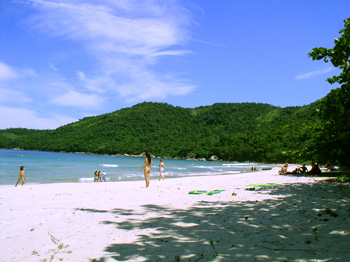
A secluded beach north of Rio.
...Later that day...March 16...
South of Florianopolis, Brasil
I’m convinced tonight I’ll find him. I’ve hunted the room from wall-to-wall and window-to-window, but regardless of his engorged and laden state I can’t find the little rascal. Last night I smashed his buddy and had two swings at him, but regrettably missed. Thinking positively, I went to sleep with the sheet over my head to prevent the buzzing in my ears, but accidentally left my right foot hanging out. This morning, while walking the beach with Neil on his morning routine of pulverizing surf, I noticed a trail of 7 red bumps from the big toe up to the ankle. The little bug sucked and walked inch-by-inch. Revenge? Perhaps, but I’ll get mine sooner or later. Tonight I’ve stuck a fan next to the bed, and am hoping that he’s still full. It’s been pretty mosquito-free in Brasil, until we hit Praia Do Roso, south of Florianopolis. It’s a small surfing town set up with a maze of dirt roads that weave in and out of the hills backing up to a few long, beautiful, white sand beaches. In the summer, this places rages as a surf/party town for tourists from Florianopolis in search of a little retreat, but right now it sleeps, really sleeps. You see a few people a day, usually the same ones, and the shops are open all day with no visitors. Regardless, it’s a pleasant stay. Neil and I rented a two-story house for 40 Reais, or $13 per night.
March 17, 2004
 todd teaching 1.jpg)
[Todd was invited to make a presentation at a school in Buenos Aires.]
Yesterday and today, I had the opportunity to go to Lincoln International School, located in a suburb of Buenos Aires called La Lucilla. This was an amazing experience! Yesterday, I visited a high school biology class and a couple of third-grade classes, and today I visited several high school science and philosophy classes.
This school is amazing. I began the presentations asking each of the students where they were from; Columbia, Israel, Canada, Italy, the United States, India, and Argentina were all represented. I was blown away. I told the students that our education program was focused on the geographically challenged people of the United States, and they all kind of smirked. I also said that we were promoting cultural awareness. I said that most people in the United States don't know much about other countries. I speculated that most people would think that if you were speaking Spanish, you were probably eating tacos as well. A student, kind of irritated, said, “We don’t eat tacos here!” I asked him where he was from, and he said the United States. At that point I asked him if I was unrealistic in saying what I had said, and he said, kind of embarrassed, that I was probably right on in my assumption.
At that point, an Italian student said that things were not much better in Italy. He said that people were not very aware of international geography and of other cultures. That took the heat off of the students from the United States and opened up a number of new conversations. Chanda and I asked students about life in Argentina and were surprised to hear that students stayed out until sometimes 7:00 a.m.; they could go to nightclubs and such, and it was ok. They didn’t seem to question their safety, as many of them had cell phones, and many families had accounts with remises (personal taxi services). Buenos Aires seems to be a fairly safe place, and people seem to live on different sides of the day. I can go to an ice cream place, like 31 Flavors, at 12:30 a.m. on a Sunday, and the place would be packed with people of all ages. On a Saturday at 2:30 a.m., I saw parents with young kids and teenagers and older people strolling the streets. It is truly amazing. I digress.
The presentations were fun, and the school was amazing! During the course of the day, I heard students switching between English, French and Spanish, almost flawlessly. I must confess that this is not a typical school in Argentina. Many people who work here from other countries send their students here, and some wealthy Argentines send their students here. The facilities were amazing, and the spirit great. I saw a poster on the wall which said, “The world would be a better place if we limited the amount of self pity to 1/2 hour a day.” I thought that was interesting. The students were interesting and engaging.
The teachers were also a lot of fun. There is a real circuit of international teachers. The teachers here are mostly couples from the United States and Canada. They all had stories of many places they had lived, and many of them had ideas of where they wanted to live next. It seems like most of them go from country to country just to check things out. Apparently there are annual international school fairs that recruit teachers from around the world to come teach. It sounds like an interesting prospect to me for future employment.
The reason we were able to give a presentation is we were invited by an American fellow who had just moved down here from New England. He has four kids, two of them in school. He read about us in the local newspaper, went to our website, and invited us to give a presentation at the school. His oldest child, Henry, was in one of the third-grade classes.
Before I did the presentation to the third graders, a number of them were in the library looking at the site. I felt like a real celebrity walking into the library. The students saw me and starting smiling and pointing.
“There he is, that is one of the guys,” he exclaimed. Henry walked over to me and said, “My father brought you here.”
“Yes, he did,” I said as I smiled.
We will definitely visit more international schools on our route. I was just great to see students face-to-face. I had the opportunity to give a talk about Parkinson’s Disease, its symptoms, and many of the trials that individuals fighting this disease face. These are they days that make all the hard work worth it; the heart definitely fills recharged, and I know that this is what I am supposed to be doing. Smiles.
Todd
Marach 19, 2004
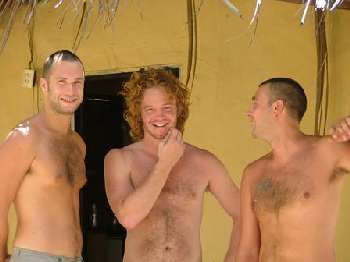
[Colin (center) enjoys beautiful Jericoacoa, Brazil, with new friends Lee and Rob.]
Well, I'm in a new locale, a small town called Jericoacoa. Its a cool little place surrounded by huge sand dunes and ocean. I'm having tons of fun. I've rented a house with two crazy English guys, Lee and Rob, an English girl, Beckie, and an Israeli girl named Jasmine. Tomorrow we are going to try and find a place right on the beach, but for now our crib is pretty sweet. Anyway, I think I can throw some new pictures up soon.
March 20, 2004
As part of my life in Brazil, I have started a new chapter this week. I am officially taking Portuguese lessons. Now, for those of you who know me, you know that I’m not really the type of person to go sit down in class for two hours a day to learn a language. I prefer my guerrilla-phrasebook tactics that have served me well all over the world. Rather than spend a couple of hours in a class with people who probably know less than I do, I would rather go to a local market and struggle through my interactions with the merchants, forcing myself to learn as rapidly as possible. I have found one thing to be true when you are in a foreign country that uses a different language: when you learn how to say something that is essential to you, you remember. Period. I don’t know why the brain works this way, but I imagine it is closely related to our sink-or-swim mechanism.
This is the second language I have studied so far on this expedition, and I know that soon I will be learning bits of Malay, Thai, Burmese, Hindi, Nepali, Mandarin, Uyghur, Uzbek, Kyrgyz, Kazakh, Nepali, and Russian. As the navigator, I frequently have conversations with people on the fly with three other cars waiting to hear what I found out. As such, my ability to absorb a language quickly has become paramount. While in Australia, I am spending time every day studying the essential things I may need to say or hear. I learned a lesson the hard way in Latin America. I knew for months that I would be traveling in Spanish-speaking countries, but with everything going on before the expedition departure, I neglected to study any Spanish. That came back to haunt me many times, and I stared at people blankly while trying to receive directions. In fact, I never even bought a phrasebook before we left. I will never go anywhere that unprepared again.
Volta a Portuguese…Portuguese, when written, is very similar to Spanish. And truthfully, as I thumb through my Portuguese/English dictionary, I am amazed at how many English words translate directly. Sure the pronunciation is different, but that’s the rub. Portuguese sounds very different from Spanish or English if you haven’t had any exposure. I am also finding that my Lonely Planet guidebook is correct when it says that, “most Cariocas speak little or no English.” I feel comfortable saying that ninety-nine percent of the time, if I can’t say something in Portuguese, I can’t get what I want. Similarly, if I can’t understand what is said back to me in an exchange, the lines of communication break down instantly.
Many of you are probably thinking that sign language or body language probably come in handy, and while that is true, I usually find that I feel dumb or that I am insulting the person I am talking to if I can’t keep going in Portuguese. You can only give the thumbs-up of “Tudo bem” so often before you just look like another grinning idiot who learned how to say one phrase before coming to Brazil.
So, determined to overcome my Portuguese deficiency, I have taken it upon myself to go back to school. Classes are four days a week from 8:00 am to 10:00 am, and I have 6 other people in my class. As it turns out, the studying I have been doing on my own (I currently own 4 books on learning Portuguese), combined with the pocket dictionary that I carry with me more (I actually carry it more often than my passport) have resulted in me learning a wealth of Portuguese. Granted, when I speak, it is all in present tense, but people understand what I am saying. And on a handful of occasions, I have actually been asked if I was Brazilian. Now, before you even have a chance to ask if I am kidding you, I’m not. And let me tell you why…
I have mastered the art of looking Brazilian. When I am in a conversation with a group of people, I look them in the eye and make all of the appropriate body language to indicate that I am listening and that I understand. I have also learned one other secret that is widely used by Brazilian men everywhere. When listening, all you have to do is grunt every now and then. When combined with an effectively timed, “uh-huh,” people have no reason to suspect that you are not Brazilian. It’s as simple as that.
Of course, it could also be this great tan that I’ve gotten here, too. Regardless, I will continue my classes at 8:00 am, four days a week, until I learn to correctly conjugate at least one word. I think I have enough money for that. Of course, conjugating one word requires learning 20 different variations of that same word. Good thing I have so much time in Rio.
Until next time, I wish you all well from the far side of the world.
March 21, 2004
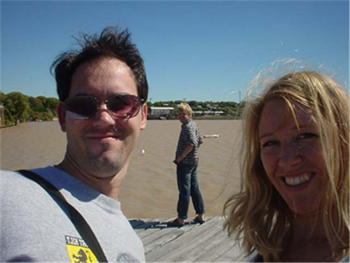
[Nick, Chanda, and Todd play near the shore in Colonia del Sacramento, Uraguay.]
Nick, Todd and I went to Uruguay for the day. A three-hour boat ride across the River Plate from Buenos Aires can get you to a little town in Uruguay called Colonia del Sacramento.
We left Buenos Aires without a clear plan. We decided to just wing it; I knew of a good hotel and had read about some good restaurants. The historical town is small; you could walk through it and stop for ice cream in an hour, so there is not much to think about planning-wise.
We arrived at 4:00 a.m. Although there were a few people out and about, the town was quiet and calm. We walked about 8 blocks to Posada Don Antonio and knocked on the door. Pablo, the owner, greeted us with a smile as if he was expecting us, and let us in. The Posada Don Antonio is a 200+ years old, fully restored, Spanish villa. Beautiful. And only $15 USD per night.
Colonia is a UNESCO historical site. It is a charming little coastal town dating back to the 17th century. Colonia has wonderful old Portuguese colonial architecture, sycamore-lined streets, cobblestone lanes, and the oldest church in Uruguay, the Iglesia Matriz del Santisimo Sacramento, which dates from 1699. We hear that there is an old bull ring worth checking out, too, but we didn't make it. The bull ring is the only one in Uruguay and apparently never used, as bullfighting was abolished shortly after the ring was built.
March 22, 2004
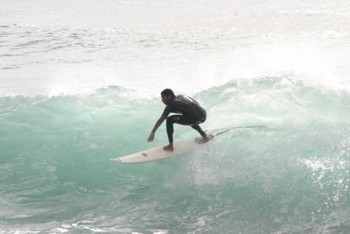
[Neil shredding it on the outrageous surf of Brazil. (The name of the surf spot is being withheld to protect the sanctity of the location...)]
Alright, this is Neil coming at you from Brazil on a beautiful cloudy day filled with epic surf!
The day started out in the early AM, about 5 a.m., to be exact, when the generous pousada attendant knocked on our door to wake us up. I told him the night before to wake us up this early so I could go walk up and down a huge hill for an hour to reach the surf before anyone else did. Adam wasn't feeling so hot; his back has been bothering him for a while now, and even though the surf has been helping his back, today he took the day off and decided to be a bro and take some photos of me surfing. We awoke and Adam grunted and moaned a few times before we grabbed our grocery bags filled with bananas, apples, crackers and water and headed out the door. It was pitch dark when we left. We actually took a bus to a different town than we are renting a house in right now because the swell picked up and there is a surf spot that picks up the swell and, quite frankly, GOES OFF!!! ("Goes off", for those of you non-surfers is surf slang for when the waves are epic, fantastic, unreal, dreamlike, or incredible.) This town is closer to the surf spot than where our house is situated. If I were to take the earliest bus from our house to the town that is an hour walk from the surf spot, I wouldn't arrive until 9:30-ish, and that is unacceptable when the crowds arrive a little after dawn.
So it was an hour before dawn, and we were walking up the dirt road to this great surf spot, and I was hoping to be the first one in the water. The walk was long but fresh and filled with biting mosquitos, soon to be called "mozzies" once we're down unda. A quarter of the way there, a car passed, and a big "darnit!" resounded through my head. I guess I wasn't going to be the first in the water; oh well. We finally arrived, and the surf was cranking, and to my amazement there were already 6 people on the bluff getting ready to go out. By the time I ate some bananas and apples and waxed my board, there were two people in the water. So I gave Adam the lowdown about my camera and told him to click away.
I headed out towads the point, which is lined with boulderous rocks that are slippery and encrusted with barnacles and moss. It is really beautiful and set up perfectly for waves. Unfortunately for me, I wasn't exactly sure where to enter the water, so I headed down to one section of stones that looked like a good place to try and jump in the ocean. Jumping in the ocean may sound easy; however, when you have waves smashing against the rocks and you have to time your entry just right in order to jump in as the wave is crashing on the rocks, it becomes a challenge. Also, part of the game is that you can't get too close to the water's edge when the waves are smashing or else you will get pummeled. So you need to wait for an opportune time, and rush down slippery rocks to the jump-off point before a set comes. Well, when I chose the moment to go, I rock danced down to the edge of the rocks, but there were still too many rocks just beneath the surface, and it wasn't a good place to jump in, so I had to turn around. But before I turned around, I was checking out another area to jump off from. A wave was coming in, and I thought I was clear of any danger, but sure enough, the ocean wanted to slap me in the face, so she crashed on the rocks and swept me off my feet and slammed me into the rocks. It all happened pretty quickly, and I stood back up and jammed back up the rocks out of harm's way. I felt fine, a bit shook up and angry with myself for being an idiot, but I wasn't hurt...well not really...as I looked at my bloody feet!! Oh well, I had a big gash on one side of my left foot and other pieces of fresh, gleaming flesh (tongue twister) shining into the sun on the backs of both of my feet, and one slice on the bottom of my right foot.
One of the nice things about surfing ist that if you get cut up by reefs and rocks and your board, you can still surf and not feel the pain and have just as much fun. So I looked at my wounds and laughed at myself, and also watched a few other people get in the water 50 yards up from me, so I saw the good entry point and headed over there. Once I was there, I waited for the right moment and scurried down the rocks and jumped in the water, simple and easy.
So I paddled out to the boil on the point and tried to get some waves. Now, I say "try" because the locals here are pretty cool and friendly, but they still own the surf spot and will paddle around you every single time and sit deeper than you no matter what. And that is cool, and to be expected, I am just a foreigner there for the day. Everyone has to pay their dues. And sure enough, I caught plenty of waves! The first hour-and-a-half was the best; there were no more than 10 guys out, and it was possible to get a fair amount of waves. Once 9 a.m. rolled around, it started to get more packed. It just becomes a fierce arena to get the set waves, and I don't really dig being super aggressive trying to get waves. I'd rather find a spot with fewer people. But I had a blast out there and surfed until I was exhausted, then walked in the blazing sun for an hour back to town. Not to mention, I had to wrap a plastic bag around my foot to keep my sandal from rubbing into my wound. It makes you feel alive, I tell you!
I could describe the waves and the day in even more detail, how it is right point break and hollow at the take off, and describe how the locals here drink mate too, and all the other subtleties. Oh, and how the sun sets beautifully and the local restaurants are empty, and the children are practicing capoeira, even doing flips, and young young kids are jumping off of benches having fun carrying their homework, etc. But, I will leave the pictures to describe many of these details for you. It is yet another day and time for me to go and be a part of it in a more pleasing way, mentally and physically, than sitting here reminiscing about past events in front of the computer screen. Oh, and I am sorry I didn't name the place I surfed. Some things are better left unsaid.
Ciao,
Neil
March 23, 2004
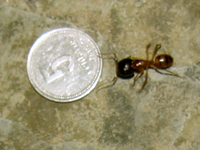
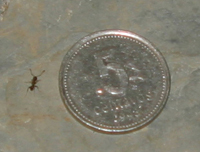
[A country ant (left) and a city ant (right) each have five cents. If the city ant steals the country ant's nickel, how much money does he have now?]
I’ve got a newfound interest in ants lately and confessed to Neil the other day that I could spend a lifetime analyzing them in all their differing forms. Or lets say if I were to wake up an entomologist tomorrow, I would choose them as my focus. In Rio, the sugar was extremely fine grained, and the ants were minuscule, absolutely tiny and jet-black. I drew the conclusion that ants had evolved to the size of sugar grain around the world, but Praia Do Rosa threw a wrench in the theory. The sugar is the same grain as Rio here, but these ants are among the largest I’ve ever seen and have legs so long and powerful that they belong on a spider. Their heads are huge and black, while their bodies are a wicked red. This flaw in my sugar-grain theory led me to draw a new conclusion.
The city ants have it really easy, and the need of such a machine-like body has become obsolete. Instead, they work in shear numbers almost effortlessly through your tiled sink crack, pouring through in throngs, invisible in size. Whereas; in the countryside, the terrain is a little more demanding what with dirt roads and wild animals. The lack of infrastructure offers less shelter, and so when it pours, these hybrid ants need long legs to hold their torso and massive heads above the puddles.
The benefit to these massive walking heads is that they take away that chunk of food by the sink almost immediately and single-handedly, while the city ants call in an army and work on it for a couple of days. For this reason, I have more respect for the larger brothers, whose ant trail consists of two or three workers. Obviously I’ve got time on my hands. Little is happening here other than relaxing days of surfing and the occasional email.
March 24, 2004
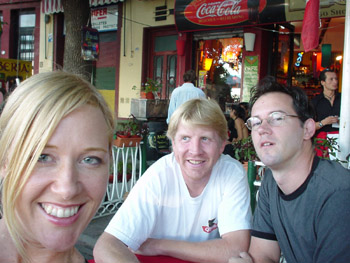
[Chanda, Todd, and Nick, out and about in B.A.]
Work was on the agenda all day today. Yes we are fairly boring here in Buenos Aires, working on Education stuff, sponsor deliverables, and generally anything that comes up. Nick, Chanda, and I are trying to get ahead of the game so the next half of the expedition will be a lot less demanding. We are certainly looking forward to all the upcoming sights.
I have been working on the educational pages, trying to get a better format that will be easier to use, and a more straightforward design in terms of navigation. After traveling for four months, I have realized the difficulties in keeping stuff updated from the road, and also what I have to do to get ahead of the game in the future. I have also had time to reflect on what has worked, what is confusing, and how I can improve the site. The education program is a lot of fun, but web work is extremely tedious.
In the mornings, I am usually the first one who wakes here; occasionally Chanda will wake up before me, but not usually. Chanda has been patiently waiting for her laptop to be repaired; a mishap with gravity has led to great agitation for her. She has to wake up before Nick in order to use his laptop; Nick usually gets up at about noon, as he is synched up with the workday in the United States, in particular he is synched with California, which is five hours after us.
Anyway, after five or six hours working on the computer, three cups of coffee, two cups of mate, and a Roquefort calzone, Chanda sprung me from this cyber jail. I am the Spanish speaker for all of us, so I get to go on all the cool and not-so-cool errands. Today we were headed to the American Airlines offices, trying to secure inexpensive flights to Australia for the team. The great thing about these errands is when I go with Chanda, we always get coffee and desserts; when I go with Nick, we either get coffee or a beer. Besides the treats, I think it is just nice to stretch the legs and check out this beautiful city. I am always up for the adventure, and I love quests.
Anyways, we started out with dessert; a nice lemon merrangue gave me enough juice to talk to the airlines. Unfortunately, American Airlines couldn’t help us out unless we were to fly through the United States, kind of a long way around to go from Argentina to Australia. They were sorry and sent us off to Lan-Chile and Qantas airlines, as they have direct flights. Unfortunately, the airlines keep more regular business hours than other stores. Oftentimes, stores close here in the afternoon for a siesta, and then reopen at about 4:00 p.m., at which point the stay open until about 9:00 p.m. Unfortunately, this was not true of the airlines, which closed at about 5:30 p.m. We got directions to the other airlines, but found them all to be closed.
There is a giant obelisk in the center of town. It looks a lot like the Washington Monument in D.C. A couple of weeks ago, we met a fellow named John who said there was a hostel here called the Lime House that was a lot of fun. Getting tired of hanging out with the married folks, I decided we should figure out where this place was. All we knew was that it was somewhere around the obelisk. We walked to the obelisk and started asking around. Once I ask more than two people, it becomes a mission to find whatever I am looking for. Much to our dismay, no one had heard of it. We started asking in the Internet cafs, frequent hangouts of travelers, but after two of them, we found no love. Finally, we ran into a fellow that sent us in the direction of a number of hostels, a couple of blocks away, but we still couldn’t find this seemingly fictitious Lime House. It was then that we ran into a Norwegian woman and guy from Saratoga, CA. After talking to them for about 10 minutes, we told them of our mission to find the Lime House. They said that the Lime House was just around the corner, less than twenty yards away. Having gone this far, Chanda and I ducked in to see what it was all about.
This place, although not very fancy, was great. It had a big common room where everyone could hang out, a pool table, and couches that various people were sitting in reading books. It was not hard to strike up conversations with fellow travelers, despite the loud music playing on the stereo, and before I knew it there were about eight of us in the front room playing guitars and chatting. There were people from England, Germany, South Africa, Peru, Australia, Ireland, and the United States. We all spoke English, and sometimes we would slip into Spanish. We had a ball just hanging out, being goofy, and swapping stories from all over South America. Talking to travelers is always fun and informative. Everyone has wild stories, and laughs are guaranteed.
Topics ranged from politics, the plummeting dollar, to travel spots, and making fun of each other’s countries. Chanda introduced the topic of birth order and found that the crowd was mostly made up of youngest kids, which in psychology is characterized by a do-your-own-thing, playful attitude. Hanging out with the young ones is always fun, sometimes much to our older siblings' dismay.
I began giving a guitar lesson to a Brit (British person) named Jo; we had a lot of fun just goofing around. Suddenly hunger struck, and people began to filter out for dinner. I had no idea what time it was, but I had caught the hunger vibe as well. Jo and I had to complete our guitar lesson, but we said we would meet up with everyone a little later. Chanda went home at one point, but I was having too much fun to leave. Apparently Jo and I missed the rest of the group but found another corner restaurant and had raviolis and grilled cheese. I am always surprised at the hours people keep here, because as Jo and I were walking home, I looked up to see a clock reporting 4:30 a.m.; I was surprised but then remembered were I was. The restaurant had just closed at 4:00 a.m. We got back to the hostel and things were still in full swing with at least half-a-dozen to a dozen people hanging out.
Jo is heading down to Patagonia, but she offered to let me take her guitar while she is traveling down south. Great, I hope she has a wonderful trip there, and look forward to seeing her when she returns. Soon after, I was on my home, with a guitar and another great evening under my belt. I love traveling!
March 26, 2004
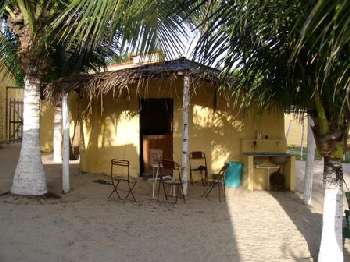
[Colin and friends have rented this house on the beaches of Jericoacoa.]
Ok,
Well, I know I keep talking about how I'm going to write this big thing about my first horseback riding experience, but it's just too hot, and I'm on vacation. I'll just say that it was tons of fun, and since then, I've been riding horses almost every day. In fact, when I'm done with this email, I'm going to go riding.
Lee and Rob(aka Dave) left this morning on a buggy going up the coast toward Belem. It was a sad departure, and I'm going to miss those guys. We had lots of fun together, many a joke was told, many a good time was had, and many a hammock was laid in. I think I laughed more in the last week than I had in the last four months of my journey. Now it's just me and Jasmine, the Isreali girl. Apparantly, John, the crazy American I met in Salvador is on his way up here, but who knows.
So now my main question is, where do I go from here? I really don't know what to do. I suppose I should fly down to Sao Paulo for a while and see my buddy Leo, one of the subjects of the film I made in Australia, or I could just go back to Rio and hang out with Erika and Duda, but 10 more days in Rio would be a little extreme, I think. I could also hang out on one of the islands outside Salvador for a few days and then go back to Rio. The Sao Paulo deal sounds like the best one, but I have a feeling it would be a little costly. Ah, I just can't make any decisions right now.
March 27, 2004
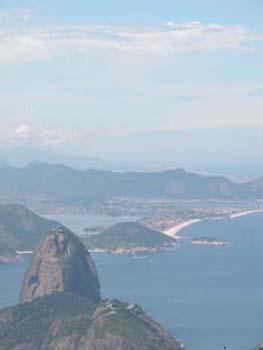
[Rio's famous Po de Aucar and beaches.]
Today is LONGITUDE Expedition day 149, and I have found redemption…Actually, I’ve finally found time to go to Corcovado to see statue of Cristo Redentor (Christ the Redeemer).
This famous statue of Christ with his arms outstretched has sat atop Corcovado (Hunchback) Mountain since 1931, and it is visible from everywhere in Rio, night or day. It is particularly impressive at night, simply because the way it was designed and lit: Jesus appears to hover over the city in the darkness, granting his protection and guidance to all Cariocas below.
After beginning my day by visiting the Flemengo futebol training camp (my new favorite team, if you remember), I borrowed a car from a friend and headed off to the Parque Nacional da Tijuca. The drive through the park and up the mountain provided ample opportunities to see not only the greener side of Rio, but also some spectacular peeks through tree lines to the city spread out beneath me.
Arriving at the base of Cristo Redentor was nothing less than amazing. Here I am face-to-face with the icon of Rio, a 30-meter tall sculpture of Jesus. His arms are outstretched, welcoming visitors from all over the world to the fabled beaches of Rio. In short, it is an awe-inspiring place. Immediately, you recognize the pose from postcards of Brazil, with the statue facing Po de Acar. To his right, you can see the Jardim Botnico gardens, Ipanema, and Leblon, while to his left the city expands beyond Maracan with the Serra dos îrgos Mountains in the distance.
Another sight from Corcovado is the collection of favelas, where the poorest four million of Rio’s population live. In a city that contains immense amounts of beauty and culture, it is difficult to imagine a group of people so destitute that they almost exist as a community of exiles. These shantytowns that blanket many of Rio’s surrounding hillsides have no schools, no doctors, and no jobs. What they do have is copious amounts of violence and drug abuse coupled with police brutality and corruption.
In spite of knowing all of Rio’s problems, when you look down on the Cidade Maravilhosa, you are immediately filled with a sense of peace. You are separated from the noise and pollution that accompanies every large metropolis, and you are alone with the city and her aura. Corcovado is a placed revered by all Carioca’s, and it is only after visiting it that you feel Rio. It is then that you began to understand a small portion of the Carioca’s spiritual fibre.
In my time in Rio, I have had the opportunity to meet people of every different class. I have met poverty-stricken families that live in apartments the same size as some peoples’ closets, and I have met Brazilian celebrities from an Oscar-nominated film, and what I learned is that every person, regardless of his or her social status, cares deeply about Rio, about Brazil, and about other Cariocas. The rich regularly give to the poor, and the poor regularly give to the poorer, because the social infrastructure does not exist to provide assistance to those who need it.
So, more than I have seen in other places of the world, the people are looking out for the people. Through a conscious choice, they are all linked together as a community, and many feel guilty for having an easier or better life than the others. Sure, less help is given to those who have self-inflicted problems, but for those who simply have not had the opportunity to make a better place in the world for themselves, the others are there helping, even if only in a very small way.
The Encarta Dictionary (it’s the only one I have available right now) defines redemption as, “the saving or improving of something that has declined into a poor state.” Whether it’s the Carioca way to make up for the gluttonous celebrations they have, the governmental deficiencies, or something more personal, it seems to me that Christ the Redeemer is the perfect role model for the city, and perhaps Rio is a good source of inspiration for us all.
Until next time, I wish you all well from the far side of the world.
Marach 28, 2004
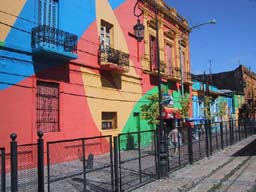
[More than 100 years ago, at Barrio La Boca's start, the residents painted their homes with bright paints given to them by the shipyards. The bright colors are still used today.]
With little resistance, Nick, Todd and I broke away from the chains of the Ethernet and spent the afternoon in La Boca.
La Boca is one of Buenos Aires' best tourist attractions. In the 19th century, when scores of Italians immigrated to Buenos Aires, some settled in La Boca barrio (neighborhood) and began a colorful tradition that is still carried on today. La Boca is a port city and there are many fishing boats and ships. One hundred years ago, for economic reasons, the residents of La Boca used left over corregated metal from the ship yards to build their homes and also used the excess paint from the ship yards to paint them. The ship yards sold them many bright and colorful paints, all of which were used by the residents. The neighborhood quickly became one of the most colorful neighborhoods in the world. This tradition is still carried on today, and at some point La Boca become a major tourist spot. Being tourists, we we grabbed our tourist gear----cameras, sunblock, and map---and headed out to see La Boca.
We happened to visit the barrio on a soccer game day. La Boca has their own team and thousands of proud fans. We saw some of the more zealous fans on the streets as we entered neighborhood---it was easy to spot the decked out fans in blue and yellow Boca colors. The stadium is just two blocks from the touristy area where we were, so we could also hear the game's high and low points. Boca fans take the game very seriously and have been known to go a little crazy after a game. In fact, our afternoon in Boca was cut short when the soccer game ended. At 3:00 the shopkeepers, cafes, and restaurants closed up quickly around us minutes before the fans---defeated or victorious---flooded the streets. We were sitting at an outdoor caf, enjoying a cup of coffee, when our waiter packed up all of the tables and chairs and offered us a cab ride home. We reluctantly took the cab offer. Would have loved to hang out there a little longer just to see what happened.
La Boca won, by the way.
March 29, 2004
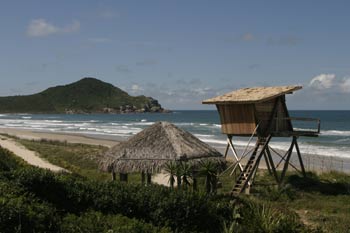
[A cyclone south of where Neil and Adam were surfing in Brazil made the surf on their beach outstanding.]
We are on our last week in Brasil and our friend Erika from Rio showed up to spend a few days with us. Adam, Erika and I have been going to the beach, walking around different areas, and exploring the terrain. All the walking is a bit difficult for me right now since my feet are torn up, but oh well. I am still surfing, but not as much, since I am trying to heal my wounds. Unfortunately, since they are deep, it will take many consecutive days, if not weeks, out of the water until they completely healed. The beaches around here are so beautiful, with green trees everywhere and white sand beaches lining the coast.
We are in a smaller town, renting a nice house, and we buy most of our food from the market and have breakfast at home. For lunch, we have been eating at this all-you-can-eat buffet. They prepare fresh fish or beef for you upon request, and then you have your choice of all kinds of various salads and vegetables, among rice and potatoes and beans, etc. And all this for 9 Reals, which is $3 in the U.S. Erika also made us some great pies too; one apple pie and one banana pie, mmmn, that was a treat.
And of course, the surf has been great, too. Unfortunately for people down south, there was a cyclone that destroyed many houses, but we were far enough north to receive the swells from the storm and benefit with great waves. We really got lucky the past few weeks with the surf. It usually is flatter during this time of year.
Well, this is a short journal entry, as we are just chillin', playing guitar, and enjoying our last week in Brasil. Adam and I are flying to Chile for a week before we head to Australia to meet the team. Until then, Ciao!!
Neil
March 30, 2004

[Neil and Adam enjoyed the beach and the waves in Florianopolis.]
Today Erica, our friend from Rio whom we met through Rolf, came to visit us down here for the weekend. It’s funny really how we all became acquainted. I guess Rolf, the writer who was with us, has a few published books out there. One of which is “Vagabonding”, a travel guide for the major budget traveler. Well, one of his fans wrote to him when she read in his daily online “blog” (online journal). He talked about going to Brasil for Carnival. She told him to contact her friend out there who lives in Rio. So Rolf dropped an email to Duda. Duda got the email and said to her roommate, “Hey I got this email that says, “Hey I am a friend of one of your friends, and I’m coming out there, would you like to meet me?” Duda was pretty confused and said to her roommate, “Do you want to meet this guy, Rolf, I don’t really know who he is and I think I will go away this weekend?” Erica said. “Ok I will meet with him.”
Rolf shows up to their house and brings a friend with him. They meet the two girls and then leave after a week of Carnival and hanging out with Erica. Soon after this, Rolf gives us her phone number and says, “Hey you can call my friend in Rio; she will show you around”. We call her up and say, “Hi, we are a friend of your friend Rolf” and later meet. She was extremely nice, and over the period of a week she showed us many different parts of the city and various night-spots.
One night we decided to cook dinner for the two girls and their neighbor. Over the table, it was revealed that the girl who originally sent Duda an email was just an American girl that met her once or twice during Carnival the year before. Erica didn’t know her, she didn’t know Rolf, and here we were sitting at their table thinking we were cooking for a friend of Rolf’s. So, although those sitting around the table had no connection with each other, we all spent a perfectly good week together, and Duda and Erica turned out to be very helpful and considerate. We saw a Rio and some of Brazil that other visitors would never see, the streets of the Lata, fountains above the city, and hidden beaches north of the city.
April 02, 2004
I am a wuss
I've done it. I am officially a travel wussy. Out of pure laziness I guess, I went and bought a package tour. I think it was just because I couldn't be bothered to take the 25-minute bus ride to the bus station to buy a ticket to Lenois, home of Chapada Diamanta, a huge national park. Anyway, I was at the travel agent buying my ticket back to Rio, and discussing what I might do for the rest of my time up here in Salvador, and he sold me on a three-day package with tours in the park, bus fare, and hotels. He also pointed to a few people my age in the agency and said that they were going on the tour too, dispelling my thoughts of spending three days with old farts.
This kind of goes against everything I stand for, but hey, what the heck, you only live once, and a twenty-five minute bus ride is a pain in the butt. It was cheap, anyway. The park is supposed to be amazing, so I'm looking foward to getting some great pictures.
So, that solved my dilemma of what I was going to do with myself. I leave in two hours, and I'll be there for 5 days. Then it's back to Rio and onto Oz.
April 03, 2004
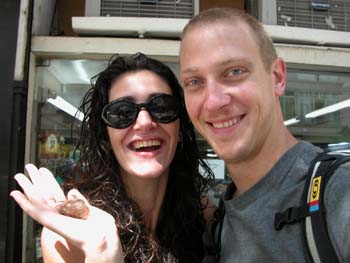
[Justin shows off his new haircut on the streets of Rio.]
Welcome to day 156 of the LONGITUDE Expedition—I am bald.
Well, almost bald.
After weeks of deliberation, I have decided to do something some may consider drastic: shave my head. Now, I didn’t go all the way to skin, simply because I have one more week in Brazil, and I hope to get at least another day or two at the beach. Plus, I think if I shave my head, I would quite possibly be the most frightening gringo these Brazilians have ever laid their eyes on, and I wouldn’t want to subject them to that type of fear after they’ve been so nice to me.
Many of you are probably asking, “Justin, why on earth would you shave your head?” And you know, that would be a very good question. I’m not sure if I have a very good answer. But I’ll try.
Here’s the public relations answer:
Before I left on this nine-month expedition, I conducted a simple survey among my friends and family. The choices in this survey were very simple: should I grow my hair out the entire length of the expedition, or should I shave my head? The reaction to this survey was overwhelming, and the responses received made for a very close race in this matter of utmost importance. But in the end, I had to support the decision that was made by the people. It was decided that I would grow my hair out the entire nine months of the expedition.
Flash forward forty-six days, 8 hours, and some-odd minutes. I was sitting down in a barber chair in a strip mall in Panama City requesting a haircut in broken Spanish. I hated to let all the people back home down, but I could not stand to let my hair grow out one more day. The truth be told, I really did want to grow my hair out the entire length of my travels, but due to high temperatures and even higher humidity levels, combined with the need to look presentable for various speaking engagements along the way, I decided I had to get a haircut.
When the stylist was finished, I decided my hair looked better before I sat down.
Come forward with me another 110 days and another two time zones, and you will see me sitting down in a barber chair very similar to the one in Panama City; however, this time, the instructions are given in Portuguese instead of Spanish, and fortunately, they were much simpler. “Shave it off, por favor.”
I had decided that since I had failed those of you who voted for me to grow my hair out, I would give the other group their chance as well. I thought this way everyone comes out a winner.
Additionally, the team will be camping a lot more in Australia, which means I’m not going to be showering as much. Plus, it will be hot in the Outback and very humid in Southeast Asia. Hot equals sweaty, and humid equals gringo-fro. Not good for public appearances. Once again, I must do everything I can to represent the organization properly.
Are you buying all this? Okay, here’s the real answer:
Someone asked me to do it, and I said, “What the heck?”
So, I hope you enjoy the picture of my new dome. It doesn’t look as bad as I thought it would (now that it’s growing back in), and it’s definitely better than my experience with the Panamanian coiffeur. Besides, I think I’ll fit in better with the monks in Tibet this way. Maybe I can get a special on one of those robes…
Until next time, I wish you all well from the far side of the world.
April 05, 2004
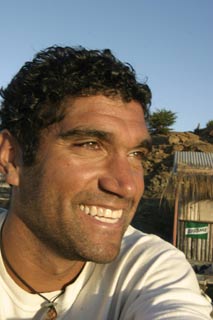
[Surfer Neil can't help but smile while taking in the beauty of Pichelemu.]
So I have left Brasil, boo hoo:((((((( Brasil was the coolest country I have been to so far. The people are so friendly and full of life. They also are very passionate people and love their music, which is so fun to experience. Listening to Bossa Nova and Samba, dancing, and eating great food and tasting delicious blends of tropical drinks, like acai and guarana, is just paradise. And then being able to explore the coast and surf is a dream as well, not to mention the fact that we got a cyclone swell while we were there, which is literally unheard of in Brasil. It was the first cyclone they have ever had. Brasil was everything, and much, much more than I had ever anticipated. I am definitely going back.
So now I have flown back to Pichelemu, which is on the Pacific Coast of Chile, where we as a team spent a night during our drive down through South America. Adam and I caught great waves that time, so I was hoping that when I returned, I would get some more great waves, as the time I am returning is the beginning of the south swell season. So, as I was looking at the satellite images over the last week, I saw a large period swell moving toward the coast. So I was expecting some good surf. And now that I am here, good is an understatement. I am scoring right now! It has been double-overhead a couple of days and solid 6-8 feet the rest of the time. AND, unlike the last time we were here, there are only a few people in the water! In fact, one session I had, I was completely alone in the ocean surfing solid 8-foot waves for 300-400 yards.
I am staying in the town of Pichelemu, but actually taking a bus for 15 minutes in the morning to Punto de Lobos, where the surf is bigger and more powerful. You can rent a place in Punto de Lobos, but it is more expensive. Pichelemu is a nice town to sta, with all kinds of little restaurants and shops around town. There is a park overlooking the ocean and also a very large beach for people to enjoy. They even have a small track for small ATV's for children to enjoy on vacations. It is closed right now, but when Easter hits, the town will fill up and everything will be open with food and merchandise to sell. I even saw a man taking a llama out of his pick-up truck, getting ready for the Easter weekend. There are also men who have horses with carriages for people to ride around town, although they?re empty right now. Easter is an immense holiday and I am sure they will fill up soon for the holiday.
Being back in Chile is nice, and the surf is great. I surfed for many days and it was fantastic, but now my feet are really hurting and not healing, so I must stay out of the water and let them heal. But even as I sit on the coast and watch the waves instead of surfing them, I still have a smile on my face, chilling and relaxing amongst the beauty of the Chilean coast, while I remember all the good times I have had over the last 5 months of our epic journey. And also to wonder about the times ahead of us, as we are about to embark on the most thrilling part of our expedition yet.
Hasta Luego,
Neil
April 06, 2004
I decided to take the last ten days of our departure from the cars back in Chile. Yesterday was my birthday, and I spent it rather peacefully here in the second largest city of Chile, Concepcion. I found myself wandering the streets with a couple of people I met in Pucon, Chile, when we drove through the country two months ago. This city is rather banal and holds very little for any architecture whatsoever. Sort of a characterless urban sprawl. This scared me since it boasts being the second most important city for Chile after Santiago. But my company here with two very warm and entertaining Chileans is some of the best I have had on this entire trip.
It’s been a rather luckless week. The busses here make a game of drenching people with massive muddy street puddles during downpours, as I found out during one umbrella walk. I was completely drenched from head to toe in one massive dark grey wave of gutter water. We’ll see how the rest of the week goes…
April 09, 2004

[Grasshoppa, you must depart Brazil and fly away to Australia...]
So, my trip in Brazil is coming to an end. I've returned to Rio, and I am once again staying with my good friends Erika and Duda. Had a leisurely day yesterday, hung out on the beach by myself for a while and read half of Swiss Family Roinson. I spent today running errands, such as picking up my plane ticket to Australia and mailing a bunch of things home. I think tonight we are going to a big samba concert thingamabob, which should be pretty cool. Anyhoo, I guess this is it for Brazil. If anything else extraordinary happens in the next twenty-four hours, I'll make sure to record it here.
April 10, 2004
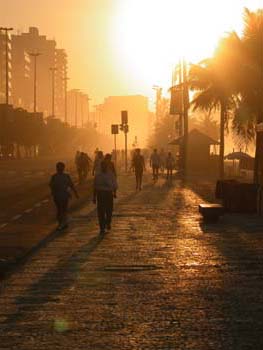
[Just like the sun will continue to rise over Rio, so must Justin continue to trek across the globe.]
When one thinks about traveling around the world, one conjures up all sorts of images of exotic locations filled with unique, interesting people and experiences that will make the most timid travelers spring to life and learn more about their world and themselves.
I am here to tell you that all of that is true.
But after traveling for more than four months non-stop, I can also wax poetically about the hidden drawbacks of long-term world travel. Most of the time, I keep these bits of information carefully hidden inside my head, because I think the fantasy of travel is something that must be held onto by everyone. Travel is something we need to aspire to for numerous reasons, each one usually being as unique as the person who has the aspirations. However, eventually you reach a point in your travels, an emotional pinnacle of sorts, where you must let some of your personal emotion free in order to maintain order in your psyche and continue down your chosen path in life.
Today is day 162 of the LONGITUDE Expedition, and I am on a 31-hour flight from Rio de Janeiro, Brazil, to Brisbane, Australia. I am excited to land in Oz, to see a place I have dreamed about visiting since I was a small child. And at the end of this leg of the journey, one of my travel fantasies will spring to life before my eyes. But I am filled with saudade. Saudade is a Portuguese word for which there is no literal translation in English. It is a combination of emotions sandwiched somewhere between longing and remorse. I have consulted with many people on how to properly translate this word for everyone, and at each turn I come up with the same response: it doesn’t translate. It’s just something you feel. So now, as I bounce from Rio, to Sao Paolo, to Santiago, to Aukland, to Sydney, and to Brisbane, I have 31 hours in a middle seat to dwell on my thoughts and sort through my emotions.
And I have come to one conclusion:
The unfortunate truth of world travel is this: you’re always leaving something or someone that you care about behind, and no matter how much you travel, it never gets any easier…
Until next time, I wish you all well from the far side of the world.
